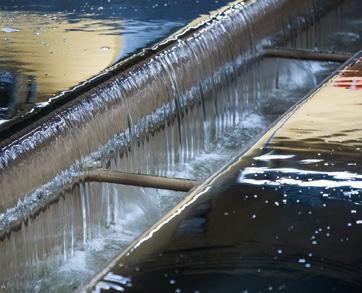




In an era where innovation marries environmental guardianship, our journey toward securing sustainable water resources unfolds as an engaging tale within the broader narrative of human progress. Charting a course through proactive engagement, we witness the water sector’s evolution towards a realm where sustainability and efficiency are not just ideals, but achievable goals. Central to this shift are the visionaries and innovations poised to transform the threat of water scarcity from a looming inevitability into a conquerable challenge.
This issue of Smart Water Magazine sails the critical currents of water supply, spotlighting desalination as a key beacon of hope. A curated selection of exclusive interviews, reflective essays, and in-depth investigations probes the pressing challenges and pioneering solutions shaping this domain.
Our lead story features a conversation with Saroj Kumar Jha, the World Bank Group’s Water Global Practice Global Director, who sets the thematic compass for this edition. Jha highlights the critical need for augmenting public funding with private capital to meet the vast global demand for water. The World Bank’s extensive US$28 billion commitment to water initiatives exemplifies the essential blend of innovative finance, institutional ingenuity,
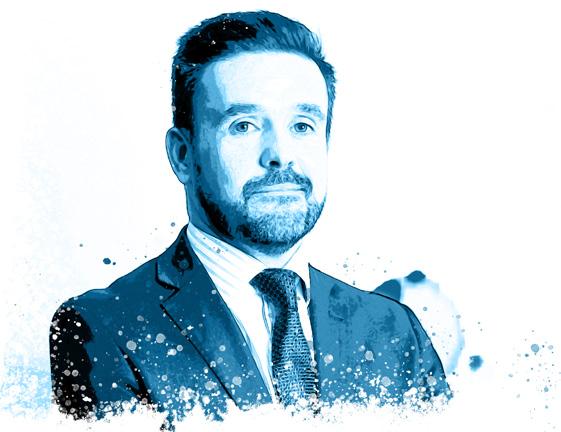
and knowledge dissemination required to navigate today’s water challenges.
Delving into India’s Jal Jeevan Mission (JJM), Fredrick Royan showcases it as a testament to the transformative power of smart water technologies in forging sustainable paths forward. JJM’s success in harnessing data-driven approaches reveals the game-changing potential of tech integration, from IoT platforms to advanced monitoring systems, in reshaping water distribution networks.
Michael Lesniak offers insights on Taiwan’s strategic countermeasures against water scarcity, illustrating how investments in desalination and water reuse not only address immediate needs but also pioneer strategies for protecting water-reliant industries against future adversities, notably in the semiconductor field.
Meanwhile, Aitor Alava, Managing Director at Natixis CIB, explores the dynamics of financing water infrastructure in Latin America. His analysis emphasizes the pivotal roles played by stable regulatory environments and inventive financing in fostering water project developments, with an accent on desalination and water provisioning as essential endeavours.
We invite you to dive into the stories and discoveries shared within these pages, pondering the collaborative endeavours required to surmount the water challenges of our era.
Thank you for embarking on this critical journey with us.
AlejAndro
CONTENTS NUMBER 21 - MAR/APR 2024
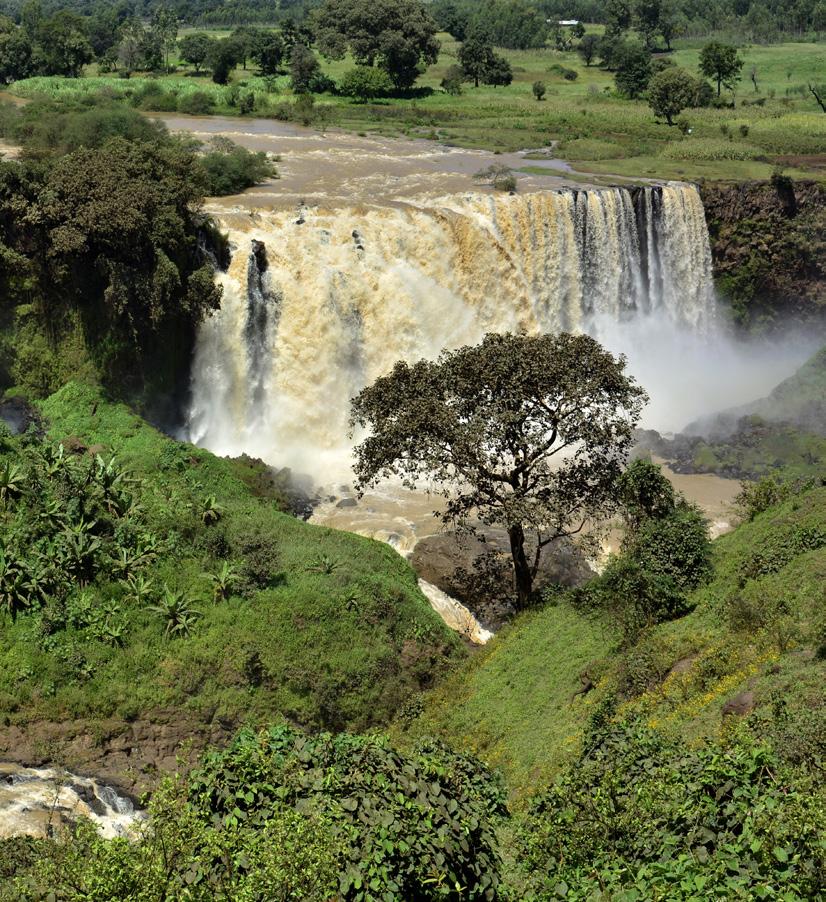
FEATURE
WORLD WATER DAY 2024:
WATER FOR PEACE
Pg. 14 To celebrate World Water Day, SWM delves deep into “Water for Peace”, this year’s theme by analysing the ongoing worldwide water conflicts.
INTERVIEW
EPA NAMES ACTING
HEAD OF WATER
Pg. 30 Bruno Pigott, new acting head of water at the U.S. EPA, discusses his appointment and his vision for the future of U.S.’ water sector.
FEATURE
OPTIMISING WATER USE WITH VSDS
Pg. 46 In this feature article, ABB explores the fundamental role of variable speed drives (VSDs) for water conservation and energy efficiency.
OPINION
THE ROLE OF DIGITALISATION IN EUROPE’S WATER
Pg. 86 Emanuele Quaranta explores in this op-ed some of the market opportunities for digitalisation in the EU, focusing on three water sectors.
CONTENTS NUMBER 21 - MAR/APR 2024
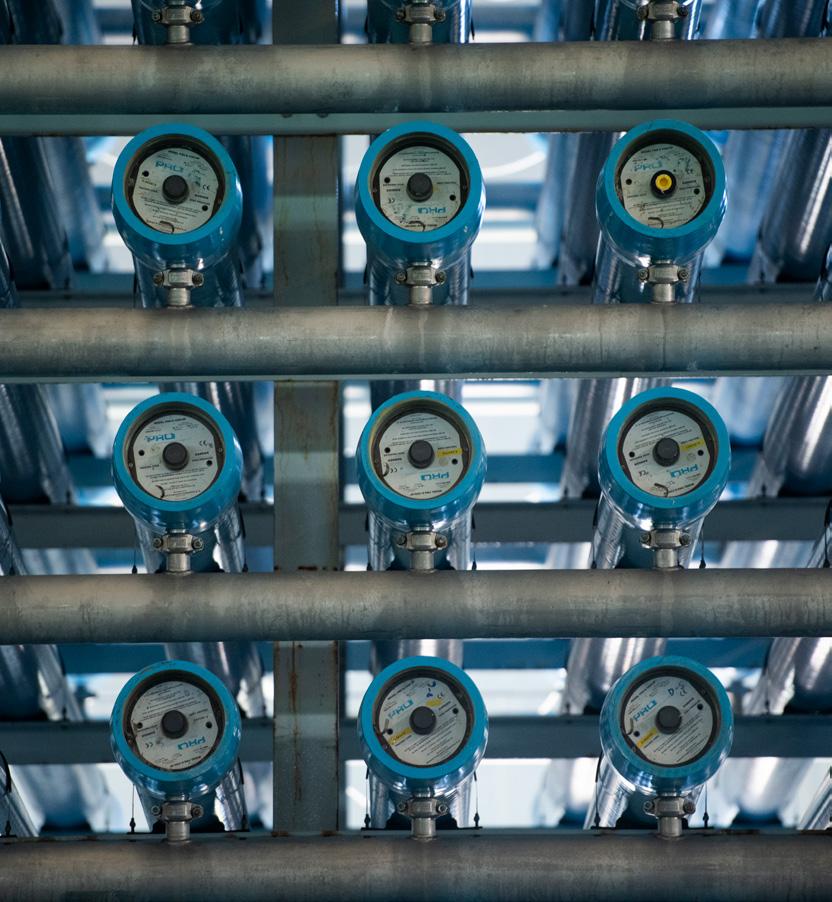
INTERVIEW
WATER SECURITY
AT THE FOREFRONT
Pg. 22 Mr. Saroj Kumar Jha reveals the World Bank’s most recent water projects and the bank’s water security strategy for the next years.
OPINION
Pg. 92 Will Sarni stresses the importance of preparing the workforce and addressing cultural barriers before embracing the latest technologies.
INTERVIEW
Pg. 40 We learn about Natixis CIB’s role in infrastructure financing in Latin America, and the significance of the water sector in this division.
FEATURE
Pg. 62 We discover WEG’s Motion Drives, the company’s innovative solution that revolutionizes largescale water treatment processes.
FEATURE
SDG 6: FINANCING BARRIERS
Pg. 108 An in-depth analysis of financing needs and how to create the conditions to make basic water and sanitation services a reality.
INTERVIEW
TAIWAN TAKES ACTION ON WATER
Pg. 50 Michael Lesniak, VP Partnerships at Aquatech, discusses Taiwan’s strategy to future-proof its economy through climate adaptation.
OPINION
WORKING WITH NATURE, NOT AGAINST
Pg. 107 Restoring rivers to a healthy state may not be easy, but it can be achieved: a call to action for every facet of society to play its part.
FEATURE
BEATING THE ODDS ON WATER SECURITY
Pg. 100 Too much, too little, too polluted: an overview of the threats to water security at the global level and the path ahead to overcome them.
INTERVIEW
OUT OF SIGHT, NOT OUT OF MIND
Pg. 82 The UK’s National Underground Register can transform the way buried infrastructure is installed, maintained, operated and repaired.
FEATURE
MOROCCO’S DESALINATION OUTLOOK
Pg. 56 We take a look at Morocco’s ambitious plans to develop its desalination capabilities as it paves the way for a water-secure future.
OPINION
REIMAGINING WATER SECURITY
Pg. 106 Considering the interdependencies between land, water, and energy resources is key to overcome water challenges in the MENA region.
INTERVIEW
DRIVERS OF DIGITAL TRANSFORMATION
Pg. 88 We hear from researcher Ivo Daniel about their survey on drivers and impacts of digital technology adoption by water utilities.
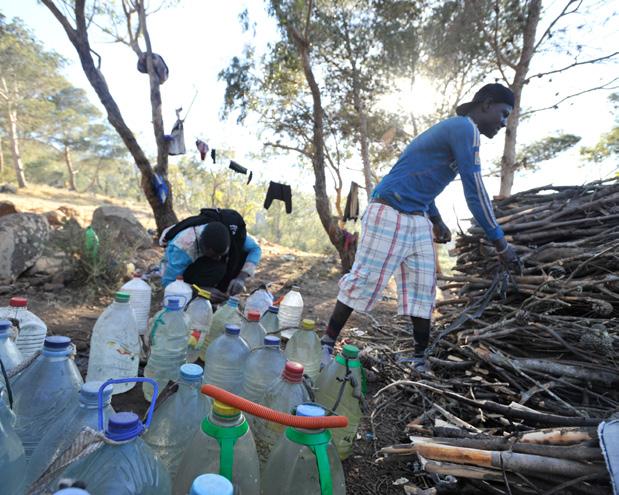
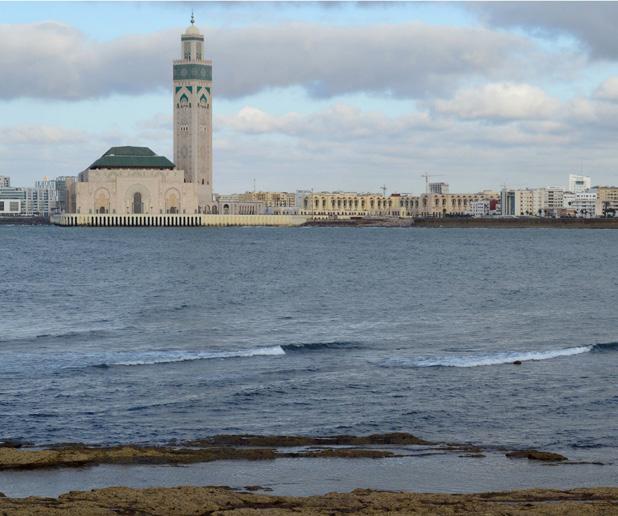
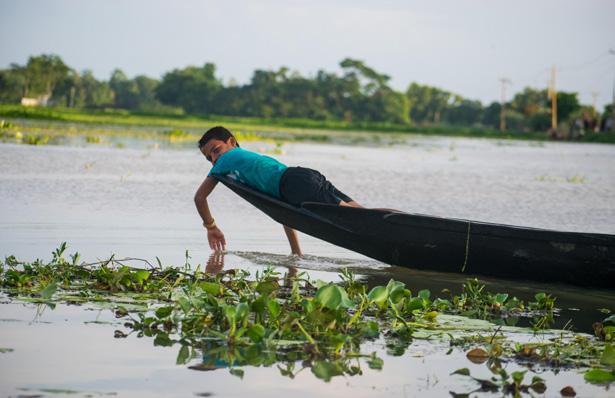
Pg. 78 The first webinar of the Autodesk Water Webinar Series introduced solutions for hydraulic modelling and water hammer analysis.
Pg. 66 We highlight the efforts of the water industry to ensure access to clean water and sustainable water management practices.
OPINON
Pg. 55 New monitoring tools for algal blooms using satellite imagery offer cost-effective spatial resolution to serve as early warning systems.
INTERVIEW
SMART
Pg. 94 We interview Fredrick Royan on the significance of the Jal Jeevan Mission and its implications for the adoption of smart water technology.
WATER
Pg. 77 Dr Darren Lytle is this year’s recipient of the A.P. Black Research Award for his contributions to water science and supply practices.
OPINION
NEW FOULING MITIGATION APPROACHES
Pg. 74 Surface modifications through coatings prevent scale formation, contributing to cost-efficiency and sustainability in water systems.
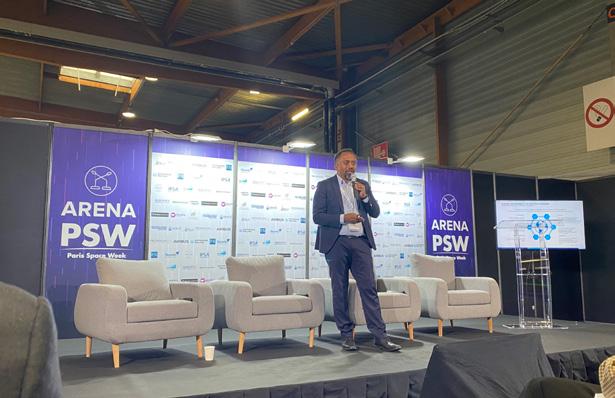

Southern Europe, and especially Spain, faces a significant challenge due to the prolonged drought affecting several regions, causing an emergency due to lack of rainfall. This problem is exacerbated by climate change, which predicts more frequent and severe episodes of water scarcity. However, the transition to renewable energy offers a glimmer of hope for the future of desalination, promising to reduce the costs and environmental footprint of this process. Wind and solar photovoltaics could replace convention-

al sources, such as gas and coal, used in desalination plants, making the process cheaper and more sustainable.
With the expected reduction in electricity costs and increased energy efficiency in desalination plants, the use of desalinated water could be expanded, benefiting both human consumption and agriculture. However, challenges remain, such as limited space for photovoltaic installations in coastal areas and the need for solutions for the discontinuous production of renewable energy.
In this section we have compiled the most important appointments that have taken place recently, and entail taking up a position or role within influential entities (public, private or mixed) in the water sector.

Fox said that the Xylem team realizes technology’s potential to transform the availability, quality and affordability of water
Xylem, a leading global water technology company, announced the appointment of Radhika Fox as Senior Advisor to the Company.
“Radhika is one of the world’s most insightful and effective champions of water – a universally respected voice for solutions to society’s biggest water challenges”, said Matthew Pine, Xylem president and CEO. “She has an extraordinary track record of engaging stakeholders, building consensus, and driving positive change in how we tackle water and climate challenges. We are pleased she is bringing her energy and insights to Xylem.”
Fox will provide strategic counsel to Xylem on evolving issues and opportunities in the water sector and provide advice on a range of matters to support the delivery of Xylem’s strategy. Fox most recently served as the Senate-confirmed Assistant Administrator for the U.S. Environmental Protection Agency’s Office of Water, acting as chief advisor to the EPA Administrator and White House on water resources and water infrastructure in the USA.
Prior to joining the EPA, Fox served as the Chief Executive Officer for the U.S. Water Alliance, a non-partisan network that unites diverse stakeholders on common-ground solutions to the nation’s pressing environmental, water, and climate challenges. Her career in water began at the San Francisco Public Utilities Commission – a public agency that provides water, wastewater, stormwater, and electric power services to over 2.6 million people in the San Francisco Bay Area.

The Board of Directors of Aqualia has appointed Santiago Lafuente Pérez-Lucas as CEO of the company, who until now held the position of Director for Spain, after more than 30 years linked to the citizen services group. Santiago Lafuente’s appointment will take effect on 9th April 2024.
Santiago Lafuente holds a degree in Civil Engineering from the Polytechnic University of Madrid and a master’s degree in End-toend Water Plant Management from CEDEX. He has also studied Project Financial Model Analysis at IESE and EOI.
Santiago Lafuente has extensive experience in the water management sector, and at Aqualia he has held the positions of Area Director, Director of the Central-North delegation, as well as being responsible for Wastewater Production and Treatment in Spain.
Lafuente is a regular speaker at conferences and sectorial round tables, and currently holds the vice-presidency of the Spanish Association of Water Supply Companies (AGA).
Aqualia’s Board of Directors acknowledges and thanks the work carried out by Félix Parra, who since 2013 has held the position of CEO, now assumed by Santiago Lafuente. With his work and dedication, he has contributed enormously to the growth and evolution of Aqualia, which in recent years has achieved a leading position in the water management sector worldwide.
Aqualia is owned by the citizen services group FCC (51%) and the Australian ethical fund IFM Investors (49%). The company is the fourth largest water company in Europe by population served.
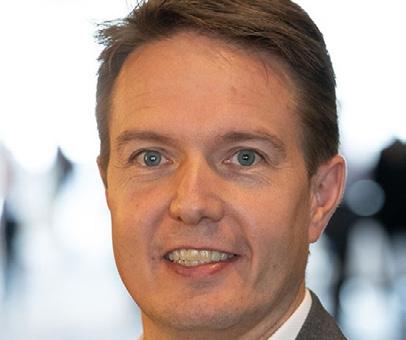
Søren Kvorning, ex CEO of the company Enabl A/S, has a strong commercial profile with almost 20 years of international experience
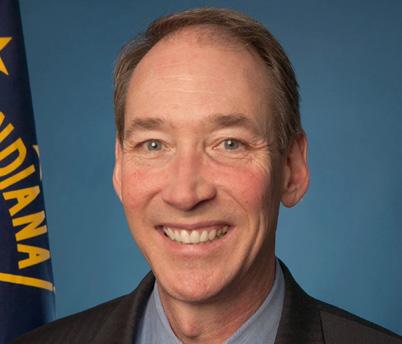
Bruno Pigott joined the U.S. EPA in 2021, after a 20-year career at the
of Environmental Management
Søren Kvorning has been appointed the new CEO of Kamstrup. He comes from a position as CEO of the company Enabl A/S and has a long career within green technology. Søren Kvorning joined Kamstrup on March 15, 2024.
Kamstrup’s new CEO is 46-year-old Søren Kvorning, who comes from a position as CEO of Enabl, a Danish supplier of automation solutions and engineering services for the wind industry. Furthermore, Søren Kvorning has 14 years of experience from various management positions at Danfoss.
Chairman of the Board, Michael Løve, is pleased to have found a strong profile like Søren Kvorning to lead the next growth journey in Kamstrup.“Kamstrup has a solid foundation and will also present a great result for 2023. This is a good starting point for the next strategy period for which we have high growth ambitions. I am sure that Søren (Kvorning, ed.), with his strong international experience, is the right person to realize these ambitions, and I am very much looking forward to the collaboration,” says Michael Løve, Chairman of the Board and CEO of OK a.m.b.a., the owner of Kamstrup.
“Until Søren starts, Henrik Rom will fulfil the role of CEO and will then resume his role as CFO. Henrik has done this very well together with the management team at Kamstrup since June, which means that Søren is joining a company in good shape and with lots of potential,” adds Michael Løve.
Søren Kvorning is an engineer and holds a degree in Engineering Business Administration from VIA University Horsens, Denmark.
The U.S. Environmental Protection Agency has appointed Bruno Pigott as Acting Assistant Administrator of Water.
The second-in-command in EPA’s water office stepped into the shoes of Radhika Fox at the beginning of March as the agency’s top water official. At the end of February, Fox departed from the EPA to join Xylem as Senior Advisor, where she will provide strategic counsel to Xylem on evolving issues and opportunities in the water sector.
Pigott, who brings with him a wealth of experience from his 20-year career at the Indiana Department of Environmental Management, joined the EPA’s water office in December 2021. Previously, he served as commissioner of the department from 2017 to 2021 under former Governor Eric Holcomb (R).
When asked about his new role, Bruno Pigott said to Smart Water Magazine: “I strongly believe that the government can work to benefit people’s lives. In my new role as the Acting Assistant Administrator for the Office of Water, I look forward to working for an Administrator who puts science, public health, and environmental protection first and, moreover, who strives to ensure that EPA’s work is grounded in the lived experience of the American people—especially low income and disadvantaged communities.”
He holds a bachelor’s degree in political theory and economics from James Madison College at Michigan State University and a master’s degree in public and environmental affairs from Indian University’s School of Public and Environmental Affairs.
Ian McAulay of the Institute of Water has been named Isle’s new Chairman. McAulay takes over from Isle’s Founder Dr Piers Clark, who is stepping down from his role but will remain fully involved with the company.
Ian brings a wealth of expertise with more than 30 years of global water and environmental experience. He has extensive experience in the UK regulated utility, construction and environmental sectors and has held board positions across a broad range of organizations.
Isle Utilities previously announced a new strategic partnership with shareholder Palatine PE. With a track record of investing in companies that create and drive social or environmental change, Palatine’s values align closely with Isle Utilities’. The infusion of new resources will help Isle Utilities to expand its reach and lead the way in water environmental transition through innovative solutions.
Following an extended relationship with XPV Water Partners, this new collaboration marks a milestone in Isle Utilities’ journey, ushering in an era of new growth and innovation for Isle.
Ian McAulay, Chairman at Isle Utilities, said: “I am honoured to join Isle Utilities as Chairman at this pivotal moment for water and technology innovation. With the support of Palatine PE, we are uniquely positioned to accelerate our mission of driving innovation in water and environmental sustainability. This partnership heralds a new era where our shared vision to lead the charge on environmental transition can truly flourish.”
Middlesex Water Company has named Nadine Leslie as its new President & CEO. Ms Leslie joins Middlesex, replacing President & CEO Dennis W. Doll, who retired from the company in February 2024.
Ms Leslie is an accomplished leader with domestic and international experience in the water industry. She previously served as Chief Executive Officer of SUEZ North America from 2019 to 2022. In this capacity, she was responsible for overseeing one of North America’s leading environmental companies, with revenues over $1.1 billion, providing water and recycling and recovery services to 6.6 million people in the United States and Canada. The scope of her responsibilities included 15 regulated water utilities, 65 municipal contracts through innovative public-private partnerships and the longterm asset management contracts for water storage facilities, serving more than 4,000 municipal and industrial clients.
Prior to her appointment as CEO of SUEZ North America, Ms Leslie served as Executive Vice President - Health & Safety for the Paris-based SUEZ Group. In this capacity, she was responsible for directing and providing Health & Safety oversight to all business units of the Group. She also led the development and implementation of behaviour-based safety practices, audited Health and Safety procedure implementation and compliance consistent with corporate and regulatory requirements, and monitored the effectiveness of safety control measures used throughout SUEZ business units around the world.
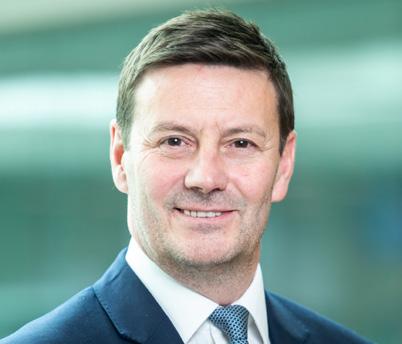
Isle Founder Piers Clark will step down from his role as Chair of the water tech consultancy and give way to Ian McAulay
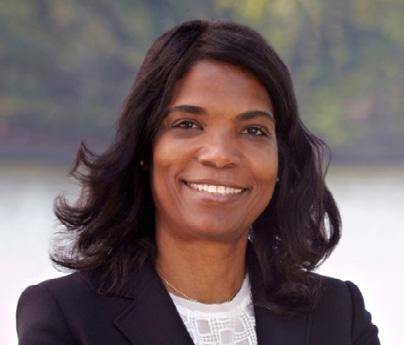
Ms Leslie has more than 25 years of industry experience in operations, management, compliance, client relations and due diligence
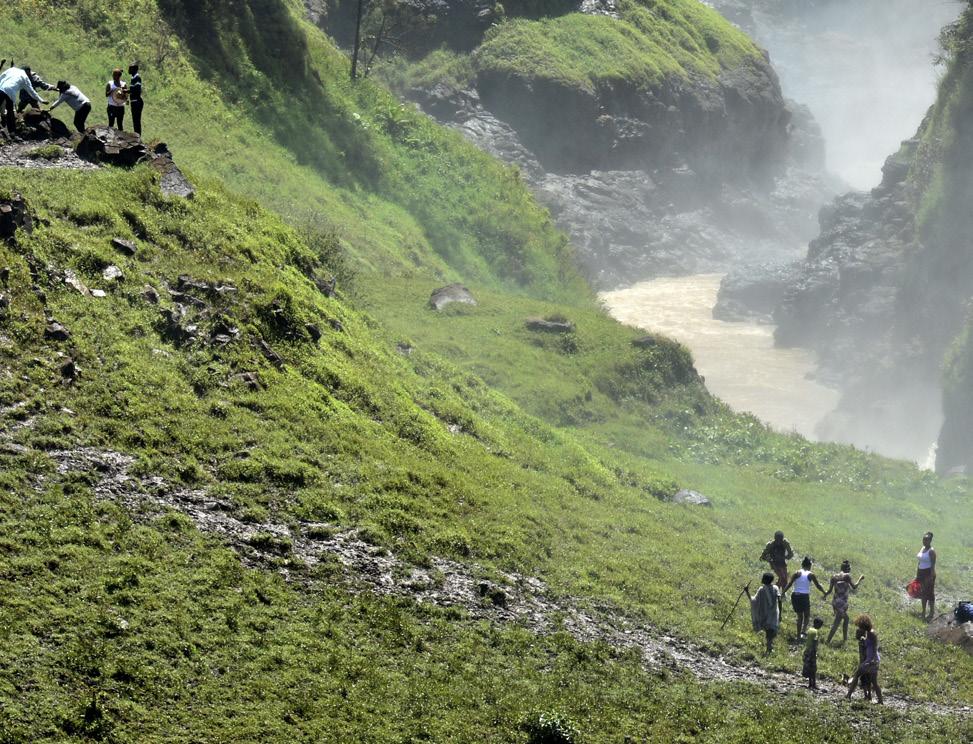
Water plays a critical dual role in promoting peace and triggering conflicts on a global scale. The increasing water scarcity, driven by factors such as population growth, economic expansion, climate change, and ineffective water resource management, is heightening tensions and conflicts related to water
worldwide. Aaron T. Wolf, a professor of Geography at Oregon State University and water diplomacy professor at the IHE-Delft Institute for Water Education, asserts that “the processes required to address these threats are even more challenging when water is shared across political, sectoral, or ethnic bounda-
ries, or when users compete within a basin.” However, there is also growing recognition of water’s potential as a tool for peace and cooperation: “There is increasing awareness of the history of cooperation, of the factors that lead to disputes, and of the importance of institutions for political resilience,” he said
Water can be a tool for peace when countries cooperate to ensure that everyone has access to safe drinking water and sanitation. But it can also provoke and intensify conflict when access is denied.
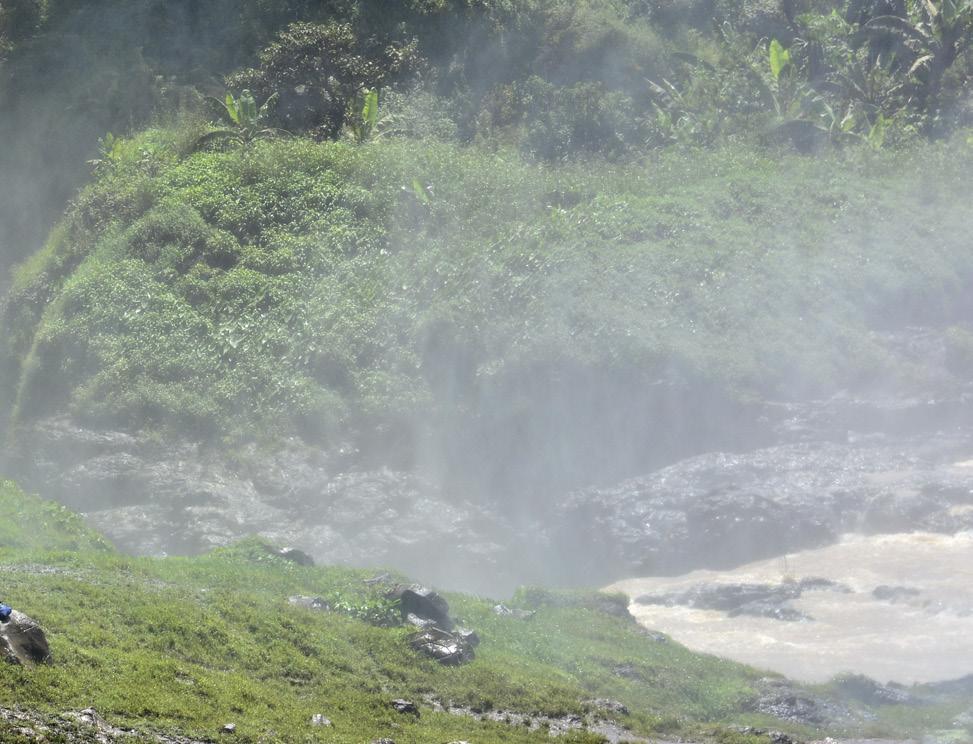
in an interview with iAgua in December 2022, on the occasion of his recognition in the Sustainable Water Management Awards by the Water Observatory of the Botín Foundation.
This is precisely what World Water Day 2024 focuses on, seeking this year to promote cooperation to balance everyone’s
needs, with a commitment to ensuring that no one is left behind and making water a catalyst for a more peaceful world under the theme “water for peace”.
Conflicts over water can have different forms and follow different paths, involving any of the components of water security, defined by the United
Water resources play a critical dual role in promoting peace and triggering conflict across the globe
World Water Day 2024 encourages cooperation to balance the needs of all, with a commitment to ensure that no one is left behind
Nations as “the capacity of a population to safeguard sustainable access to adequate quantities of acceptable quality water for sustaining livelihoods, human well-being, and socio-economic development, for ensuring protection against water-borne pollution and water-related disasters, and for preserving ecosystems in a climate of peace and political stability.” Water-related weaknesses can manifest from local conflicts between communities over access to wetlands to international conflicts between entire countries over dam construction.
While political instability and conflicts are rarely caused by a single factor, water has sometimes been the key trigger of disputes between communities, between the population and the state, or between countries; not to mention its use as a potential “weapon” of war and water itself being a victim of attacks.
According to the report “ Water Conflict Pathways and Peacebuilding Strat -
Water has been a key trigger of conflict between communities or between people and the state and used as a “weapon” of war
egies” by David Michel for the United States Institute of Peace, although there have been more than forty hostile and militarized international actions related to water since World War II, there is no evidence of modern wars declared over water.
However, it is important to note that, according to the “Blueprint for Acceleration: Sustainable Development Goal 6 Synthesis Report on Water and Sanitation 2023” by the United Nations, transboundary waters represent 60% of the world’s freshwater flows, and 153 countries have territory within at least one of the 310 transboundary river and lake basins. This “shared” water has been and still can be a trigger for conflicts, as indicated in a study by Lucia De Stefano and Aaron T. Wolf, along with other researchers from around the world. This study suggests that the most significant indicator of transboundary tensions occurs when one party, typically upstream, wants to build infrastructure without negotiating the impacts with downstream neighbours.
According to the UN, over 3 billion people worldwide depend on water that crosses national borders, however, only twenty-four countries have cooperation agreements for all shared water resources. When water is scarce or polluted, or when people have unequal or no access, tensions can rise between communities and countries.
Water: Nile River.
Countries: Egypt, Sudan & Ethiopia.
Period: Ongoing.
Reason: Construction of the Grand Ethiopian Renaissance Dam.
Water: Tigris and Euphrates Rivers.
Countries: Türkiye, Syria & Iraq.
Period: Ongoing.
Reason: Southeastern Anatolia Project.
Water: Jordan River.
Countries: Israel & Arab League.
Period: 1964-1967.
Reason: Control over water resources.
Water: Mekong River.
Countries: China, Myanmar, Laos, Thailand, Cambodia & Vietnam.
Period: Ongoing.
Reason: Construction of hydroelectric dams.
Water: Amu Darya & Syr Darya River.
Countries: Kazakhstan, Kyrgyzstan, Tajikistan, Turkmenistan & Uzbekistan.
Period: Ongoing.
Reason: Water resources management.
Water: San Juan River.
Countries: Costa Rica & Nicaragua.
Period: 2010-2015.
Reason: Delimitation of the border, navigation rights and environmental protection.
Water: Silala River.
Countries: Bolivia & Chile.
Period: 1996-2022.
Reason: Artificial diversion of the river.
The most common situation of transboundary water conflicts occurs when water is a trigger due to a clash of interests between different users, or when the actions of one party cause the quantity and quality of water of the other to decrease. The most wellknown case in Africa is the dispute over







the waters of the Nile River. Egypt, Sudan, and Ethiopia have had prolonged conflicts over the years regarding the use of Nile water that still persist today. The construction of the Ethiopian Grand Renaissance Dam is currently a point of friction, as downstream countries, Egypt and Sudan, are concerned
about the impact on their water supply. In fact, despite negotiations for a technical and legal solution that could benefit all three parties being concluded in December 2023, Ethiopia is proceeding with the project, and the mega infrastructure entered its final filling phase in January 2024.
The most significant indicator of transboundary tensions is when one side wants to build infrastructure without negotiating
Conflicts over transboundary waters are not the only case where water resources have been the subject of dispute
A similar case occurs in the Middle East with the shared waters of the Tigris and Euphrates rivers by Türkiye, Syria, and Iraq. Development projects in Türkiye, especially the Southeastern Anatolia Project (GAP), initiated in the 1970s, which involves the construction of twenty-two dams and reservoirs and nineteen power plants on the Tigris and Euphrates waters. Both the construction of infrastructure and Türkiye’s water use affect the flow of water resources to the other two countries.
Also worth noting in this region is the War over Water concerning the Jordan River, also known as the “Battle over Water”, between 1964 and 1967. It involved a series of conflicts between Israel and the states of the Arab League, focused on control over water resources in the Jordan River basin. After the completion of the National Water Carrier of Israel, which diverted water from the Sea of Galilee as part of the Johnston Plan, Arab states attempted to implement a Diversion Plan that would deprive Israel of a sig -
According to the United Nations, more than 3 billion people worldwide depend on water resources that cross national borders
nificant portion of its water resources. However, it proved to be technically and economically unfeasible.
In Asia, the Mekong River flows through China, Myanmar, Laos, Thailand, Cambodia, and Vietnam. The shared management of its resources and the exploitation of its waters through the construction of hydroelectric dams have caused tensions and disagreements. Although the Mekong River Commission was established in 1995, comprising only Laos, Cambodia, Thailand, and Vietnam, to regulate diplomatic tensions, the discussions did not yield results. China, on the other hand, established the Lancang-Mekong Cooperation (LMC) in 2016. This division reflects that the Mekong has all the ingredients to be a regional focus of tension on which the future of Southeast Asia depends.
In Central Asia, the conflict over water arises from the complex interaction between geopolitical heritage, environmental challenges, and divergent needs of the countries in the region, primarily Kazakhstan, Kyrgyzstan, Tajikistan, Turkmenistan, and Uzbekistan. The tension between these countries is due to the management of water resources in the basins of the Amu Darya and Syr Darya rivers, which, after the disintegration in 1991 of the resource-sharing system imposed by the Soviet Union in the region, has been impossible to reach
any solid agreement that benefits the five countries involved.
In Latin America, Costa Rica and Nicaragua share the largest hydrographic basin in Central America, which is the San Juan River. For over two centuries, both countries have clashed diplomatically over the delimitation of the border, navigation rights, and environmental protection. In 2010, Nicaragua landed soldiers and construction equipment on opposite banks of the San Juan River in a military incursion to dredge the

channel, sparking a new dispute with Costa Rica that lasted until 2015. That year, the International Court of Justice in The Hague issued a judgment calling for joint and continuous cooperation in the execution of their obligations regarding the waters of the San Juan.
Also in this region, Bolivia and Chile had a dispute between 1996 and 2022, with an agreement in 2009 that was never ratified, over the waters of the Silala River. Bolivia argued that the waters were artificially diverted to Chile, while
Conflicts over transboundary waters are not the only case where water resources have been the subject of dispute

Chile argued that, as an international river, it naturally flowed across the border. Although in 2022, The Hague ruled in favour of Chile, it authorized Bolivia to remove artificial channels made on its territory to reduce the flow.
Water, diplomacy, and cooperation for peace
Water diplomacy can contribute constructively to collaborative water management, improving the resources and governance capacities of conflicting parties, promoting cooperative decision-making processes and inclusive policy institutions, and facilitating the peaceful resolution of disputes. In this sense, there is a growing recognition of the importance of water diplomacy, especially in the case of transboundary waters, and peacebuilding strategies to mitigate the risks of water-related conflicts.
A good example of shared use is the Indus Waters Treaty, signed by India and Pakistan in 1960 after numerous disputes between the two countries and the final intervention of the World Bank to reach an agreement. The Indus River basin is vital for the economy and agriculture of both countries, sustaining millions of people and generating considerable economic activity. Thus, the Treaty regulates the distribution of water from the Indus River and its tributaries, assigning the western rivers (Indus, Jhelum, Chenab) to Pakistan and the eastern rivers (Ravi, Beas, Sutlej) to India, and granting India the right to certain non-consumptive uses of water in the western rivers. However, while
The UN promotes collaborative work, now more than ever, to position water as a stabilizing force and catalyst for sustainable development
the Treaty has been crucial for managing water distribution, it needs to be reconsidered due to the consequences of climate change, which have particularly affected both countries.
Another milestone in shared water resources management was the Ganges Water Sharing Treaty signed between India and Bangladesh in 1996, expiring in 2026. This treaty paved the way for other cooperation agreements for water sharing and memorandums of understanding on more transboundary rivers, such as the Kushiyara or the Feni
In the Americas, the Colorado and Grande/Bravo rivers, which cross the border between the United States and Mexico, play a crucial role in water
management between the two countries, representing two-thirds of the border and being the subject of bilateral agreements since the 19th century, although they were on the brink of breaking in October 2020. However, in Minute 323, signed in September 2017, the adoption of a Binational Water Scarcity Contingency Plan for the Colorado River basin was included, stating that both countries must share water scarcity. This plan, currently in effect and which has helped avoid a dispute due to the severe drought of 2022 and 2023, could be in danger after the general elections scheduled in both countries in 2024.
Since 1967, the La Plata Basin Commission has served as a key mechanism
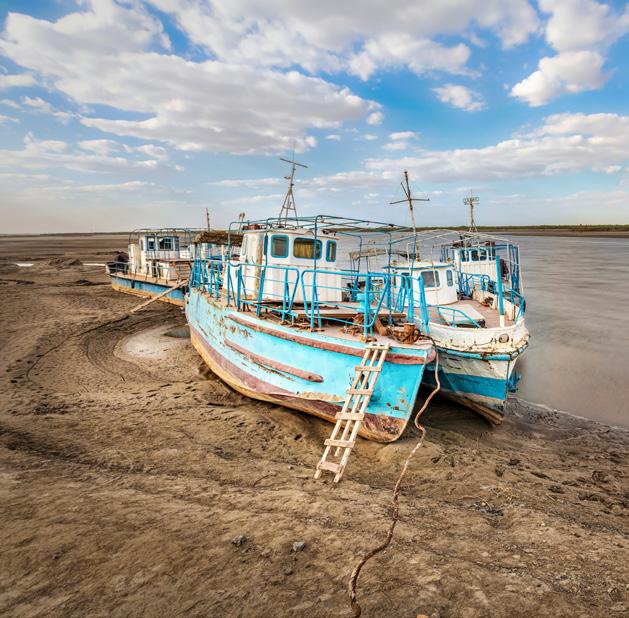
to reinforce the regional integration process, seeking harmonious and balanced growth that benefits all involved nations, namely Argentina, Bolivia, Brazil, Paraguay, and Uruguay.
Finally, in Europe, the Albufera Convention, signed in 1998 by Spain and Portugal, establishes a framework for the joint management of the river basins shared by both countries, including those of the Miño, Limia, Duero, Tagus, and Guadiana. This agreement, which entered into force in January 2000, responds to the need to coordinate water management in a sustainable and environmentally responsible way, including specific commitments to minimum annual flows.
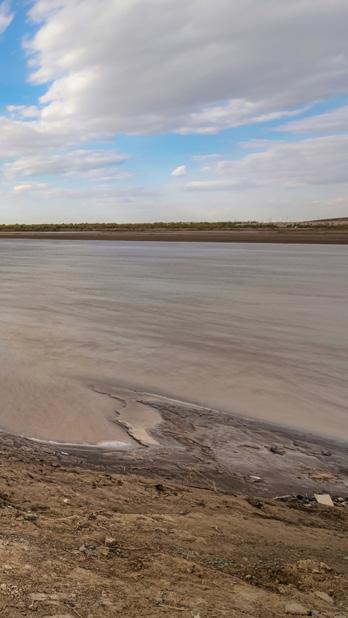
Conflicts over transboundary waters are not the only case where water resources have been the subject of dispute
Also noteworthy is the existence, since 2018, of the International Commission for the Protection of the Danube River (ICPDR), the main legal instrument for cooperation and management of transboundary waters in the Danube River basin, comprising nineteen countries.
Transboundary water conflicts are not the only case in which water resources have been a cause of dispute. A local example is the Cochabamba Water War. In the early months of 2000, the Bolivian government privatized the municipal water company. Fearing the expropriation of communal water systems, residents and farmers launched a wave of strikes and blockades that led the government to declare a “state of siege,” before finally returning the company to public management.
On the other hand, the availability and quality of water in the Gaza Strip have been a point of tension between Israel and Palestine within their larger conflict. Restrictions imposed by Israel and damaged infrastructure have led to a severe water crisis in Gaza, illustrating how water can be used as a weapon to gain or maintain control over territory and population or as a means to pressure opposing groups. It should not be forgotten that attacks on critical and civilian infrastructure, including water supply systems, pose serious
health risks and violate international humanitarian law.
It should not be forgotten that water is not just a resource that can be used and competed for; it is also a human right, intrinsic to all aspects of life. Therefore, the UN promotes collaborative work, now more than ever, to position water as a stabilizing force and catalyst for sustainable development. The impacts of climate change are becoming stronger, and the population continues to grow, leaving a rather delicate outlook regarding the future availability of water resources. This further highlights the need for countries to come together to protect and conserve water.
The goal is to leave no one behind regarding access to water and sanitation. What must be left behind is the need to assert dominance as hegemonic powers in regulating river flows, whether transboundary or not, and also to divert attention from the real problems in each region.
Water diplomacy can contribute constructively to the collaborative management of available water resources
“More private investment must be catalyzed as government funding doesn’t come close to meeting people’s water needs”SAROJ KUMAR JHA - GLOBAL DIRECTOR FOR THE WORLD BANK GROUP’S WATER GLOBAL
The World Bank is currently the largest multilateral financier dedicated to water initiatives in developing nations. In 2023, the global organization successfully extended access to water or sanitation to nearly 30 million individuals by providing financial aid and technical assistance to governments for enhancing water infrastructure, management practices, and fostering community involvement.
Tempest
With a robust portfolio of nearly US$30 billion in water-related investments and leading a team of over 400 people, Mr Saroj Kumar Jha, Director of the World Bank Group’s Water Global Practice, is a pivotal figure in shaping policy direction and fostering partnerships to address global water challenges. In this interview, we delve into his journey and insights into how the World Bank is navigating the complex landscape of water security and inclusive service delivery.
Can you tell us briefly about your career path and your current role at the World Bank Group?
I have always worked to improve the lives of poor people, especially those who live in fragile settings and are struggling
"To achieve SDG 6, the Water Global Practice focuses on enhancing investments, institutions, and information in the countries we support"
to find clean water, sanitation, food, or good jobs to provide for their families. I began my career with the Government of India and then worked at the United Nations, where I focused on infrastructure financing, natural resources management, natural disaster prevention, and environmental sustainability.
I have had the privilege to work at the World Bank for nearly 20 years, and it has been incredibly rewarding. I have been stationed in the Middle East and Central Asia and served as the Senior Director of the Fragility, Conflict, and Violence Global Practice. I also founded and led the Global Facility for Disaster Reduction and Recovery, which is a multi-donor partnership that supports developing countries to understand, manage, and reduce their risks from natural hazards and climate change. Climate change, of course, shows up through water — whether it’s too much or too little. Nine of every 10 natural disasters are water-related.
That’s why I was so honored to be named the Global Director of the Water Global Practice in August of 2022. I lead a terrific team of over 400 staff, who are working hard to solve the water crisis, which is central to fulfilling the World
Bank’s mission of creating a world free of poverty on a livable planet.
With only seven years left to achieve the Sustainable Development Goals, the world is significantly lagging behind, particularly on its water goals. How is the World Bank addressing the challenge of achieving water security? It will be impossible to achieve all the Sustainable Development Goals without providing clean water and sanitation to everyone, so failure on water is not an option. To achieve SDG 6, the Water Global Practice focuses on enhancing investments, institutions, and information in the countries we support.
We have a portfolio of US$28 billion in water-related investments, analytical work, multi-donor trust funds, and global partnerships, which makes us the largest multilateral financier of water in developing countries. Last year, we provided access to water or sanitation to nearly 30 million people. But the needs are vast — 2 billion people lack safely managed drinking water services, 3.6 billion lack safely managed sanitation services, and 2.3 billion lack basic handwashing facilities. We must catalyze far more private investment because government funding — the source of the vast majority of water spending — doesn’t come close to meeting people’s water needs.
To create an enabling environment to encourage private investments, the World Bank is working to build strong, financially viable institutions — from water utilities to irrigation operators —
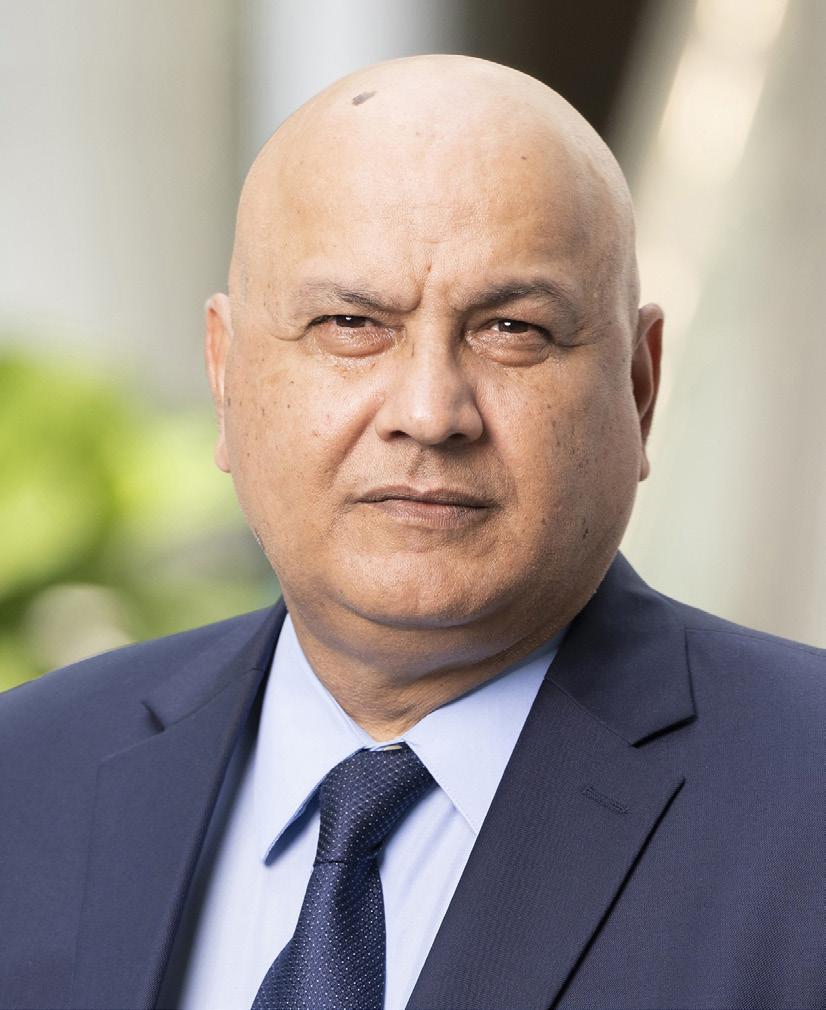
to deliver services to communities. We are also strengthening government water ministries so that they can develop the right kinds of policies and regulations to govern the sector and make it more attractive to private finance.
In addition, because access to safe and clean water is critical to achieving other development goals, sectors need to work together. The World Bank enables a multisectoral approach by helping governments build data and information platforms for collaboration. This also fosters partnerships with academia, think tanks, international donors, and other countries, which is so important because water resources often cross borders.
Lastly, we are mobilizing and scaling up support for water through our new Fast Track Water Security and Climate Adaptation Global Challenge Program. It aims to strengthen water security through systems change and more sustainable water management and disaster risk reduction solutions. The program will enhance access to water supply and sanitation, improve irrigation service delivery and water productivity, and reduce flood and drought risk.
How does the 2030 Water Resource Group (2030 WRG) updated strategy promote the development of water security and climate action plans?
The 2030 Water Resources Group promotes the role of the private sector in water security and climate action through partnership and technical assistance. The challenges in the water sector cannot be solved by the public sector alone,
"It will be impossible to achieve all the SDGs without providing clean water and sanitation to everyone, so failure on water is not an option"
"We have a portfolio of US$28 bn in water-related investments, making us the largest multilateral financier of water in developing countries"
and 2030 WRG looks for opportunities where multi-stakeholder partnerships and private sector innovations can improve water security.
2030 WRG’s work is structured along three themes, namely: (1) Water for Food, in particular through climate-resilient irrigation, (2) Water for Environment to address water pollution and water use for catchment protection and restoration, and (3) Water for Cities, to

support resilient city-regional water systems, balancing the demand and supply of water. Each of these themes links with water security and climate action.
Across these themes, 2030 WRG’s approach to country-level impact on water security and climate action is structured along four areas:

J Support for evidence-based decision-making through analytics and a macro framing of the national or sub-national/ state-level water challenges, building on World Bank and other analytics,
J Establishment of country platforms for high-level convening of government

stakeholders, private sector, civil society, and international organizations,
J Design of Accelerator programs for large-scale implementation of private sector-led solutions, including private capital, innovation, and expertise, and
J Replication and scale up of successful solutions, particularly combining the World Bank’s institutional strengths in lending and public sector delivery with 2030 WRG’s pioneering public-private model of engagement.
In fiscal year 2023 (FY23), we launched accelerators in India, Bangladesh, South Africa, and Kenya, along with early work in Ethiopia and Kazakhstan. These accelerators are structuring innovative partnerships and solutions for systems change in the water sector.
In addition, our work to address water challenges became more climate-oriented than ever before. Water is at the center of the climate crisis: climate change is severely disrupting the water cycle on which people and the planet depend, and nine out of 10 climate events are water-related. For example, through our work in Uttar Pradesh, India, we are supporting farmers on climate-smart agriculture, contributing to greater water use efficiency, along with reduced methane emissions.
Fulfilling global water financing requirements is a substantial challenge, with an estimated $6.7 trillion by 2030 for water infrastructure. How is the World Bank promoting the need
for financing, particularly in low-and middle-income countries?
The World Bank is scaling up finance for water-related investments in emerging economies by leveraging limited concessional resources from donors to crowd in additional private sector innovation, expertise, and capital into a sector that has been historically funded through public and concessional financing.
We do this in several ways. First, we create the enabling conditions for scaling up finance through reforms, regulations, incentives, and capacity building, focused on the foundational issues of creditworthiness and technical and financial performance of service providers. Second, we mobilize private-sector participation through public-private partnerships, performance- and output-based contracts, results-based financing, and other instruments to improve operational efficiency and financial viability. Third, we diversify and expand the range of financial solutions from different partners and investors for countries, including commercial debt, bonds, microfinance, blended finance, and equity instruments through de-risking, credit enhancement, financial structuring, and overall sector sustainability initiatives. Lastly, we are emphasizing the linkages of water with climate mitigation and adaptation, both to strengthen the business case for water sector investments, as well as to leverage greater climate finance for the water sector.
The World Bank’s approach to increasing investments in the sector is encapsulated in a recent strategic framework on “Scaling up Finance for Water”
"The World Bank enables a multisectoral approach by helping governments build data and information platforms for collaboration"
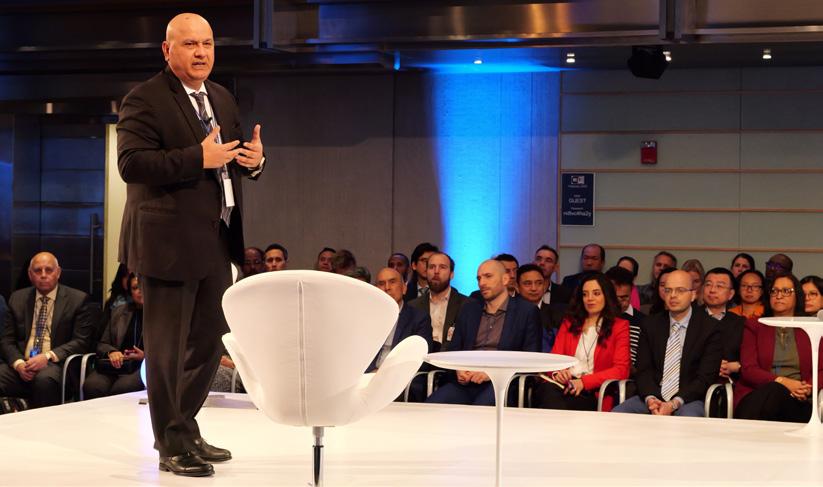
Desalination has become a viable option to close a water supply-demand gap; however, governance structures established for conventional water sources are facing challenges in keeping pace. How is the World Bank aiding in this respect?
Unconventional water sources, such as desalination and recycled water, provide a weatherproof source of water that, when added in the right amount to the mix, can contribute to dealing with climate uncertainty and improve the reliability of the system. However, in the case of desalination volumes mobilized cannot be increased indefinitely without creating
"Water is at the center of the climate crisis: climate change is severely disrupting the water cycle on which people and the planet depend"
environmental and fiscal concerns. The use of desalination as a water augmentation and diversification strategy should come with significant efforts to improve water distribution and use efficiency and to reallocate scarce resources to activities with higher social and economic value. Desalinated water is also more expensive to mobilize than conventional sources, and this means that mainstreaming its use requires rethinking financial policies to ensure the long-term sustainability of the sector.
First of all, we need to put demand management measures in place, including reducing losses in water distribution systems and creating incentives for conservation through pricing policies, accompanied by subsidies to protect the poor from higher costs of the more expensive unconventional water sources as well as behavioral change to induce a reduction in water consumption.
Also, importantly, water rights regimes and environmental and water sector economic policies and regulations should be adapted to ensure a healthy and sustain-
able use of desalination as it increases its weight in the water mix. Likewise, if desalination and reuse are to be mainstreamed, this requires developing the institutional capacity to develop and manage sophisticated infrastructure in a rapidly evolving technological sector. It also requires institutions able to manage all the policy implications mentioned above.
In response to this need, the Bank has established a Desalination Community of Practice that aims at generating, capturing and disseminating knowledge on desalination governance and economics among WBG institutions and clients, partnering with countries that are ahead of the curve in this domain and with the industry.
Reclaiming and reusing water is also central to a water-secure future. How is the World Bank promoting a circular economy? And do you have any projects you are particularly proud of? Wastewater reuse involves treating and recycling water that would otherwise be discharged into the environment, reducing the pollution load on water bodies and it is often more cost-effective than desalination and other unconventional
water supply alternatives, especially in areas where the infrastructure for wastewater treatment already exists. To accelerate the consideration of water in circular economy efforts, the World Bank has developed the Water in Circular Economy and Resilience (WICER) Framework to guide practitioners who are incorporating the principles into policies and strategies, planning, investment prioritization, and design and operations. The framework has assisted projects at the global level in integrating circularity into their designs.
In water-stressed Tunisia for example, the World Bank’s sanitation engagement was key in supporting increased reuse of treated wastewater in agriculture, and piping wastewater under land and sea as part of an environmentally safe disposal system. This reduced wastewater discharge from Greater Tunis into the Gulf of Tunis, an environmentally sensitive area of the Mediterranean.
Another example is the Water Circularity and Efficiency Improvement Project in Türkiye, a country where over two-thirds of 25 river basins are facing water scarcity and widespread wastewater pollution is deteriorating water quality. This $434.7 million project approved by the Bank in 2023 will improve wastewater and reuse services, increase irrigation services and efficiency, and strengthen institutional capacity and coordination for managing water circularity.
In a recent blog post, you mentioned that to address the water crisis at scale, unconventional methods and new and disruptive forms of financing are needed. In what ways can emerging technologies also assist the water sector?
Nowadays technology is moving at a very high pace, but the water sector has been risk-averse and slow to adopt and disseminate new technologies. Recent data from our Digital Maturity Global Survey has found that less than 10% of water utilities in low- and middle-income countries are using artificial intelligence, big data
"World Bank has established a Desalination Community of Practice, aiming to generate, capture and disseminate knowledge on desal governance"
analytics or digital twins. We have seen advances in sensor technology, computing, artificial intelligence, and big data management, which can help improve the monitoring of water quantity and quality and inform operational decisions by policymakers and water companies, amongst other key capacities.
To accelerate the uptake of technology and hit our stride, we need to do three things: first, create an enabling environment of policies, incentives, and regulations that not only promote the adoption of existing technologies, but also seek to accelerate, scale up and catalyze our adaptation to the new challenges we are facing; second, by financing more innovation to develop and scale new technological solutions, with a clear indication of the potential returns on investment; and, third, invest in continuous learning and development for our staff and the water companies we work with, to keep up with technological developments.
What role does the World Bank play in promoting best practices, knowledge sharing and capacity building among nations to strengthen their water governance and management capacities?
Generating knowledge and enhancing capacity are essential elements of the World Bank’s approach to solving multiple crises. An example is our Global Water Security and Sanitation Partnership (GWSP), which is a multi-donor
fund that produces cutting-edge research and analytics to create and deliver urgent, practical, and innovative solutions to enhance water security. It’s a kind of action-oriented think tank for the water sector, providing clients with policy advice, technical assistance, capacity building and turning knowledge into action through policy dialogue and lending operations.
For example, in fiscal year 2023, GWSP provided support to 26 Country Climate and Developments Reports by analyzing the impact of water-related risks on economic growth and livelihoods. In Argentina, a GWSP-supported program aims to reduce flood exposure for 123,000 people and support 10 cities in adopting improved integrated urban flood risk management practices. And in Cambodia, GWSP funded the development of a water resource modeling tool that generates climate change scenario projections, including risks of water shortages, to inform coordination between the country’s water resource and supply sectors.
"Nowadays technology is moving at a very high pace, but the water sector has been riskaverse and slow to adopt and disseminate new technologies"

Because we care and because our planet’s health is in our hands, we take the temperature of the planet in this new section.
A window that aims to show and raise awareness of the evolution of a curable but extremely serious illness, climate change.
Last February was the warmest month on record globally, with an average temperature of 13.54 °C, almost one degree above the 1991-2020 average and 0.12 °C warmer than the previous record in 2016. This is the ninth consecutive month with a new temperature record for the respective month of the year.
According to the European Union’s Copernicus Programme for Earth Observation and Monitoring, the global average temperature of the last 12
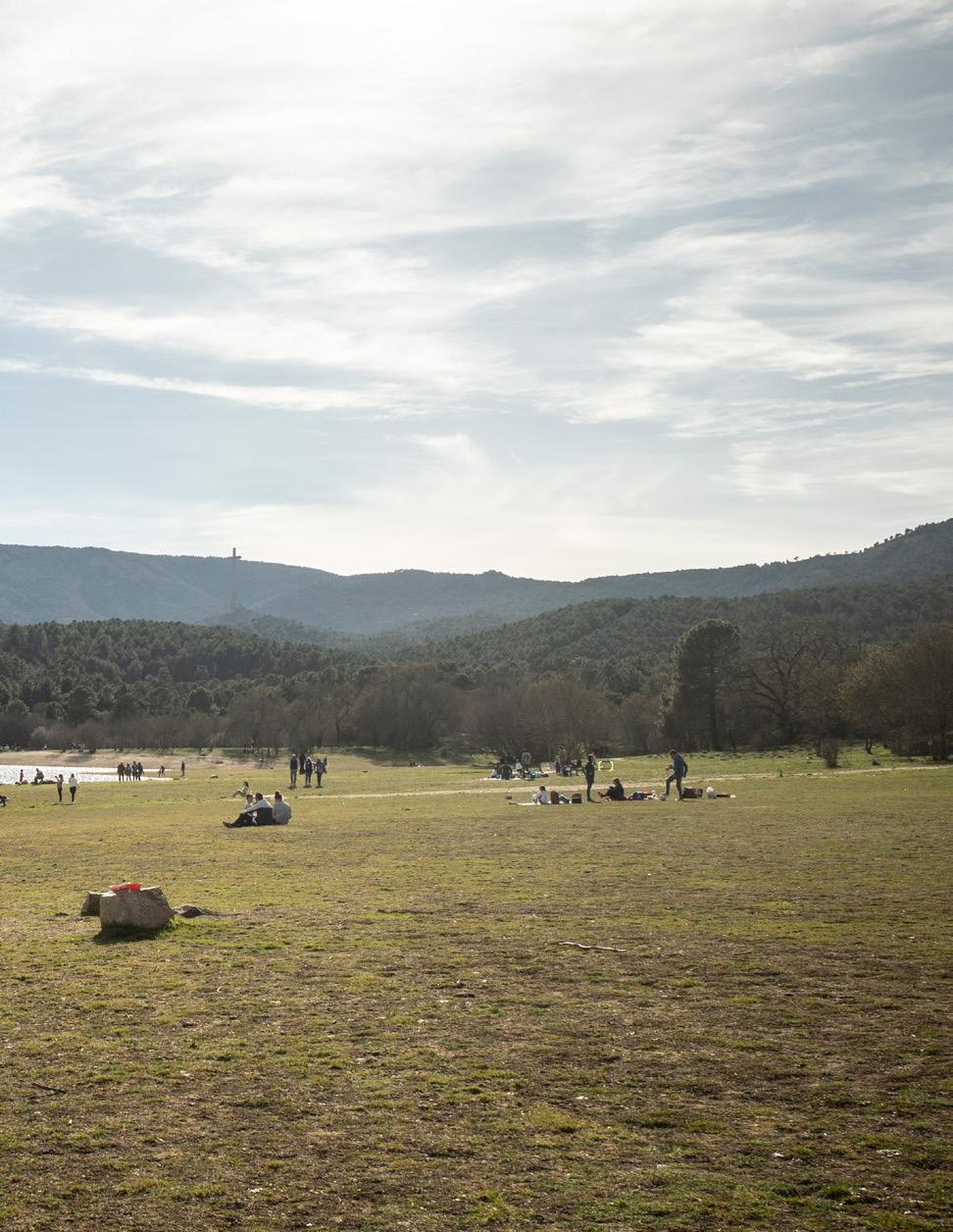
months is the highest on record, 0.68 °C above the 1991-2020 average and 1.56 °C above the pre-industrial 18501900 average.
In the words of Carlo Buontempo, director of the Copernicus Climate Change Service, “Climate responds to the actual concentrations of greenhouse gases in the atmosphere, so unless we manage to stabilize those, we will inevitably face new global temperature records and their consequences.”
18 February 2024. Madrid locals sunbathing
by the La Jarosa reservoir, municipality of Guadarrama, Madrid, Spain @González-Cebrián/SWMBruno Pigott, second-in-command, took the helm of EPA’s Office of Water on an acting basis at the beginning of March, succeeding Radhika Fox. With over 20 years of experience at the Indiana Department of Environmental Management, Pigott joined the federal agency in December 2021 and since then, has played a key role in developing major water regulations. In his new role, Pigott aims to prioritize science, public health, and environmental protection, particularly focusing on underserved communities. Holding degrees from Michigan State University and Indiana University, Pigott brings a wealth of knowledge to his position. Only one month into the job, Smart Water Magazine had the opportunity of interviewing him about his new role and the EPA’s critical task of ensuring a future where no American ever has to worry about their water.
As the newly appointed acting assistant administrator for EPA’s Office of Water, what strategic priorities and future plans do you have in mind to advance the agency’s mission and address pressing water-related challenges?
My highest priority is to ensure we are delivering on what we set out to do: follow science and the law to protect public health and the environment by making investments in communities’ water that will make a difference for generations to come.
This is precisely why, thanks to the Biden-Harris Administration, EPA is providing an unprecedented $50 billion
"Thanks to the Biden-Harris Administration, EPA is providing an unprecedented $50 billion in funding and assistance to communities"
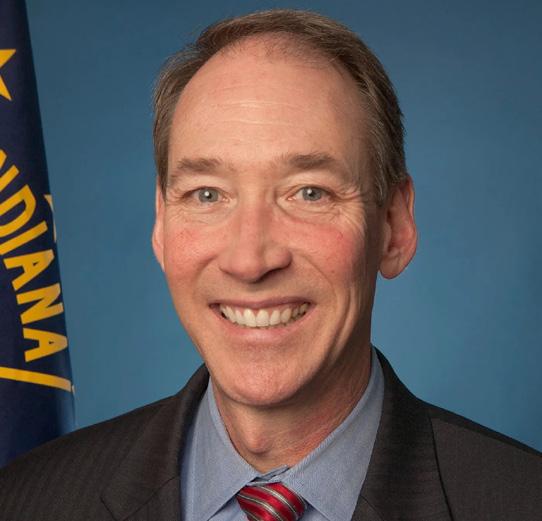
in funding and assistance to communities. On top of that, we are working hard to make sure that this funding and assistance is getting to places that need it most. The top of our regulatory agenda for 2024 includes:
J Preventing thousands of deaths and tens of thousands of sicknesses by issuing a Final Drinking Water Rule for several PFAS
J Changing the health outcomes for hundreds of thousands of people by issuing the Final Lead and Copper Rule Improvements, which will help America achieve 100% removal of lead pipes in 10 years
J Protecting our nation’s water bodies by proposing Effluent Limit Guidelines that will limit the amount of pollutants discharged by coal-fired power plants
The Biden-Harris administration announced the largest investment
in water infrastructure with $50 billion. Could you elaborate on why addressing water-related challenges has become a top priority for the administration?
Clean, safe water is at the heart of any thriving community. It’s essential to our health and it powers our economy by creating jobs and keeping businesses open.
The need for water infrastructure investment is great. Did you know that about 2.2 million people in this country don’t have access to basic wastewater services in their homes? And, that there are approximately 9 million lead service water lines still delivering tap water? On top of that, across the country, we are seeing climate stress play out as water stress from extreme flooding events to extreme drought, investment in resilient infrastructure is a must. The Biden-Harris Administration’s Bipar-
“EPA recognized cyber security as one of the most critical issues water utilities must tackle today”
Based in Washington D.C., the EPA’s Office of Water works extensively with other EPA regional offices, federal agencies and state and local authorities to ensure the safety of drinking water in the United States. The EPA is currently in the process of finalizing several key water regulations, including the first-ever nationwide drinking water standard for six “forever chemicals”.
tisan Infrastructure Law is an unprecedented investment in much needed water infrastructure improvements to address these challenges.
The EPA recently announced over $5.8 billion to invest in drinking water and clean water infrastructure upgrades. How does the agency plan to ensure equitable distribution of these funds to underserved communities?
The recently announced $5.8 billion is part of the over $50 billion investment in water infrastructure upgrades from President Biden’s Bipartisan Infrastructure Law. These funds will be dispersed through the Clean Water and Drinking Water State Revolving Funds (SRF), one of EPA’s signature water investment programs and the monies fund staterun, low-interest loan programs with $2.6 billion going to the Clean Water SRF for wastewater and stormwater
infrastructure and $3.2 billion going to the Drinking Water SRF for drinking water infrastructure. Almost half (49%) of this funding will be available as grants or principal forgiveness loans, ensuring funds reach underserved communities most in need of investments in water infrastructure.
Additionally, EPA’s Water Technical Assistance (WaterTA) programs are working to identify and help communities that have been historically left behind. These are communities that need water infrastructure investments but may not have the resources to develop solutions plans or engineering designs and apply for federal funding. EPA’s WaterTA works hand-in-hand with communities to help them access the funding. Our WaterTA program is already helping 750 communities across the country, and we’ve committed to doubling that over the next three years.
The pending EPA rule to remove “forever chemicals” from drinking water has raised concerns about potential financial implications for water utilities, forcing them to raise water bills. How does the EPA plan to address these concerns?
The PFAS Rule is an excellent example of how we’re putting Bipartisan Infrastructure Law funds to work. In fact, $9 billion of the $50 billion is specifically allotted for communities with drinking water impacted by PFAS and other emerging contaminants. An additional $12 billion in BIL funding is available for general drinking water improvements. And, EPA’s water technical assistant program is ensuring that disadvantaged communities can access this federal funding which will prevent thousands of deaths and tens of thousands of sicknesses.
Climate change poses significant challenges to water resource management. How does the EPA intend to adapt its strategies to address the evolving impacts of climate change on water quality and availability?
Climate stress is often felt as water stress in communities across the country. EPA’s water infrastructure investments are designed to support resilient solutions. Since 2018, our WIFIA low-interest loan program has invested nearly $20 billion to support over $43 billion in water infrastructure projects while creating 140,000 jobs. Bipartisan Infrastructure Law funding is also investing in resilient solutions from water infrastructure improvements to geographic program investments for issues like excess nutrients.
"Clean, safe water is at the heart of any thriving community and it powers our economy by creating jobs and keeping businesses open"
Climate impacts must be factored into our investments and into our solutions, and thanks to EPA’s Climate Adaptation Plan climate impacts and climate resilience are part of the criteria for grant and loan funding.
Despite federal focus on addressing climate resiliency in the water sector, a recent NACWA report highlights the challenge utilities face in securing adequate funding for critical programs. Could you discuss the EPA’s strategies and initiatives aimed at remedying this issue?
It’s true that accessing the historic federal funds made available for tackling climate change can be a challenge. That’s why EPA’s Water Technical Assistance (WaterTA) is so transformative. Through our WaterTA program, EPA is partnering with communities – listening and building community trust; all while supporting community leaders each step of the way towards accessing their share of water funding. Through this program, we are ensuring every person’s story in America is one of safely turning on the tap or flushing the toilet without fear or lack of access.
Through WaterTA, EPA collaborates with states, tribes, territories, local utilities, and other key stakeholders to provide hands-on support to assess their needs, identify potential solutions, and develop funding applications. This assistance complements and augments state efforts to reach more communities.
Our Creating Resilient Water Utilities (CRWU) initiative is a WaterTA program aimed at improving climate
"$9 billion of the $50 billion is specifically allotted for communities with drinking water impacted by PFAS and other emerging contaminants"
"EPA’s Water Technical Assistance programs are working to identify and help communities that have been historically left behind"
resiliency. Through it, we are providing drinking water, wastewater, and stormwater utilities with practical tools, training, and technical assistance to increase system resilience to climate change impacts. CRWU helps promote a clear understanding of climate data
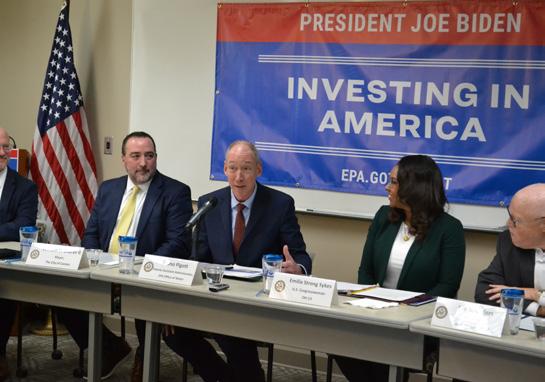
and helps water sector utilities identify potential adaptation strategies, implementation options, and infrastructure financing.
EPA is currently investing $500 million in expanded Water Technical Assistance services. With this funding, EPA is already working with dozens of Wa-

terTA providers to reach hundreds of communities. Our partners are actively working with communities to address their most pressing water challenges. Communities can now use a simple online form to request WaterTA support. This and other resources are available at www.epa.gov/WaterTA
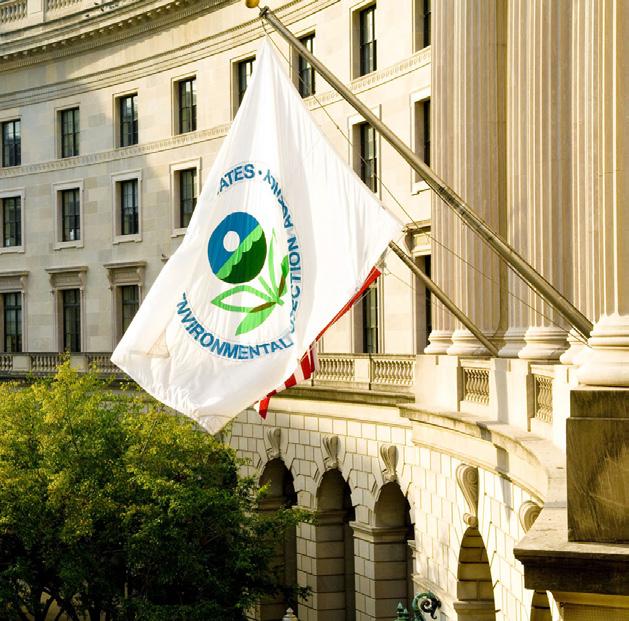
How is the EPA actively addressing the growing concern of cybersecurity threats within the water sector?
EPA recognized cyber security as one of the most critical issues water utilities must tackle today. As such, EPA is working to provide all water systems the assistance they need to protect themselves against cyber threats. We are working closely with America’s cyber defense agency, the Cybersecurity Infrastructure Security Agency (CISA) to identify and implement solutions. CISA’s Water Sector Coordinating Council (WSCC) and Water Government Coordinating Council (WGCC) just completed an update of their 2024 Roadmap to a Secure and Resilient Wa-
ter and Wastewater Sector, which includes priority actions that will directly inform all our work.
Last year, EPA shared a complete list of all its security and resilience projects, including cyber projects, with the WSCC and WGCC, with an invitation to engage in the design and review of any project. For example, we have a collaborative effort with the National Rural Water Association (NRWA) to train circuit riders on using its cyber tool for small system assessments.
EPA is also providing cybersecurity technical assistance to the water sector, providing systems with direct access to subject matter experts and we are continuing to conduct cyber assessments
for small water systems under our Cybersecurity Evaluation program, where a government contractor will conduct a free assessment and generate a cyber mitigation plan for the utility.
EPA will continue to work with its federal partners including the Department of Homeland Security and the Department of Defense to support drinking water and wastewater systems that serve military-related facilities.
EPA understands that cyber preparedness comes at a cost and helps systems learn how to access and apply for funding such as the Drinking Water System Revolving Fund, the Infrastructure Resilience and Sustainability Grant and other state and local sources, to support systems in investing in cybersecurity projects.
How does the EPA envision the state of the US water sector in the next decade, and what key initiatives or developments do you foresee shaping its future trajectory?
The challenges facing the water sector will continue to grow in complexity, due to several factors, including the increased frequency of extreme weather events; the continued emergence of new contaminants; and the threat of disrupted water service due to cyber vulnerability.
The good news is innovation, partnership, and federal funding will help communities face these challenges head-on.
EPA’s Office of Water will remain steadfast in our commitment to a future of fishable, swimmable, drinkable water – a future where no American ever has to worry about their water.
"CRWU helps promote a clear understanding of climate data and helps water sector utilities identify potential adaptation strategies"
The initial target is to exceed one million NB-IoT connections for its water meters in Spain during the first 5 years of the contract

Aqualia has entrusted Vodafone Spain with the supply of NB-IoT connectivity to digitalise the entire water cycle for the next 10 years, according to an announcement made at MWC Barcelona 2024.
The initial target is to supply more than 1 million IoT connections to its water meters over the first 5 years of the contract. Since the rollout with Aqualia began in October 2022, Vodafone Spain has already connected more than 250,000 meters to its NB-IoT network.
In the coming years, Aqualia will offer a remote metering service to its more than 3 million users in Spain, which will lead to a better understanding of water use and efficiency, and greater transparency in water management. It will also help to improve environmental aspects and generate highly qualified technical employment.
Daniel Barallat, IoT Director at Vodafone Spain, said: “The control and proper management of water use in Spain is a constant challenge and of vital importance today. With this contract, we are putting our cutting-edge technology at Aqualia’s service to actively contribute to better conservation of natural resources and more efficient water management.
The digitalisation of the integrated water cycle that Aqualia will undertake in the communities in which it operates, with the help of Vodafone, is part of the Strategic Project for Economic Recovery and Transformation (PERTE). PERTE aims to modernise the urban water cycle to improve its efficiency, reduce water losses in the distribution systems and improve wastewater treatment infrastructures.
The funding line foreseen by the Ministry of Ecological Transition and Demographic Challenge amounts to 200 million euros in this second call for proposals. It is expected to mobilise a further 1.7 billion euros of Next Generation public funds over the coming years.
Vodafone has developed the Vodafone Water Metering solution to meet the digitalisation needs of all water management companies. The solution makes it possible to digitalise the process of measuring water consumption in households, industries and public entities through the use of smart and connected devices.
Both companies are currently developing a pilot of Vodafone Water Metering in the city of Vigo, which will help Aqualia to have full control of the remote metering solution and guarantee the best service to its customers. Among other advantages, fraudulent uses such as reverse flow and tampering (fraudulent manipulation of drinking water meters) can be detected, in addition to detecting leaks in the installations. It also allows the prediction of user consumption patterns. Furthermore, it automatically identifies leaks within the sector by carrying out an hourly water balance, which allows a quick reaction and avoids high water losses. Consumers can know their consumption daily, are informed if the meter detects a leak in their home or industry and are billed for the amount of water consumed without making any estimates. And finally, it reduces the consumption of non revenue water (NRW).
XPV Water Partners has completed the sale of Isle Utilities (“Isle”) to Palatine, a UK mid-market private equity investor committed to sustainable growth for environment and society.
Isle Utilities is a global innovation consultancy specializing in the development and commercialization of emerging technologies in the water and environmental sectors. The firm acts as a partner across the entire innovation cycle, leading on sustainability and climate issues in water and the broader environmental sector,
and bridging the gap between early-stage technology and the adoption of solutions.
“As water utilities manage new realities with limited resources, Isle’s team is filling a significant gap. They are changing the way the sector is adopting innovation, convening experts to share best practices, and building a great deal of trust in an industry that is traditionally risk averse,” said Sam Saintonge, Investment Partner at XPV Water Partners.
“We are proud to have been a part of Isle’s journey and feel that Palatine is a
The new sewage treatment plant exemplifies Saudi Arabia's commitment to water infrastructure development under Vision 2030
Saudi Water Partnership Company (SWPC) has announced the signing of agreements with private sector entities to advance the development of the Al Haer Independent Sewage Treatment Plant Project in Riyadh. The facility, upon completion, will have a treatment capacity of 200,000 cubic metres per day.
Aligned with SWPC’s mission to optimize the utilization of treated sewage effluent (TSE), the project encompasses a TSE re-use system comprising 32 kilometres of transmission pipelines, boasting
a capacity of 400,000 cubic metres, alongside a pumping station and TSE reservoir tanks capable of holding 200,000 cubic metres, as per the company’s statement.
This initiative marks an extension of the Public-Private Partnership (PPP) agreements forged within the environmental, water, and agricultural sectors over recent years, in line with the objectives of Vision 2030.
The Minister of Environment, Water and Agriculture AlFadley remarked, “The signing of these agreements helps

great partner for the next phase of Isle’s growth. We wish both teams the best of success as Isle continues to transform the way the water sector assesses and implements innovation around the world.”
Dr Piers Clark, Founder, Isle Utilities, will remain a shareholder and board member. He said: “We have grown incredibly together with XPV Water Partners. I am excited for Isle Utilities to take this next step at a time of huge demand for innovation and investment in the water industry.”
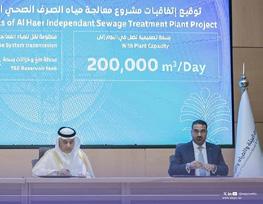
in implementing the decisions of the Council of Ministers and achieving the goals and plans of the Ministry to showcase water production and wastewater treatment projects in the various regions of the Kingdom in front of investors.”
The project’s concession will span 25 years, aimed at reducing operational costs and enhancing the percentage of local content in both business and human resources, Al Quraishi emphasized. Commercial operations are slated to commence in the fourth quarter of 2026, he concluded.
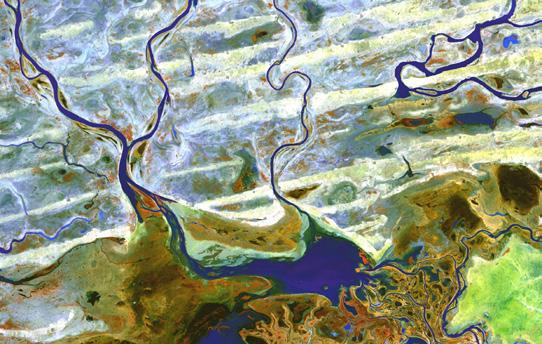
The Digital Twin Earth Hydrology Platform, a ground-breaking step toward a virtual replica of the terrestrial water cycle, combines new high-resolution satellite observations and cutting-edge modelling to build a test environment for our planet. As the climate crisis unfolds and human impacts on the water cycle increase, the exceptionally detailed and complex modelling — incorporated in a simulation tool anyone can use — demonstrates the technology’s potential for managing water resources and mitigating water-related natural disasters.
The water cycle looks simple in theory — but human impacts, climate change, and complicated geography mean that in practice, floods and droughts remain hard to predict. To model water on Earth, you need incredibly high-reso-
lution data across an immense expanse, and you need modelling sophisticated enough to account for everything from snowcaps on mountains to soil moisture in valleys. Now, scientists funded by the European Space Agency have made a tremendous step forward by building the most detailed models created to date.
“Simulating the Earth at high resolution is very complex, and so basically the idea is to first focus on a specific target,” said Dr Luca Brocca of the National Research Council of Italy, lead author of the article published in Frontiers in Science. “That’s the idea behind what we have developed — digital twin case studies for the terrestrial water cycle in the Mediterranean Basin. Our goal is to create a system that allows non-experts, including decision-makers and citizens, to run interactive simulations.”
A digital twin of the Earth, constantly updated with new data, would allow us to simulate best and worst-case scenarios, assess risks, and track the development of dangerous conditions before they occur. Such information is vital for sustainable development and protecting vulnerable populations.
To build their digital twin models, Brocca and his colleagues harnessed extraordinary volumes of satellite data, combining new Earth observation data that measures soil moisture, precipitation, evaporation, river discharge, and snow depth. These newly available data, crucial to the development of the model, include measurements taken much more frequently across space and time: as often as once a kilometre and once an hour. Like a screen with more pixels, higher-resolution data creates a more detailed picture.
The scientists used these data to develop their modelling, and then integrated the modelling into a cloudbased platform which can be used for simulations and visualizations. This is the ultimate goal: an interactive tool anyone can use to map risks like floods and landslides and manage water resources. “This project is a perfect example of the synergy between cutting-edge satellite missions and the scientific community,” said Brocca. “Collaborations like this, coupled with investments in computational infrastructures, will be crucial for managing the effects of climate change and other human impacts.”
The new location will enable Aganova to respond promptly to the market’s specific needs through innovative and sustainable solutions
Aganova, a pioneering technology company in pipeline inspection to prevent water losses, has announced the opening of its new office in Dubai, United Arab Emirates. This strategic expansion marks a significant milestone for Aganova, consolidating its presence in the region and strengthening its commitment to water efficiency and sustainability in one of the driest regions on the planet.
With extensive experience in the region, Aganova has undertaken projects in both the UAE and Qatar, working closely with
significant water management entities. These experiences have demonstrated the value of Aganova’s technology in diagnosing critical infrastructure, generating high interest among key players in the sector.
A notable example was the project implemented by the Dubai Electricity and Water Authority (DEWA), where their pipeline network was inspected using the Nautilus system, Aganova’s in-line technology that navigates along the pipe and collects information about any anomalies and incidents in the network. This
Xylem Watermark combines the expertise of colleagues and partners, and technology, to catalyse impact on critical water challenges
More than 2 billion people lack access to safe drinking water, and nearly half of the global population does not have safe sanitation. The UN’s Sustainable Development Goal 6 – clean water and sanitation for all – aims to close this gap.
In 2023, volunteers from Xylem, its partners and customers supported 1,000 nonprofits, including Americares, Mercy Corps and UNICEF*, to help deliver WASH access and education for communities in 56 countries through Xylem Watermark, the Company’s social responsibility program.
“UNICEF is working to ensure equitable access to WASH through cost-effective interventions and the private sector is pivotal to delivering on this goal,” said Michael J. Nyenhuis, President and CEO, UNICEF USA. “Programs like Xylem Watermark, which bring together cross-sectoral expertise to drive innovation, are helping us to move faster and scale solutions to achieve SDG6.”
“Xylem Watermark draws on the collective power of Xylem’s team, our customers, channel partners, suppliers, and
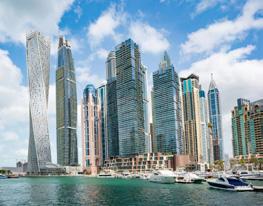
project not only saved millions of litres of water but also increased production and operational efficiency.
Following this new achievement for the company, Aganova’s CEO, Agustín Ramírez, emphasizes the importance of this opening in the Middle East, stating that their goal is to directly serve one of the most relevant markets for the company. He highlights the vitality of this market, characterized by constant growth in water infrastructure and a vision of preventive maintenance.

the nonprofit community, to further our mission to solve water. Together, we have a unique opportunity to advance water security for all and our colleagues and partners continue to step up for SDG6,” Austin Alexander, VP of Sustainability and Social Impact at Xylem, said.
Xylem Watermark contributes to Xylem’s 2025 Sustainability Goals of providing access to water and sanitation, providing water and WASH, and giving 1% of profits and 1% of employee time to water-related causes and education.
The Zuluf Water Treatment Plant is the first outsourcing of a water project under a PPP agreement that Aramco has launched
In an event attended by representatives from Aramco, Almar Water Solutions, part of Abdul Latif Jameel Energy, Al Jomaih Energy & Water, and Fisia Italimpianti, the groundbreaking ceremony for the Zuluf Water Treatment Plant highlighted the advancements of the transformative project in the Arabian Gulf.
Keynote speakers from each participating company shared their insights and visions for the Zuluf project during the ceremony. Symbolizing unity and commitment, a symbolic act took place, in-
cluding the burial of the foundation stone for the Zuluf Water Treatment Plant. The poignant ceremony highlighted the collaborative efforts of all stakeholders in bringing this visionary project to life.
Attendees were treated to an exclusive preview of the project’s advances, showcasing the cutting-edge technology and infrastructure that will make the Zuluf Water Treatment Plant a beacon of sustainable water management.
Carlos Cosin, CEO of Almar Water Solutions, stated, “The Zuluf Water
With an overall budget exceeding one billion dollars, the project also receives backing from the French Public Investment Bank
French firm Saint-Gobain Pam secures a contract to provide pipes for Angola’s Bita drinking water megaproject, valued at over one billion dollars.
The Luanda Bita Water Supply Guarantee Project stands as one of sub-Saharan Africa’s largest ongoing initiatives for clean water access. According to the World Bank: “The project consists of one component, first phase of the Bita Project, which will develop water supply infrastructure to supply currently unserved urbanized and urbanizing areas of South Luanda.”
This achievement marks a milestone for Saint-Gobain Pam, as the company clinches the deal to furnish “all products” required for the Bita project. Covering a vast scope, the contract entails supplying a staggering “15,000 tonnes of pipes, most of them large-diameter”, informed the French company on their social media channels as well as highlighting that “3.8 million inhabitants are soon to be connected to drinking water thanks to PAM solutions.”
In 2021, Suez was selected along with partners Mota Engil and Soares da Cos-

Treatment Plant is more than a project; it is a testament to our dedication to providing clean water to the broader region.”
Under the auspices of the 25-year BOOT (build, own, operate, and transfer) scheme, the Zuluf Water Treatment Plant will boast a substantial capacity of 185,000 m3/day, contributing significantly to sustainable water solutions in Saudi Arabia. Almar Water Solutions is collaborating with a consortium comprised of Al Jomaih Energy and Water Co. (AEW), Fisia Italimpianti, and Aquatech International.

ta to implement the project. This initiative aims to bolster the water infrastructure in the Angolan capital, Luanda. Among the planned infrastructures is a pumping station along the Kwanza River, facilitating the transportation of raw water through pipelines to a newly constructed drinking water plant with a capacity of 260,000 cubic metres per day. This plant will be one of the largest in sub-Saharan Africa, serving approximately 3.8 million people in the province of Luanda.
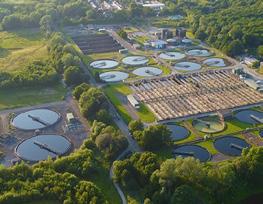
Dubai Municipality has issued invitations to engineering, procurement, and construction (EPC) companies to prequalify for contracts under the multibillion-dollar Dubai Strategic Sewerage Tunnels (DSST) project.
Fahd Al Awadhi, Director of Drainage & Services in Dubai, announced that the DSST “will be executed in four stages, including Jebel Ali Tunnels (North) & TPS, Jebel Ali Tunnels (South), Warsan Tunnels, TPS, Links, and Jebel Ali Links.”
“The RFQ process comprises two phases: an EPC Contractor RFQ phase, succeed-
ed by a full Consortium RFQ phase. We welcome all interested EPC Contractors to apply for pre-qualification in the second phase of the RFQ process and subsequently participate in the bidding process.”
The project, worth approximately AED 80 billion ($21.8 billion), aims to transition Dubai’s existing sewerage system from a pumped system to a gravity system by decommissioning current pump stations and establishing a sustainable, innovative, and reliable service for future generations.
The system will be capable of 3,650 metric tons of CO2 removal per year while producing 105 metric tons of carbon-negative hydrogen
Following the launch and operation of two pilots in Los Angeles and Singapore in 2023, UCLA and Equatic are scaling up for the next phase: a US$20 million full-scale demonstration plant in collaboration with PUB, Singapore’s National Water Agency. The demonstration plant will be co-funded by PUB, the National Research Foundation (NRF), Singapore, and UCLA’s Institute for Carbon Management (ICM).
Over the next 18 months, a multi-disciplinary team comprising researchers
and technology-scaling experts from the ICM)and Equatic will set out to build the world’s largest ocean-based carbon dioxide removal (CDR) plant at PUB’s research and development facility in Tuas, located in western Singapore. At full scale, Equatic-1 can remove as much carbon dioxide as what nearly 850 people emit annually.
PUB has set a target to achieve net zero emissions by 2045 and takes a threepronged strategy to Replace, Reduce, and Remove carbon emissions and close its carbon loop. Besides replacing fossil
The Council said that the project has been designed to serve the needs of the Dubai population for the next 100 years in alignment with the Dubai Economic Agenda D33 and the Dubai Urban Plan 2040.
Last year, Dubai Municipality appointed advisers for the project, including Abu Dhabi-based Tribe Infrastructure Group as lead and financial adviser, UK-based Ashurst as legal adviser, and US-based Parsons as technical adviser.
Interested companies may access the first phase of the RFQ process
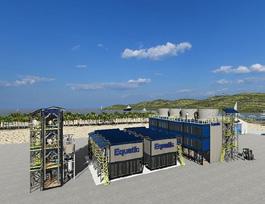
fuel sources with renewable solar energy and investing in research and development to reduce the energy required in water treatment processes, capturing and removing carbon released into the atmosphere is a key thrust of PUB’s decarbonisation strategy. This collaboration with UCLA and Equatic is part of Singapore’s broader efforts to source for novel technologies, such as carbon capture, utilisation and storage (CCUS), which could contribute to mitigating the impacts of climate change.
“There is always an investor willing to put money to work in a performing asset”
Natixis Corporate & Investment Banking (CIB) recently announced the closure of financings of close to $1 billion for two water assets in Chile: the Aconcagua desalination plant and pipeline, which will reduce inland water use by industry and thus help to mitigate water scarcity.
With more than 20 years of experience in infrastructure and a background in civil engineering, Aitor Alava started his career on the project sponsor side, gaining knowledge of the infrastructure asset class. Moving on to the financing industry, he worked for Fortis Bank and BNP before joining Natixis CIB 12 years ago as head of infrastructure and energy finance for Spain and Portugal. Shortly after joining the Natixis CIB team in New York a decade ago, he started leading the franchise for Natixis CIB infrastructure for Latin America. In this interview, he discusses the firm’s involvement in infrastructure financing in this region of the world, and particularly the current situation and emerging trends in water asset financing.
Can you tell us about Natixis CIB’s involvement in infrastructure financing in Latin America?
"We see a huge need for infrastructure investment in Latin America, and we see this trend growing, particularly with respect to the water sector"
Natixis CIB infrastructure and finance in Latin America covers different sectors: power and renewables, transportation, water, social infrastructure, digital infrastructure, mining and midstream. So, it is a broad scope of infrastructure.
In Latin America, we mainly focus on U.S. dollar-denominated transactions. Depending on the country, there is an international market to finance projects under both loan and bond formats covered mainly by international banks like ours, but also there are local market solutions provided by local banks and investors.
We primarily focus on five countries, although sometimes we go beyond that: Chile, Peru, Colombia, Brazil, and Mexico. We have analysed and/or closed transactions in other countries like Uruguay, and Panama but we tend to stay in investment-grade countries where we have a local presence.
We see a huge need for infrastructure investment in Latin America, more than in other parts of the world, and we see this trend growing, particularly with respect to water. I think water will be an important theme in the region for years to come. Mining processes consume a lot of water, and there is social awareness of
water scarcity, so I do see a number of deals in Chile that will require mines to source their own water, and that will be done through desalination or other water solutions, through seawater pipelines.
This is a development that we will probably also see in the future in other countries where mining is prominent, such as Peru. In the water realm, there is a huge need not only for desalination, but also for wastewater treatment. Generally, there is a need for further investments in wastewater treatment plants in the region and plans to do so in some countries, like Colombia, Peru, and Brazil.
What is the significance of the water sector in the infrastructure space, and in particular desalination projects?
Regarding desalination, for the time being, I see a focus on industrial processes because the cost of water in desalination projects is usually high, so you need an economic rationale for it to make sense. In the near term, most desalination projects would be associated with industrial processes, mining being the most obvious example.
Most of the mines need to use desalinated water, although it depends on how they have structured their production process. Some mines can operate with seawater, for example, the Centinela mine 70% owned by Antofagasta, but it depends on whether mines have made the necessary CAPEX investment to protect equipment from salt and corrosion.
I do not expect to see desalination projects to produce water for human consumption in the region for now. Probably the country that is ahead in terms of meeting mining water needs with desalination is Chile, where Natixis CIB led the closing of an almost $1 billion investment for a desalination and water pipe transaction last December. We’re

" In the near term most desalination projects would be associated with industrial processes, mining being the most obvious example"
working on another deal and are engaged in discussions with two other clients who are proposing similar solutions for other mines in the country.
Natixis CIB successfully closed two senior secured financings amounting to $883 million for two water assets in Chile. Do you anticipate more activity in this sector in Chile? What about in the rest of Latin America?
In Chile there is a huge need for water; they have a perfect combination of water scarcity – Chile has suffered the effects of drought for many years, with the exception of last year, but the trend is there – and a strong social awareness focused on making sure that available water is
primarily used for human consumption and then for agricultural needs.
Moreover, Chile is a copper mine country, and copper is a much-needed mineral for the energy transition in which the world is engaged. We are seeing large new CAPEX investments in mines in Chile, and for all those expansions, permits have a very strict requirement that the mine sources their own water; they are not allowed to use continental waters. Therefore, we expect the number of desalination water deals associated with mines in Chile to continue to grow.
Regarding the rest of Latin America, I think they are a little bit behind Chile, but again, I will not be surprised if in the
years to come we see something similar happen in Peru, also a strong mining country.
Also, as I mentioned earlier, there is a huge need in the region for wastewater treatment projects. This might take longer because, by design, they are largely publicly procured; you need a public entity to launch a tender process. By
"Chile is a copper mine country, key for the energy transition: we expect desalination and other water deals associated with mines in Chile to grow"
"Water projects should always have strong social and government support because they alleviate a major issue – water scarcity"
contrast, the deals we are seeing right now in the water sector are driven by the private sector, when water is needed to increase industrial production like in the case of a mine.
What role does Natixis CIB play in facilitating public-private partnerships (PPPs) or other collaborative models for water asset financing?
I think this applies to public-private partnerships and also to private partnerships. We are experts in the infrastructure asset class; the bank has been doing this for many years. We are an Infrastructure one-stop-shop bank that provides debt, bond, financial advisory and M&A solutions for large and complex infrastructure transactions. We have an extensive network of professionals across the globe, there is a strong expertise of infrastructure as a class at all levels of the bank, including senior management, and the risk department. When you are knowledgeable about something, you feel more comfortable, so it’s probably one of the businesses the bank is most
"A stable regulatory environment is the cornerstone for any nonrecourse infrastructure project; without this, it is difficult to structure a transaction"
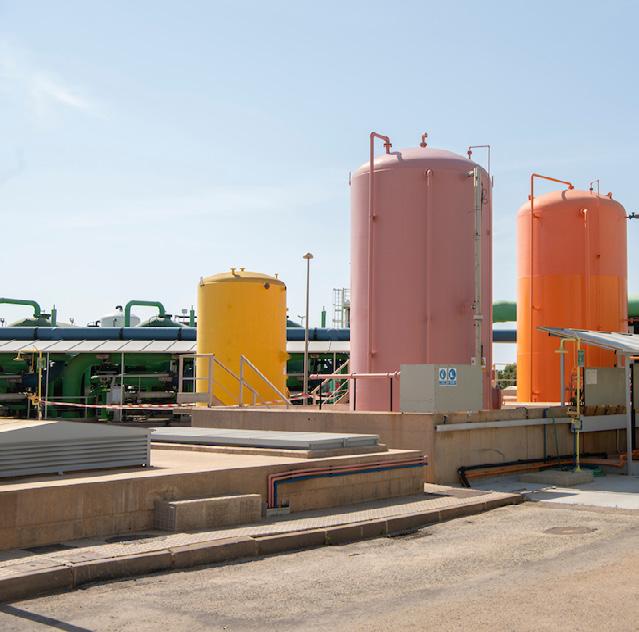
comfortable with and, at the same time, our leadership is recognized by the market. We tend to focus on transactions, including water transactions, in which we can add value. We always lead the structuring of the transaction; for example, on the water deal we talked about, Aconcagua in Chile, Natixis CIB was one of the four lead banks.
Our role is to underwrite deals, giving clients certainty of execution; eventually, after closing, we will look to syndicate this through different channels. We can behave like most of the banks when it comes to distribution, meaning using as the main distribution channel other banks. But in our case, we can also mo-
bilize other pockets of liquidity. In this regard, Natixis CIB has a unique investor partnership model where we have a network of around 10 to 15 investors across the globe with whom we share our pipeline, we share our deals, and we try and mobilize their liquidity to finance the projects of our clients. This pocket of liquidity is a little bit different from the more traditional bond market, which is something that we also do; we have and are currently executing various infrastructure bond transactions in Latin America.
So again, we help with structuring the deal. We help with providing certainty of execution through underwriting; we help
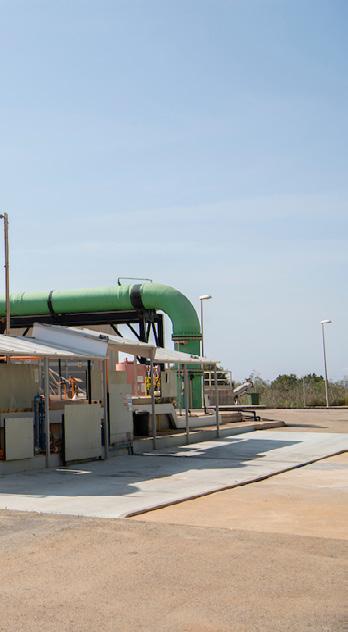 © González-Cebrián/Smart Water Magazine
© González-Cebrián/Smart Water Magazine
mobilize different pockets of liquidity, and we are always product agnostic regarding the best financing solution. Usually, when a client approaches us with a project, there are two types of solutions: solution A with banks, and solution B, a capital market bond solution. We always present the pros and cons of both solutions because we feel comfortable with our ability to execute either. Some banks are very strong in one category and not in the other, and they tend to recommend solutions in the direction they prefer regardless of the best interests of their clients. We are very strong in both, and we recommend the approach that in our opinion makes the most sense for the cli-
"Everything that reduces uncertainty and gives stability allows to raise more competitive financing thus reducing projects overall costs and a lower cost for end-users"
ent, for the project, for a particular time in market – and not what suits us best. We also provide financial advisory services to our clients to help them raise the financing needed and come up with an optimal financing structure. Also, when it comes to M&A in the infrastructure asset class, we have a network of boutiques across the globe. Whereas a lot of banks will deploy their in-house M&A teams, Natixis CIB’s strategy has been to build a network of M&A partners in key geographic areas and markets. We have approximately 10 of them worldwide: in France, the UK, Spain, Australia, China, and the U.S. And in the case of Latin America, we have a partnership with Tyndall in Chile. Our rationale is that by partnering with these boutique M&A firms – most of them majority owned by Natixis CIB – we are able to approach M&A in a comprehensive manner across the globe. There is also the benefit of the entrepreneurial spirit of these M&A boutiques; they are more agile, and more flexible than if they were inside a big organization – yet, at the same time, each can leverage their product offering to clients thanks to the collective network effect of all these M&A partners. As I mentioned, all our M&A boutiques, except for Tyndall, are owned by Natixis. This network of M&A boutiques around the world also allows us to leverage local knowledge of their respective markets, for the benefit of the client and the transaction.
So this model makes us a bit different. Regarding the infrastructure class, which is something very relevant for Natixis, M&A is a space where we are very active.
In your experience, what are some of the key considerations for assessing water assets in Latin America?
One important element is having a clear permitting process. Some of the deals have been delayed because it has taken a long time to secure the various permits, especially environmental permits. It depends on the country, but in the case of Chile this can be a complex process, so if there is a willingness and a need to mobilize capital and build more projects, it is important to have a very clear understanding of what’s involved.
Secondly, because there isn’t a market in which we can attach a value to water, all these projects really depend on an off-take contract. This means we need a bankable off-take contract with an investment grade off-taker and one long enough to allow meaningful amortisation of the asset. It must have adequate
"Our role is to underwrite deals, giving clients certainty of execution; after closing, we will look to syndicate this through different channels"
"Some of the deals have been delayed because it has taken a long time to secure the various permits, especially environmental permits"
termination provisions because usually these assets are stranded, in the sense that, you are building an asset for a certain off-taker; if that off-taker does not honour its obligations, you don’t have a liquid asset that you can sell to somebody else. That is why it is very important to have strong termination payments and a credit worthy off-taker.
I think that those are probably the two most relevant considerations. Obviously, you need an experienced sponsor. If you have projects that tick these boxes, there is always going to be liquidity to finance these projects. Water projects should always have strong social and government support because they alleviate a major issue – water scarcity.
How do you see the evolving regulatory and policy landscape in Latin America impacting the financing environment for water infrastructure projects?
Most of the water deals that we have seen and are seeing in Latin America involve
"Because there isn’t a market in which we can attach a value to water, all these projects really depend on an off-take contract"

© González-Cebrián/Smart Water Magazine
the private sector, with the involvement of public authorities limited to granting the necessary permits like environmental approvals. However, a stable regulatory environment and a stable policy are the cornerstones of non-recourse infrastructure; without that, it is very difficult to structure a transaction.
To the extent that we start seeing more water deals that require heightened involvement by the government, for instance, a wastewater treatment plant that has a contract with a public entity which manages water services for a large city, it is key to have stable regulation, because otherwise the financing will not be possible on a non-recourse basis and the only way to do that will be with full recourse
to the sponsors. This would increase financing costs, making it more expensive for the end-users.
At the end of the day, not having clear rules has a cost for authorities or for users in the form of a higher cost of water. Everything that reduces uncertainty and provides stability will allow for the opportunity to raise more competitive financing, thereby lowering the overall cost of the project.
Are there any emerging trends concerning project financing approaches in Latin America?
There are two dimensions to this question. The first dimension concerns the sectors where we see more activity, and
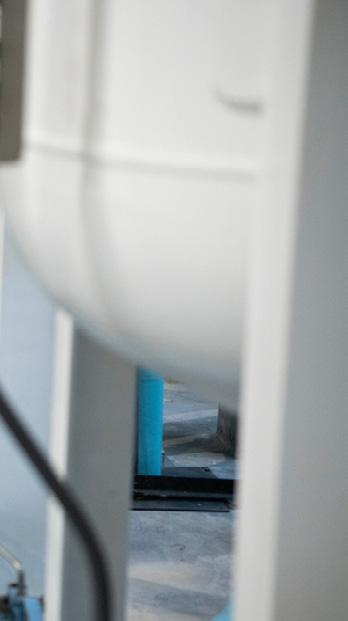
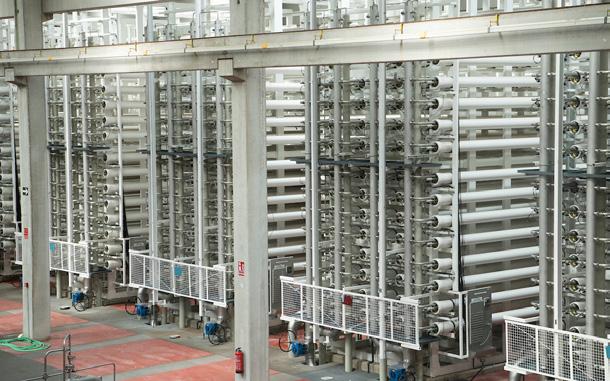
projects in Latin America. The third one, I would say, is water. Water is emerging dramatically as a key priority in the region, and this will only continue due to, as we discussed earlier, the current scarcity of water and because of the strong social awareness surrounding the responsible use of water.
I’m happy to say that one of them is water. But I will start by saying that probably we will keep seeing a lot of activity in renewables. This is not a surprise, as the whole world is in an energy transition, building more renewable capacity, and Latin America is not an exception. I also believe Latin America needs investment in power base load technology, not just renewables, depending on the country, because it is a region with a lot of hydro. This is great when you have water, and it is very cheap. However, when we don’t have water you will have a big problem, so you need a little bit of base load to balance the volatility of hydro.
Another sector is digital infrastructure; we have seen several data centre and fibre
The second dimension of project financing trends concerns financing structures. As I indicated, there are bank solutions and capital market solutions. Typically bank solutions are better designed for the construction phase, for greenfield assets. Then, once a project is built, you will do a takeout in the capital market with a long-term bond. This is why most of the structures we see in the region from a bank perspective are mini-perms; you give a client five to seven years and after construction they will refinance. Sometimes we’re also seeing hybrid solutions in which you combine banks and investors in one transaction.
At one point in time, when clients approached mini-perm structures, there was concern regarding refinancing risk. I think the more they get to know the asset class, they understand the natural reduction in risk as an asset enters the
operational phase and they become familiar with options that the bond market offers. They feel more comfortable with their projects’ ability to refinance, of course, if their transaction is performing. There is always an investor willing to put money to work in a performing asset. So, whereas previously clients would say they would only look at 20-year financings, that is not the case nowadays and fears over refinancing risks have moderated. And like clients becoming more comfortable with mini-perm structures, I would note that banks are as well, and it is what banks are encouraged a bit to do from a regulatory point of view. If banks can only raise financing for let’s say ten years, the regulator tells us that we should not grant a loan for longer because banks need to match assets and liabilities.
"At the end of the day, not having clear rules has a cost for authorities or for users in the form of a higher cost of water"
Variable speed drives (VSDs) enable water pumps to adjust their speed according to the real-time demand for water. Not only do they enhance energy efficiency, but also serve as a powerful tool in conserving valuable water resources by helping to address pressure transients and leakages.
Meeting escalating water demands is a challenge as old as time. While processes have evolved over the years, so too have the issues. For example, the water industry today faces a rapidly increasing world population, rising energy costs, and an urgent climate crisis.
In this evolving landscape, the industry must constantly look for new ways to create efficiencies, and one critical, long-standing, challenge to address is that of water leakages.
Fortunately, variable speed drives present a promising solution.
Understanding variable speed drives
Variable speed drives (VSDs), sometimes known as variable frequency drives (VFDs) or, simply, drives, control the precise speed and power output of water pumps, reducing energy consumption and preventing potentially damaging pressure surges, thus contributing to efficient, reliable and,
Drives control the precise speed and power output of water pumps, reducing energy consumption and preventing damaging pressure surges
critically, leakage-free water distribution systems.
Water pumps without drives will run at a fixed speed, often operating at full throttle even when demand is lower. This is an inefficient use of energy and it puts unnecessary strain on the machinery. But drives enable water pumps to adjust their speed according to the real-time demand for water. By modulating the motor speed, drives ensure that pumps run at the most efficient rate to match the required flow rates, resulting in significant energy savings and reduced wear and tear on equipment.
How drives can tackle water leakages
So, how exactly can drives reduce, or even eliminate, water leakages?
Firstly, when measuring water wastage, non-revenue water (NRW) is a critical metric, representing the difference between water flowing into the distribution system and the billed volume. NRW encompasses physical leakage, commercial losses due to data errors or theft, and unbilled authorized consumption. Drives excel in mitigating physical leakage, a substantial component of NRW.
Pressure transients, also known as water hammer or hydraulic shocks, are sudden and temporary spikes or drops
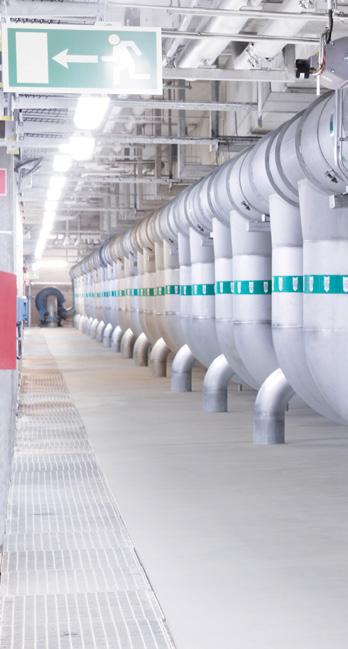
in pressure within a water distribution system. Managing these fluctuations in pressure is vital to mitigating leakages. Water, being incompressible, carries momentum and any sudden alteration in the flow pattern (such as abrupt starts, stops, or redirections) generates pressure waves that travel through the pipes.
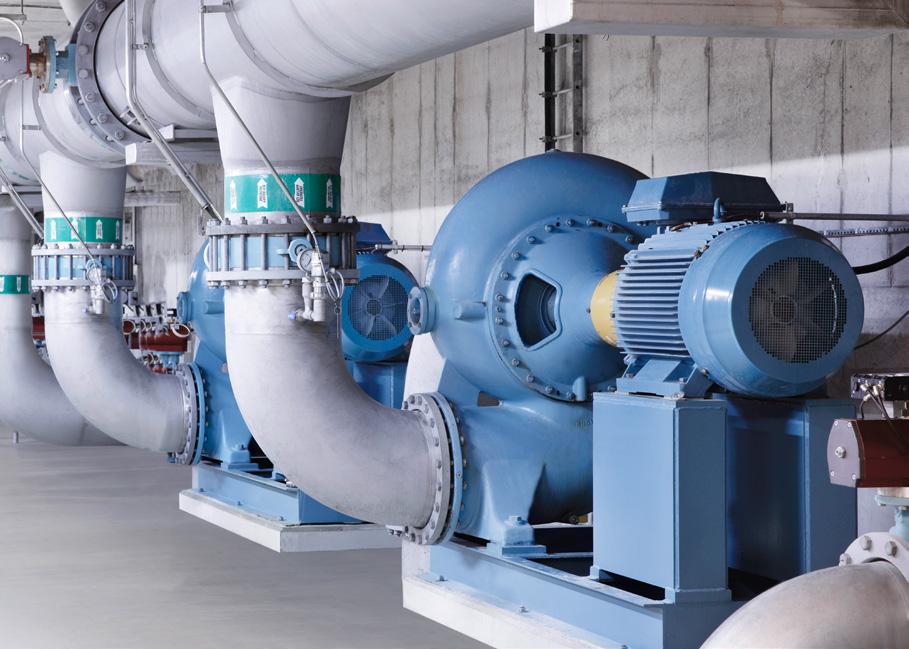
These waves can cause stress on the system, ultimately leading to cracks, bursts and consequential leaks.
While major bursts are often reported promptly, background leaks can be particularly troublesome since they can persist unnoticed, resulting in prolonged and costly losses. It’s no surprise, then,
that pressure transients are a major contributor to NRW.
Implementing District Metered Areas (DMAs) is also essential for leak management in large water networks. By breaking down extensive networks into manageable zones and subzones, leak analysis becomes more effective. Drives
Drives complement DMAs by ensuring controlled flow and pressure within these defined areas, aiding in leak detection and management
Sensors on the drives allow for remote condition monitoring, which means operators can take a smarter approach to maintenance
complement DMAs by ensuring controlled flow and pressure within these defined areas, aiding in leak detection and management.
What’s more, sensors on the drives allow for remote condition monitoring, which means operators can take a smarter approach to maintenance, often referred to as preventative maintenance.
By addressing potential issues, such as abnormal patterns or variations in pressure or water flow within pipes, water companies can address them before they lead to bursts or leaks. The ability to remotely access and maintain these assets is especially important in the water industry, where systems are typically located underground or in difficult to reach places. This preventative approach ultimately helps to avoid potential system downtime, which can be very costly for water utilities.
In certain scenarios, multiple drives can be set up in an energy-efficient multiple control system where multiple pumps operate in parallel. This setup allows for even distribution of wear and tear across
Multiple drives can be set up where multiple pumps operate in parallel, for even distribution of wear and tear and system redundancy
the entire installation and simultaneously provides system redundancy.
However, preventing leaks is not only about reducing NRW and avoiding downtime. By facilitating precise adjustments in motor speed to match the required flow rates, drives play a key role in both conserving water through leakage prevention and optimizing energy consumption by boosting overall system efficiency. These savings are even more valuable in the context of today’s rising energy costs – and with water becoming an increasingly scarce resource.
Before and after: VSDs in action
One water utility company saved over £12,000 annually on one small booster station by installing drives on booster pumps and, in so doing, eliminating burst pipes. The company previously suffered around nine burst pipes a year, caused by pressure wave fractures and leaks.
Two 5.5 KW ABB drives were fitted, providing a soft ramp up and a controlled slow down to maintain supply pressure. Before the drives were installed, pressures were peaking at 140 meters head. Following the installation, maximum pressures were almost halved, at 83 meters head. Before, each burst had cost the company an estimated £1,400 to resolve.
Since the installation, in 2016, the utility has had zero burst pipes. The
drives have also reduced the energy consumption of the pumps. Return on the initial £5,500 investment was achieved in under six months.
A greener, more sustainable water supply Drives not only enhance energy efficiency, but also serve as a powerful tool in conserving valuable water resources. By addressing pressure transients and leakages, they contribute to a sustainable water supply system that meets the growing demands of a rapidly increasing population.
The potential for drive uptake in the water industry is huge. In fact, between 90 to 99 percent of new projects will have drives fitted. This is promising when embracing this technology represents a giant leap towards a greener, more sustainable water supply.
Discover more about ABB’s VSDs as a solution to water leakages:
https://new.abb.com/drives/segments/ water-and-wastewater

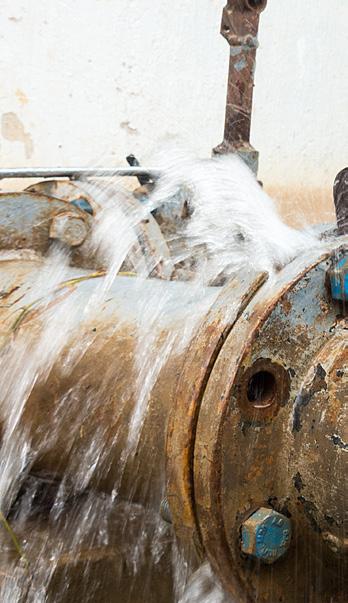
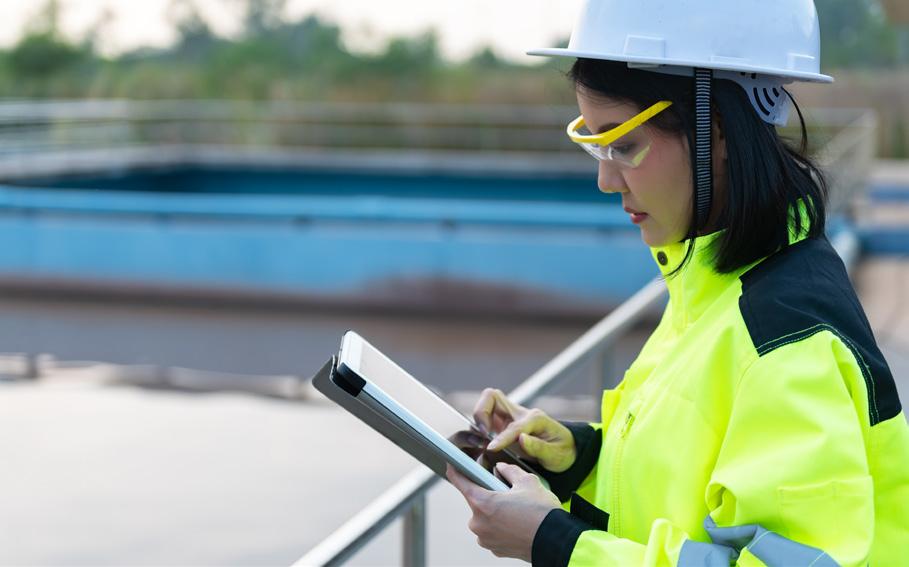

By facilitating precise adjustments in motor speed to match the required flow rates, drives play a key role in conserving water
“The future and independence of all countries are underpinned by water”MICHAEL LESNIAK - VP PARTNERSHIPS AT
Taiwan’s billionaire investments in climate change adaptation aim to future-proof the island’s water-intensive semiconductor industry by tapping into unconventional water sources. We explore this enlightening example to address the water crisis through proper and timely action.
Z Cristina Novo PérezMichael Lesniak’s journey in the water sector spans nearly four decades, characterized by a relentless pursuit of innovation and environmental stewardship. His career commenced as a college intern at the Pennsylvania Department of Environmental Resources, moving afterwards to Nalco in Chicago, at the time a small company specialized in solving difficult industrial water problems. His tenure at Nalco witnessed his ascent to executive roles and international work, especially after the merger with Ecolab, a deal which in he played a key role and was responsible for merging the global field sales and service teams all over the world.
After retiring from Nalco in 2022, Lesniak became a Senior Advisor to the UN CEO Water Mandate, advocating for global water resilience. Last year he joined Aquatech International as Vice President of Partnerships, where he focuses on building close relationships with
"One of the challenges of making silicon chips is that the foundries consume a lot of water and generate a lot of wastewater"
customers to help scale the company into emerging sectors. In this interview, he discusses Taiwan’s investments in unconventional water sources, the impact on its economy, and the role of private companies in solving global water challenges.
Earlier this year Taiwan’s government approved a $13 billion investment in climate change adaptation for the next four years, including the development of unconventional water sources. Can you comment on what it will mean for the economy of Taiwan, and the global semiconductor industry?
Taiwan is a relatively small island nation that punches way above its weight when it comes to making semiconductors. They pioneered the idea of silicon “foundries”. When I think foundry, I think of some of my early customers who would melt steel, bronze, or some other metal and pour it onto molds that their customers would send to them, that was my understanding of a foundry. The foundry did not develop the product or even build the final product. The foundry had to be really cost-competitive at melting metal and pouring it into the molds of their customers, since the lowest cost shop won the business. The high cost shops went bankrupt. If a shop decided to compete with their customers, it would usually not end well for the shop.
Taiwan got really good at making silicon chips and using the patterns of their customers; they call these silicon foundries. They never competed with their customers, so they attracted all the semiconductor designers who were making useful end products, and they grew very strong. They invested in their schools, people and supply chain to make sure they could produce the lowest cost silicon “foundry” chips at a lower cost than anyone in the world.
U.S. companies tried to do everything themselves and differentiate themselves with “value” and usually higher cost; they have struggled to compete with Taiwan both on a cost basis and in the usefulness of the end products for mobile phones, cloud computing data centres, and artificial intelligence applications that demand low cost and low energy use. The foundry model won out, and Taiwan enjoys a very high global market share of semiconductors today. Taiwanese people have invested two generations in semiconductor manufacturing and there is tremendous national pride; they broke away from mainland China rule in 1949 and semiconductor manufacturing has provided a good life for them.
One of the challenges of making silicon chips is that it consumes a lot of water and generates a lot of wastewater. Further complicating things, the newer smaller chips are much more complicated, with many more steps that use much more water, and produce much more waste.
Additionally, Taiwan is feeling the impact of acute climate change on their limited water supplies. The monsoon rains do not come like they did in the past, Taiwan is hotter now and the

ground and soil are not holding as much water as in the past, and their reservoirs are filling up with sediment much quicker and holding less water.
The public and government realize they must invest more in water infrastructure if they want to continue to dominate their global microelectronic competitors and be independent and not be controlled by China. They need more water supplies to achieve this, and they must reuse and recycle their water as a matter of survival. Water is a life and death resource; it is very important.
For Taiwan, the new announcement to invest $13 billion in water was an easy decision. They announced they are building more fabs across the country, and smaller chips, and so they need more water. Taiwan wants to survive and remain free, and thus this investment means everything to them. They have partnered closely with TSMC (their homegrown global leader in manufacturing semiconductors) and many other industries strategically connected to the semiconductor supply chain and located in their major industrial parks. They are not proposing anything new or innovative there, everything is tried and proven technology, and they are executing with precision and speed to drive low cost, something they are very good at.
Taiwan’s total package includes the seawater reverse osmosis desalination plants in Hsinchu and Tainan, 106 km of water transmission and distribution pipelines, as well as land use planning and energy supply optimisation, and municipal-to-industrial wastewater reuse in the country’s industrial parks. Taiwan’s ambition to develop unconventional water resources anticipates a total reuse capacity of 334,000 m3/d by 2026, as well as the construction of eight seawater desalination projects with a total capacity of 850,000 m3/d.
What are the enabling conditions for such a high-magnitude investment?
Since the investment is being made by the government, the enabling conditions are threefold: first, they need to have the money to pay for it, to come from tariffs, taxes, and transfers of gross domestic product revenue; second, the ruling party and leadership must have the will and public support to spend the money on water infrastructure; and lastly, the country leadership must be willing to follow the science of water to ensure quantity, quality, and access within each individual local water basin.
Taiwan leaders have the skill and will, in addition to the money, public and private support from their industrial stakeholders, and the right science. The semiconductor manufacturers obviously support the plan because they cannot survive without it.
What lessons can other jurisdictions learn from Taiwan’s ambition concerning climate adaptation?
"Taiwan’s public and government realize they must invest in water infrastructure if they want to dominate their microelectronic competitors"
The future and independence of all countries are underpinned by water. Without water, there is no economic future, no independence, no life. All societies can follow Taiwan’s lead and regularly invest a portion of their gross domestic product revenue and taxes, and charge citizens and companies appropriate tariffs to maintain water systems and supplies appropriately, but unfortunately, that is unlikely. Many countries have other problems like war, famine, monetary disruption, corruption, and inequality which get in the way of them making good water decisions.
Water infrastructure is typically a very large long-term CAPEX investment, and may take years to complete. The role of leadership is to foresee problems and address them before they become big problems. Singapore, United Arab Emirates, Israel, Sydney, and some cities in the U.S. like Santa Clara, or San Antonio are other good examples to learn from.
Leaders can learn that water solutions today require a robust set of solutions, and not a one size fits all. Taiwan’s plan involves strengthening fresh water supplies through desalination and reuse, strategically aligning and locating fresh water and recycled resources within their land use plan, population growth and agricultural ambitions. The plan includes investment in transmission pipelines which is brilliant because transmission is a very important part of the solution for Taiwan.
You are advising the UN CEO Water Mandate’s strategy for the Water Resilience Coalition (WRC). Can you tell us about the WRC’s approach and process?
The ambition is to achieve positive water impact in 100 global water-stressed basins that support over 3 billion people and to enable equitable and resilient water access and hygiene for over 300 million people by 2030. Four main approaches are being used to
achieve the ambition and they include scaling proven solutions, advancing innovation, leveraging finance, and measuring impact.
There are now about 45 CEOs that have made the pledge to achieve Net Positive Water Impact in water-stressed basins and agreed to develop, implement, and enable strategies for water-resilient value chains to raise the global ambition on water. The CEOs are working collectively to scale their resources and achieve their ambition in key U.S. basins like California and the Mississippi and other basins around the world where they collectively do business.
What value do private firms contribute to taking action on water issues, locally and globally?
Businesses have human, physical, and economic resources that can be catalytic and complimentary to help governments succeed if, where, and when they need help solving problems. Most citizens expect their government to provide the proper water quantity, quality, and access for their needs. We know that is not happening perfectly everywhere, especially as weather and climate disrupt plans that may have worked five or ten years ago. The CEOs in the Water Resilience Coalition offer up their resources to help governments and citizens. The actions vary from country to country, no one size that fits everywhere. Water problems are usually very complex and involve many stakeholders, so businesses need to understand their role and insert themselves when and if needed.
The main wins so far are collective actions that compound individual private sector contributions in basins through government support and ministerial participation, multi-sectorial collaboration and allocation of funds to support the implementation of improvement actions. The WRC has also established collective funding mechanisms that act as a channel towards scalability and
"Taiwan anticipates total reuse capacity of 334,000 m3/d by 2026, as well as eight desalination plants with a total capacity of 850,000 m3/d"
sustainability. The funds have helped channel investments in numerous areas from natural conservation or restoration to water access, sanitation, and hygiene while strengthening water governance by bringing together relevant stakeholders - and providing sound scientific knowledge to facilitate the decision-making process.
Other key wins have been the removal of departmental barriers and to promote coordination across sectors – such as agricultural, financial, energy, planning, private and NGO actors.
Do you think businesses give enough emphasis to water-related risks? What trends do you see in corporate water sustainability?
Large public businesses that have an obvious dependency on water do a very good job of managing their water related risks. Think of large global beverage companies like Coke, Pepsi, Diageo, AB, or Nestle. These types of companies have been working on water risks from the beginning of their first business plan. They essentially put water in a container and generate profits from water. It’s pretty easy to understand. If you run out of water, you cannot make profits.
The latest trend is for all companies to look more seriously at water sustainability. Most consumers are starting to realize their clothing, food, electricity,

cell phone, transportation, government, education, and housing are highly dependent on water, especially young consumers who are paying close attention to sustainability. The latest trend is to look at water use throughout the entire supply chain and take ownership of making sure people have the water they need, including the poorest and most in need.
A recent study completed by Ecolab showed that across the general population, access to clean and safe water is a significant climate concern and consumers are holding governments and industries most responsible for water conservation, and they are willing to do their part to help. Consumers feel that businesses lack clarity on how to address the water crisis but be-
lieve that the crisis can be addressed with proper and immediate action. Consumers in China feel this way the strongest.
Smart governments and businesses are tuning in to this feedback from their constituents and customers, this is the new trend and the business risk that companies and governments are trying to manage.
"Leaders in Taiwan have the skill and will, in addition to the money, public and private support, and the right science, for a $13 bn investment"

In today’s environmentally conscious world, sustainability has become a central focus across industries. However, the metal finishing sector faces unique challenges when it comes to environmental responsibility as its processes are complex and generate significant volumes of wastewater. With tightening environmental regulations, it’s crucial for metal finishing to implement innovative sustainable solutions for waste reduction and treatment and meet the growing demands to reduce its environmental impact.
The importance of sustainable wastewater management
Metal finishing encompasses a range of processes aimed at enhancing the surface properties of metal products, from providing corrosion resistance to improving overall aesthetics. These processes, including cleaning, plating, coating, and surface treatment, are integral to various industries such as automotive, aerospace, and electronics, where the quality and appearance of metal parts are paramount. Yet, these processes also result in substantial wastewater loaded with various chemicals, heavy metals, and pollutants. Without proper treatment, this wastewater poses significant environmental risks, potentially contaminating water bodies and ecosystems.
Industrial wastewater treatment best practices
Process optimization: implementing sustainable wastewater treatment practices in metal finishing begins with process optimization. Utilizing methods that prioritize resource recovery and minimizing energy usage, such as membrane filtration and electrochemical treatment, effectively removes pollutants from chemical baths and rinses. This reduces materials sent to wastewater for treatment, lowering water discharge and chemical consumption, thus reducing the environmental footprint.
Measures and monitoring: To effectively manage wastewater sustainably, organizations must implement proactive measures to tackle environmental challenges and maintain regulatory compliance. Additionally, there should be a commitment to continuous improvement. It is essential that organizations stay informed of evolving environmental regulations and strive to exceed minimum requirements. This begins with implementing best practices and in-
vesting in ongoing monitoring and optimization efforts. Through demonstrating a commitment to responsible stewardship, organizations can enhance their reputation and build trust with stakeholders.
Trust, collaboration, and knowledge sharing are fundamental for advancing sustainable wastewater treatment practices. Water treatment professionals possess extensive expertise in navigating complex environmental regulations and customizing treatment solutions for specific waste streams. By leveraging this knowledge, organizations can refine treatment processes that neutralize harmful substances in a precise and cost-effective manner.
Industry associations, government agencies, academic institutions, and technology providers facilitate the exchange of ideas,
"Methods prioritizing resource recovery and minimizing energy usage can effectively remove pollutants from chemical baths and rinses"
promote research and development, and provide guidance on implementing sustainable solutions. Harnessing their collective expertise accelerates the adoption of environmentally sound practices and drives positive industry change.
Sustainable wastewater treatment practices are vital for the metal finishing industry in addressing environmental responsibility, compliance goals, and stakeholder expectations. By optimizing processes, collaborating, and ensuring transparency, companies can reduce environmental impact, enhance efficiency, and demonstrate environmental stewardship. The metal finishing industry plays a pivotal role in driving positive change toward a sustainable future where economic prosperity aligns with environmental protection.

Algal blooms are a common problem in numerous water bodies across the United States, especially during summer months. These blooms cause unsightly scum in water, which can present various challenges for the community (i.e., colour, odours, etc.). For water providers, blooms can present many drinking water treatment challenges, including difficulty in the removal of taste and odour compounds. This can lead to increased treatment and infrastructure costs and in some cases possible disruption of water supply.
Additionally, blooms can cause human and animal health concerns. Numerous algal species are known to produce many groups of toxins. Some examples of toxins include: hepatotoxins, neurotoxins, cytotoxins, dermatotoxins, etc. In freshwater cyanobacteria often produce these toxins (known as cyanotoxins). Common cyanotoxins include: microcystin, cylindrospermopsin, anatoxin, guanitoxin (previously anatoxin-a), saxitoxin, nodularin, lyngbyatoxins. Some toxins have many variants (e.g., microcystin has >200 variants), which makes monitoring and understanding the risks posed by harmful algal blooms (HABs) complicated.
Presently algal bloom monitoring is time-consuming, cumbersome and often requires confirmation with laboratory-based methods, which can be slow and require advanced analytical expertise. Typically, laboratory-based methods employ several different platforms (e.g., enzyme linked immunosorbent assays, liquid chromatography/tandem mass spectrometry (LC-MS/ MS), quantitative polymerase chain reaction). Unfortunately, these tests have various limitations (i.e., lack specificity, sensitivity, are slow, or require highly equipped laboratories with advanced technical expertise, etc.), which often makes it difficult for utilities to identify algal bloom problems in a timely manner.
Considering the combination of potential target analytes (i.e., toxins) and the large surface areas of watersheds that often require coverage, most utilities find it difficult, expensive and time-consuming to conduct detailed monitoring. Water providers need rapid yet specific algal detection methods to help improve their responsiveness (i.e., planning, treatment, and risk mitigation) to bloom events. New monitoring tools are needed that can reliably and cost-effectively provide spatial-temporal resolution to serve as an Early Warning System.
Hyperspectral imagery is an attractive advanced imaging option that employs a wide spectrum (i.e., hundreds of relatively narrow spectral bands, including short wave infrared and visible and near infrared) to generate unique image signatures. Differentiation of targets in various applications (i.e., military, archaeology, forensics), including medicine (i.e., cancerous tissues) and the environment (i.e., oil spills in water, plastic refuse on land/oceans, tree disease/mortality rates) has been achieved successfully. In a recently funded Water Research Foundation Tailored Collaboration program (Project WRF 5266), American Water will partner with Element 84, Hazen and Sawyer and Resolve Hydro LLC to examine the use of hyper- and multi-spectral imaging data from satellites in conjunction with advanced data analytics, based on artifi-
"New monitoring tools are needed that can reliably and cost-effectively provide spatialtemporal resolution to serve as an Early Warning System"
cial intelligence, for early identification of algal bloom events. The hyperspectral imaging information will be benchmarked against other image acquisition sources (i.e., small aircrafts/ drones, microscopy), conventional and advanced chemical/ microbial analyses, including whole genome sequencing. Relationships with in situ measurements, algal proxy (or indicator) measurements (e.g., chlorophyll-a, phycocyanin), a suite of taste and odour compounds and specific algal toxins will also be explored. This benchmarking study will be the first of its kind and is expected to provide a road map for proactive monitoring of algal blooms in the future. In addition to providing rapid monitoring tools, the findings of this research will help water providers by providing them with tools to develop holistic algal bloom management strategies.
Water scarcity is a growing concern for many countries worldwide, and Morocco, with a semi-arid climate, is no exception. The country faces several factors driving water scarcity. Erratic rainfall and frequent droughts leave traditional water sources like dams and groundwater vulnerable. Additionally, climate change projections predict a decrease in precipitation, further exacerbating water scarcity. Population growth, increasing urbanization and agricultural water demands also put a strain on existing water resources. These factors combine to create a situation where traditional supplies are insufficient to meet the water demands of the population, agriculture, and industry.
Water security challenges are compounded by the unequal distribution of water over space and time, with most of the surface water resources concentrated in the northwest of the country. Meanwhile, the Western Sahara in the south, a disputed and non-autonomous territory according to the United Nations and under Moroccan administration, has almost non-existent conventional water resources.
According to World Bank data, in Morocco, the agricultural sector – responsible for 14% of the country’s GDP - accounts for almost 88% of total national water demand. Reduced water availability and lower crop yields due to water scarcity could reduce GDP by up to 6.5%. In this context, the government is encouraging a transition to unconventional water sources, such as desalinated seawater or the reuse of treated wastewater, as a viable strategy to augment the available water supply and provide a reliable source of freshwater independent of rainfall patterns.
Major government actors in water resource management in Morocco include the Ministry of Equipment and Water and the National Office of Electricity and Water (ONEE). The first one determines governmental priorities and invests
in large infrastructure projects. ONEE, operating under the Ministry of Energy Transition and Sustainable Development, is the national water and electricity utility, responsible for the provision of drinking water and wastewater services, focusing on ensuring access to drinking water, especially in rural areas, diversifying production sources, and controlling water demand. In addition to ONEE’s role in
the water sector, private companies are responsible for drinking water delivery and distribution in some cities.
In 2020 the Moroccan government, as part of its National Water Plan (PNE or Plan national de l’eau) for 2020-2050, launched the National Programme for Potable Water Supply and Irrigation 20202027 (Programme national d’approvisionnement en eau potable et d’irrigation or
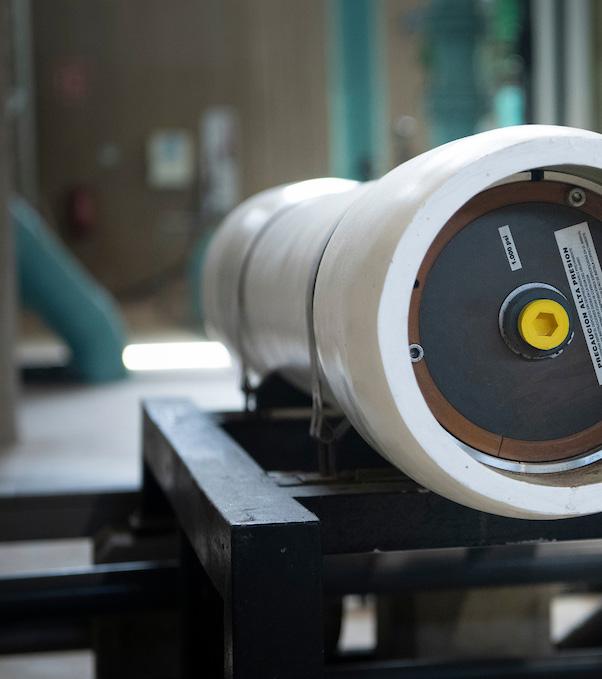
With a semi-arid climate, uneven rainfall patterns, and a burgeoning population, securing a reliable water supply is a critical challenge in Morocco. Desalination emerges as a key element of the government’s strategy to ensure water security.
Z Cristina Novo PérezPNAEPI). The PNAEPI aims to diversify the sources of supply, guarantee water security, and reduce climate change impacts by accelerating investments to strengthen water supply for drinking and irrigation uses. In May 2023, the government increased the programme’s budget allocation to US$14.3 billion.
Last January the Minister of Equipment and Water Nizar Baraka told Par-
liament that water desalination is a priority for managing the water deficit, as reported by the Moroccan news agency, MAP. He added that by 2030, half of the country’s drinking water supply will be sourced from desalination, underscoring the government’s commitment to constructing multiple desalination facilities to achieve a production target of 1.4 billion cubic metres by that date. As per
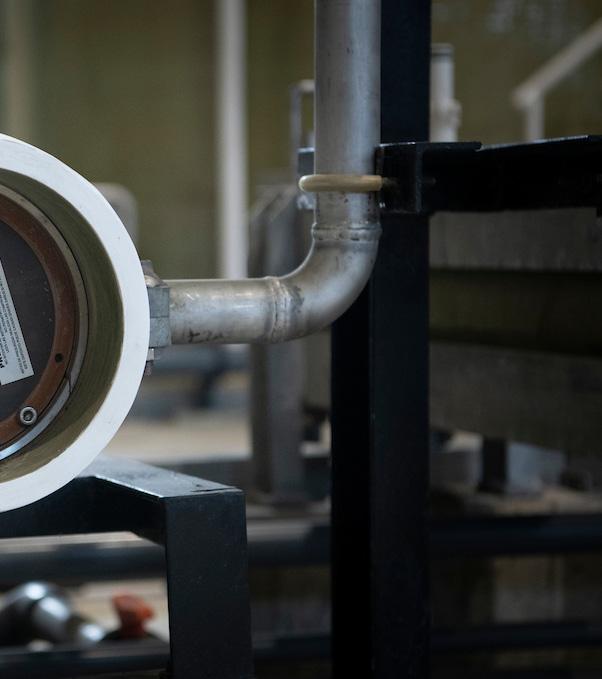
the government’s strategy, coastal towns will source their water from desalination plants, while surface water will be used to meet the needs of inland areas.
Considering desalinated seawater, eleven desalination plants were operational in 2023, according to Spain’s Trade and Investment Institute ICEX Three of them provide water for industry, linked to the OCP (Office Chérifien des Phosphates), and eight facilities supply mainly drinking water, although the Agadir plant also produces water for irrigation purposes. It is anticipated that by 2030 the total number of these facilities will have increased by nine, reaching a total of twenty operational desalination plants. Moreover, at least some of the planned facilities will produce water for more than one purpose, e.g. drinking water and agricultural uses, and drinking water and industrial uses.
Minister Baraka also noted that the OCP will be responsible for the desalination of 560 million m3, with 500 million m3 allocated for agricultural purposes, while the remainder will be used as drinking water. The state-owned OCP Group, a global leader in soil fertility and plant nutrition solutions, is another major player in the desalination space in Morocco. Last February the African Development Bank and OCP announced agreements totalling $188 million to help fund the OCP Group’s Green Investment Program supplying clean drinking water to the towns around three new modular desalinisation plants, with a total annual capacity of 110 million m3. Part of the produced water will be used for OCP’s industrial and mining sites, and up to 75 million m3 of drinking
Morocco is encouraging a transition to unconventional water sources, such as desalinated seawater or the reuse of treated wastewater
The government is committed to constructing multiple desalination facilities to achieve a production target of 1.4 billion m3 by 2030
water will be provided for the towns of Safi and El Jadida and the areas around the OCP Group’s Safi and Jorf plants, benefitting over 1.5 million people.
As part of those agreements, a $20 million loan from the Clean Technology Fund (CTF), will be used to fund storage systems for energy generated from renewable sources, supplying the desalination plants and other OCP Group production units. “Our sustainability objectives aim to achieve 100 per cent unconventional water by 2024, 100 percent renewable energy by 2027, self-sufficiency in green ammonia by 2032, and full carbon neutrality by 2040”, said Karim Lotfi Senhadji, Finance Director of the OCP Group.
Existing desalination plants
The use of seawater desalination and demineralization of brackish groundwater to produce drinking water started in the Saharan areas of southern Morocco, owing to water shortages in these areas. Desalination of seawater and brackish water was an obvious option to increase the water supply given the country’s
The state-owned OCP Group, a leader in soil fertility and plant nutrition solutions, is a major player in the desalination space in Morocco
3,500 km of coastline and a brackish water potential of about 500 million m3, as El-Ghzizel et al. explained in their 2021 study “Desalination in Morocco: status and prospects”. The first brackish water plant, using electrodialysis technology, was installed in Tarfaya, and the first seawater desalination facility – a compression distillation unit – was installed in Boujdour in the 1970s. In the 1990s ONEE started to focus on reverse osmosis (RO) and in 1995 the Laayoune SWRO plant was built. Existing desalination plants have significantly contributed to meeting the water needs of their respective regions, particularly in areas facing acute water scarcity. Some notable desalination facilities are described next.
Laayoune. ONEE built one of the biggest SWRO plants to supply the city of Laayoune in 1995, with a capacity of nearly 7,000 m3/d, expandable to 26,000 m3/d after the completion of two phases in 2005 and 2010. In recent years the facility at this coastal city in Western Sahara underwent expansion to increase its capacity by 26,000 m3 per day for a total production capacity of 62,000 m3 per day in 2022.
Al Hoceima. Designed and built by Tedagua in 2020, the Al Hoceima plant provides drinking water to approximately 150,000 people in the city of Al Hoceima and surrounding areas, on the country’s Mediterranean coast. It is a reverse osmosis desalination plant with a drinking water production capacity of 17,300 m3/day.
Jorf Lasfar. Cadagua (Ferrovial Group) built this desalination plant for OCP’s Jorf Lasfar industrial complex on the country’s northeastern coast, about 120 km south of Casablanca, with a portion of the production intended for the water supply of El Jadida. Initially, with a capacity of 75,000 m3 per day and the possibility of expanding it to 100,000 m3 per day, OCP is planning its expansion to meet its increasing water demand. Agadir. Coxabengoa – before known as Abengoa, renamed as Coxabengoa after
Cox Energy acquired its assets - was awarded the contract for the design, construction, financing, operation and maintenance over a 30-year period (including construction) of this desalination plant in 2017, through a Public-Private Partnership (PPP) with ONEE and the Moroccan Ministry of Agriculture, Maritime Fisheries, Rural Development and Water and Forests.
With a capacity of 275,000 m3/day and the possibility of expansion up to 400,000 m3/day, it is the biggest desalination plant in commercial operation in
Africa, and the largest desalination plant designed and conceived for combined use for drinking water and irrigation worldwide. “It has been successfully operating for more than a year and a half, producing a nominal capacity of 150,000 m3/day of drinking water to supply the population of Agadir and 125,000 m3/day to feed 13,600 ha of irrigation area (15,300 ha in the future)”, explains Coxabengoa, noting as well that the plant “has become a key asset to boost critical sectors in the region such as agriculture and tourism”. Chtou-
ka Ait Baha, the area covered by the irrigation water supply network, produces 65% of Moroccan vegetables and fruits exports.
The facility also promotes the conservation of the aquifers in the area, adjoining the national park of Sous Massa, preventing overexploitation, and contributing to the conservation of flora and fauna.
A future focused on desalination
Recognizing the importance of desalination, Morocco has ambitious plans to expand its desalination capacity. The govern-
Source: Report L’Hydraulic en chi res, June 2023, Ministère de l’Equipement et de l’Eau - By: González-Cebrián/SWM
In Morocco, groundwater is a strategic resource. It accounts for around 20% of the country’s potential water resources. Of the 130 aquifers, 32 are deep and 98 shallow. Based on current knowledge, the exploitable potential of groundwater resources is around 3.9 billion m3.
SURFACE WATER
Morocco currently has 152 large dams with an estimated storage capacity of 19.9 billion m3.
DESALINATION OF SEAWATER
118,700 m3/day
In addition to the 42 mobile desalination plants, Morocco currently has 12 desalination plants with a capacity of almost 118,700 m3 per day and 7 plants under construction or being launched with a capacity of 396,200 m3 per day.
32 million m3
Morocco currently has 41 projects to reuse treated wastewater, enabling a volume of close to 32 million m3 by the end of 2023.
URBAN AREAS
Access to drinking water is widespread, with a production capacity of 1324 mm3/year.
RURAL AREAS
The rate of access to drinking water in rural areas is currently over 98.4%.
ment’s ambitious target of producing 1.4 billion cubic meters of desalinated water annually by 2030 requires significant investment in new plants, with several facilities currently under construction or in the planning stages. Some of the upcoming desalination projects are detailed below.
Casablanca. In 2023, the contract for the design, construction, operation and maintenance of this SWRO plant in Morocco’s largest city, the second largest desalination plant in the world, was awarded to a consortium of ACCIONA with Moroccan companies Afriquia Gaz and Green of Africa. The future plant, to be located about 40 kilometres southwest of Casablanca, will be completed in 2026 and initially provide 200 million m3 of water annually for irrigation and municipal water supply in Casablanca, Settat, Berrechid, Azemmour, and El Jadida. A subsequent phase will expand the facility’s capacity to 300 million m3 annually by 2030.
Dakhla. The contract to build a desalination plant in Dakhla, a coastal city in Western Sahara, has been awarded to Dakhla Water & Energy Company (DAWEC), a joint venture between International Power, the subsidiary of the French group Engie and Nareva, the subsidiary of the Moroccan group Al Mada, which will also operate the facility for 20 years. The plant will have a capacity of 37 million m3 of drinking water per year (100,000 m3 per day). Most of it, 30 million m3, will be used for agricultural irrigation, and the rest to supply drinking water to the city of Dakhla. DAWEC will use wind energy via a wind farm connected to the grid of the ONEE.
Morocco’s future developments are looking to integrate renewable energy sources like solar and wind power into desalination plants
El Jadida and Safi. In 2023 Morocco’s government signed an MoU with OCP to provide desalinated water to the cities of Safi and El Jadida. This memorandum falls within the framework of accelerating the implementation of the National Program for Drinking Water Supply and Irrigation Water 2020-2027. The government decided in February 2022 to develop a complementary program that includes a partnership with OCP for the long-term and sustainable mobilization of water resources through seawater desalination, in order to cope with the exceptional drought situation.
The Ministry of Equipment and Water announced in August 2023 that the desalination plant in Safi had started operations: in 2023, 10 million m3 of desalinated water would be supplied to Safi and 30 million m3 to El Jadida. This volume would gradually increase to reach 30 million m3 per year for Safi and 45 million m3 per year for El Jadida in 2026; in addition, 35 million m3 per year would be used by OCP’s industrial operations. Seawater desalination will be carried out in four units, two of which are located in the Jorf Lasfar industrial site and the other two in Safi.
Nador. Another desalination facility is planned in the city of Nador, on the country’s Mediterranean coast. A tender will be launched for a desalination plant with a capacity of 250,000 m3 per year, Minister Baraka said in October 2023.
Tangier. The government announced in 2022 the assessment study of another desalination project in the northern city of Tangier. Following an initial study phase of two years, a tender would be launched to find the contractors to deliver the project. However, and according to news media, a construction contract signed in February 2023 was later cancelled and stalled due to lack of land.
In addition to those mentioned, further plans for desalination plants are underway. ONEE is planning to build additional seawater desalination plants
in Essaouira and Guelmim, and the Oriental region. The Essaouira plant will have a capacity of nearly 53 million m3 per year, while the Guelmim plant will be able to supply some 35 million m3 of water per year, to be used for drinking water and irrigation. Meanwhile, the plant planned in the Oriental region will supply about 100 million m3 of water per year when it is commissioned, extendable to 200 million per year.
Ongoing and planned projects highlight Morocco’s commitment to desalination as a key strategy for water security. However, while desalination offers a promising solution, it’s not without its challenges. Desalination is energy-intensive, so future developments are looking to integrate solar and wind power into desalination plants, in order to reduce operational costs and decrease their environmental footprint. Additionally, the environmental impact of brine disposal, a byproduct of desalination, needs careful consideration.
Morocco’s plans for new desalination plants include the use of renewable energy sources to power them. Using alternative energies to power desalination is the focus of a partnership being Metito Utilities and Tahliya Group announced last December. The two companies intend to develop a multi-user irrigation project, using desalinated water, in Morrocco.
Another partnership of interest is between Osmosun and the Moroccan industrial group PCS to create Osmosun MA This joint venture will focus on small and medium-capacity desalination projects to supply drinking water to isolated areas across Morocco. Desalination is being implemented for coastal cities to alleviate the water stress of the whole watershed, but also for remote locations to secure access to a freshwater supply, and this is where Osmosun’s expertise and innovation plays a key role in ensuring alignment with green energy goals. “The most cost-effective way to power desalination plants is
with solar energy; the OSMOSUN solar powered desalination plants, used both for seawater and brackish water, are to play a critical role”, explains the company.
OCP’s future plans also bank on renewables to power desalination facilities. As part of their $13 billion Green Investment Strategy to increase fertilizer production capacity while achieving carbon neutrality by 2040, OCP will use zero-emissions energy to power new desalination plants to meet the Group’s needs and supply water for drinking and irrigation purposes in areas nearby OCP sites, such as the mentioned schemes in Safi and El Jadida. In addition, at their green ammonia production complex planned in the south of Tarfaya, which includes a desalination plant with a capacity of 60 million m3 to meet the water demand of both the industrial facilities and regional water needs, power will be produced by a solar and wind farm.
In conclusion, desalination has become an indispensable tool for Morocco to address water scarcity and meet its growing water demands. Existing desalination plants play a vital role, and ambitious plans for further expansion are underway. While challenges exist, a commitment to renewable energy
integration, research in desalination technology, and responsible brine management offer promising pathways for a sustainable desalination future. As Morocco continues to develop its desalination capabilities, it paves the way for a water-secure future for its population, agriculture, and industry.


The water sector faces enduring challenges in pursuing efficient and sustainable solutions. In response, WEG’s Motion Drives emerges as an innovative solution, incorporating frequency drives, motors and gears to revolutionize large-scale water treatment processes.
In a world increasingly attuned to water conservation, water treatment, and distribution efficiency takes centre stage. WEG’s Motion Drives, a comprehensive solution blending frequency drives, motors, and gears, stands at the forefront by directly addressing the unique challenges of ambitious water projects and their energy efficiency.
Introduction to WEG’s Motion Drives in the water sector
In the realm of water solutions, WEG stands as a company of excellence, shaping products and solutions that seamlessly blend efficiency, reliability, and advanced technology. Our commitment extends beyond autonomous operations; our products ensure high performance and offer effortless interchangeability across various water treatment machines and equipment.
WEG proudly presents the fully integrated and flexible WEG Motion Drives
WEG’s Motion Drives solution provides absolute control over their water treatment processes, regardless of the machine’s design
solution for enterprises seeking absolute control over their water treatment processes, regardless of the machine’s design. Tailored to maximize the performance of water treatment machinery, these solutions embody our dedication to driving efficiency in the water sector.
WEG’s Motion Drives solution is distinguished by a range of exceptional features that position it as a valuable choice for the water sector:
Union of innovative products: At the heart of WEG’s Motion Drives lies the fusion of three groundbreaking products into one integrated package. This synergy creates a seamless and powerful
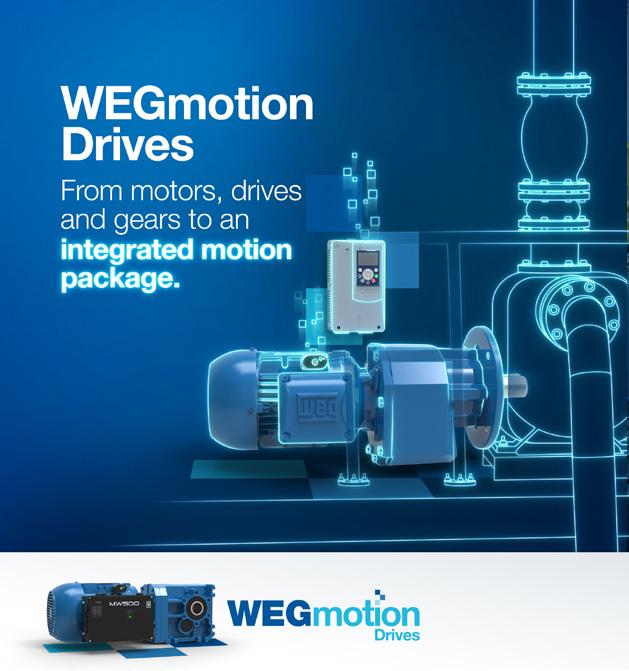
solution tailored to the unique demands of water treatment facilities.
Verticalization for comprehensive water process control: WEG’s commitment to providing comprehensive control extends to the water sector, ensuring verticalization in motion drives. This guarantees precise and efficient management of the water treatment processes.
Diversification with a comprehensive portfolio: With a diverse product portfolio, motion drives cater to the multifaceted needs of water treatment. This diversification ensures adaptability to various water treatment applications, underscoring our commitment to the water sector.
Fast configuration and high compatibility for water operations: Motion Drives facilitate swift configuration and high compatibility, streamlining the integration process for optimal performance with a single solution.
Flexibility for customization in water solutions: The embedded flexibility in motion drives allows for competitiveness in the water sector, accommodating the production of small batches of highly customized products. This adaptability is a critical strength in meeting the dynamic demands of water facilities.
Water treatment optimization: Modernizing sewage treatment stations aims to
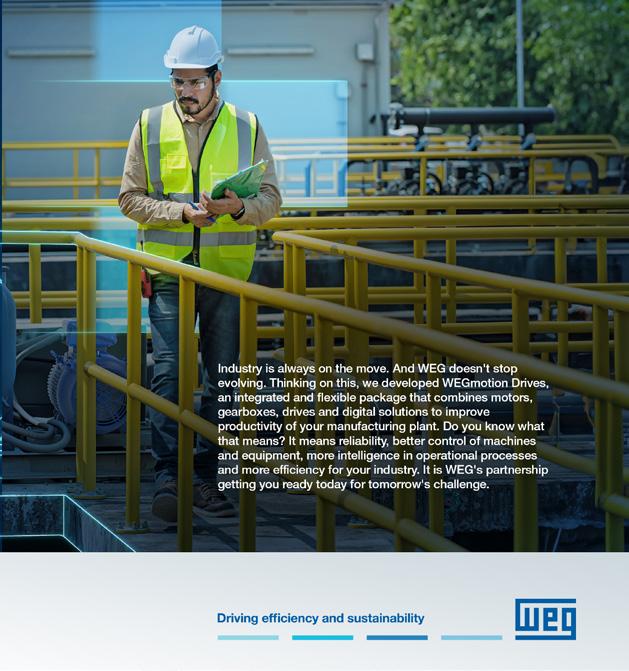
improve energy efficiency, optimize energy consumption per volume of pumped material, and increase the availability and reliability of the pumping system. To achieve these goals, modern engineering practices are adopted, such as using high-efficiency electric motors, applying frequency inverters to optimize pumping, and integrating system automation with monitoring and control networks. These measures significantly contribute to sustainability, environmental preservation, social responsibility, and the promotion of access to quality sanitation services for more people.
Innovation: With an impressive 59.3% of revenues generated from products launched in the last five years, Motion Drives encapsulates WEG’s commitment to innovation. This forward-looking approach ensures that our solutions remain at the forefront of technological advancement.
Robust technical support: WEG guarantees the efficiency of water treatment processes. Our commitment extends beyond delivering a product; we contribute to increased operational gains by ensuring that water treatment systems operate at their optimum level.
Motion Drives is an integrated package that perfectly aligns with WEG’s slogan, “Driving Efficiency and Sustainability.” It embodies our dedication to exceeding the expectations of industry facilities by providing solutions that contribute to efficiency, sustainability, and operational excellence.
Rabigh 3 Water Desalination Plant, Saudi Arabia
WEG’s Motion Drives play a crucial role in the Rabigh 3 desalination plant, ensuring an efficient supply of desalinated water on a large scale.
Counting on the technical expertise of dealing with large engineering companies,
WEG took part in this impressive project as a supplier of motors and frequency drives for the main processes of the water production chain, ranging from capture, pre-treatment, reverse osmosis process to post-treatment.
WEG´s products package included 69 electric motors and 50 medium voltage frequency drives supplied through a consortium of companies formed by Abengoa, SIDEM, and SEPCO III for the plant’s engineering, procurement, construction, and commissioning.
Rabigh 3 was built on the Red Sea’s western coast with a production capacity of 600,000 m3 of water per day and supplied water to approximately three million people. Unique to its kind, Rabigh 3 is considered the world’s most environmentally friendly desalination plant due to the lowest electricity consumption during day-to-day operations and has recorded the lowest noise rate.
Desalination, a critical process in water-scarce regions, demands precision and reliability. Motion Drives meet and exceed these demands, of -
Motion Drives bring innovation to pumping stations, optimizing energy consumption and extending the operational life of critical equipment
fering a solution beyond conventional approaches.
Canoas Lift Pumping Station, Colombia
At the Canoas pumping station in Colombia, Motion Drives technology optimizes the system’s operation, improving the efficiency and reliability of the water supply.
WEG was selected as the provider of a large package of electrical solutions for an important initiative to decontaminate the waters of the Bogotá River in Colombia. One of the significant challenges of this project was to guarantee the safe distribution of energy to the electrical systems and motors. For this, WEG supplied a complete 115 kV substation that includes two 30 MVA/115/13.2 kV transformers, adding more efficiency and reliability to the plant. In addition to low voltage load centres, 17 medium voltage switchgears were also supplied.
For this project, WEG supplied six three-phase induction motors and six medium voltage variable frequency drives. Each 4,300 kW motor, vertically mounted, was coupled to its respective pump and was responsible for pumping 6.4 cubic metres of wastewater per second to 51.6 metres height from the well, one of the most critical processes in the plant. This demonstrated the company’s ability to develop integrated solutions for the most diverse applications.
Pumping stations, such as the Canoas Lift Pumping Station in Colombia, represent crucial components of water distribution networks. Motion Drives bring innovation to these stations, optimizing energy consumption and extending the operational life of critical equipment.
Cucutá Metropolitan Aqueduct Expansion Project, Colombia
WEG’s Motion Drives contribute to the expansion of the Cucutá Metropolitan Aqueduct, a critical project in Colombia.
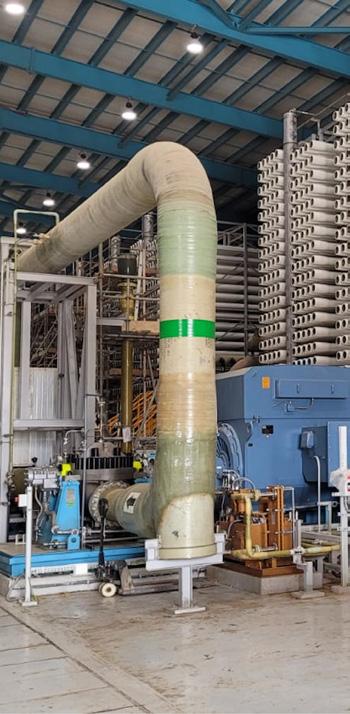
This underscores the adaptability and reliability of Motion Drives in diverse water infrastructure initiatives.
Confirming its experience in solutions with medium voltage equipment for the water sector, WEG supplied three 1,575 HP, 6.6 kV W60 medium voltage motors and three medium voltage panels with variable frequency drives from the MVW3000 line that will play an essential role in the actuation of the aqueduct pumping unit, contributing to increasing the water flow that supplies the region.
In addition to guaranteeing the supply of drinking water in the region, WEG solutions represented a return on investment and safety in operation for the customer since the W60 line was designed to meet the most rigorous efficiency and reliability criteria.
In the heart of South Africa, the Sebokeng wastewater treatment plant stands as a testament to the transformative im-
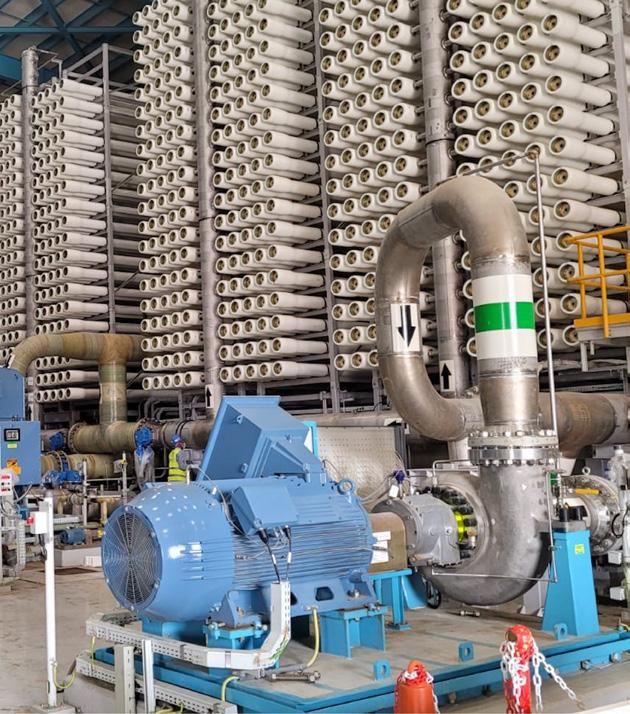
pact of Motion Drives. The supply of electric motors from WEG has revolutionized the plant’s operations, enhancing its capacity to treat large volumes of wastewater efficiently.
The scope of supply included several low voltage W22 electric motor solutions ranging between 3 kW and 280 kW, suitable for applications all over the entire wastewater treatment plant.
WEG motors were installed in all major processes, from screening, sand removal, primary sedimentation, reactors, fermentation of raw sludge, final clarification, and waste sludge thickening up to dewatering.
WEG’s Motion Drives solution is an advanced technological response and a significant step towards sustainability and efficiency in the water sector. These solutions demonstrate their ability to tackle contemporary water challenges by powering desalination and wastewater treatment projects, contributing to sustainable access to clean water worldwide.
In an era where water scarcity and clean energies are a growing concern, WEG emerges as a provider of cutting-edge solutions and a strategic partner, accompanying stakeholders from the initial design phase to implementation. By consistently delivering innovation, reliability, and adaptability, WEG ensures that every drop counts, reinforcing its role as a trusted partner dedicated to shaping a future where water resources and efficiency are managed with utmost foresight.
WEG’s
Drives solution is an advanced technological response and a significant step towards sustainability and efficiency
As the foundation of all life, water is not a commodity but a cornerstone of civilization, essential for agriculture, industry, and human well-being. Water security holds the key to peace and prosperity, ensuring equitable access to safe and sufficient water resources for all. On the occasion of World Water Day – in 2024 with the theme Leveraging Water for Peace – we highlight the role of water sector companies in tackling the global water crisis.
Water security stands at the nexus of economic growth, social stability, and environmental sustainability. The intricate interplay between these factors underscores the vital importance of reliable access to water resources. In regions where water scarcity looms as a pressing concern, the ramifications ripple through every facet of society,
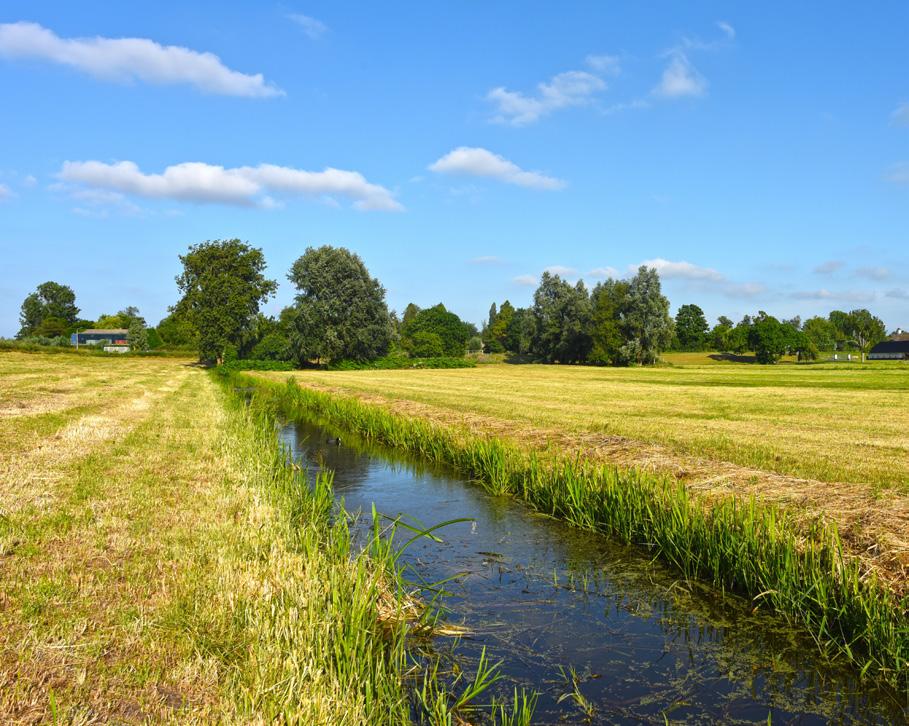
impacting livelihoods, industries, and ecosystems.
The symbiotic relationship between water security, economic prosperity, and social well-being is unmistakable. Thriving water-related industries, such as agriculture, manufacturing, and tourism, depend heavily on the availability of water. In environments blessed with ample water resources, these sectors flourish, driving economic growth and creating employment opportunities. Conversely, water scarcity stifles productivity, hampers industrial development, and undermines social stability.
Amidst this backdrop, water sector companies emerge as pivotal players in enhancing water security. By leveraging
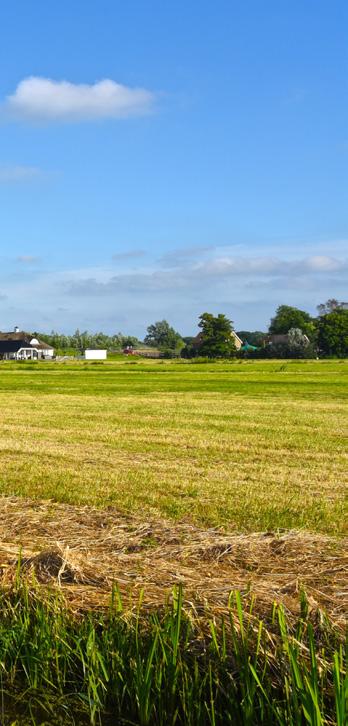
innovative solutions and collaborative approaches, these companies not only ensure access to clean water but also champion sustainable water management practices. Promoting water use efficiency, tapping unconventional water resources, protecting water bodies from pollution, and going beyond their remit to ensure their actions have a positive social impact, the water industry, each company from their own niche, plays a crucial role: we share some of their stories.
In the dynamic landscape of water security, water industry leaders exemplify a holistic approach that extends beyond traditional boundaries to include a commitment to societal well-being. In the
Thriving water-related industries, such as agriculture, manufacturing, and tourism, depend heavily on the availability of water
There is no future without a reliable water supply, and unconventional water sources play a key role in augmenting water availability
words of Cesar Ossorio, Head of Positive Planet and Climate Change at ACCIONA’s Water Business: “We work to provide access to energy, water, and sanitation to people with very low incomes, applying technological innovation and management criteria”, adding that “the results of this activity return positive impacts on the quality of life of users, such as poverty reduction, improved health, education, employment, etc., which favour the achievement of other SDGs.”
There is no future without a reliable water supply, and unconventional water sources play a key role in augmenting water availability that is drought-proof. Almar Water Solutions focuses on this approach: “Committed to sustainable development and economic prosperity, Almar Water Solutions deploys unconventional water solutions in the countries where it operates. The development of innovative technologies, such as desalina-
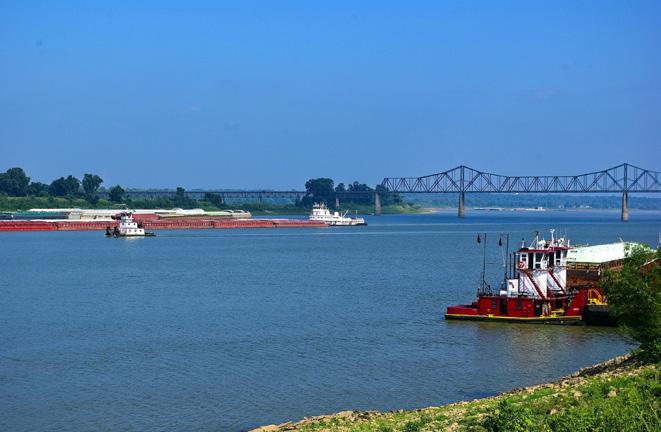
tion and water reuse, plays a crucial role in ensuring water security. These solutions not only preserve natural water resources but also drive sustainable economic development in local communities.”
Furthermore, as the water industry evolves to adapt to current challenges, companies leveraging digital technology are driving forward sustainable practices. Aware that water is a strategic resource that drives the economy and the well-being of communities worldwide, Idrica relies on the use of technology as a key ally for transparency and more respon-
The water sector is witnessing a paradigm shift propelled by enhanced technologies aimed at revolutionizing water treatment and production
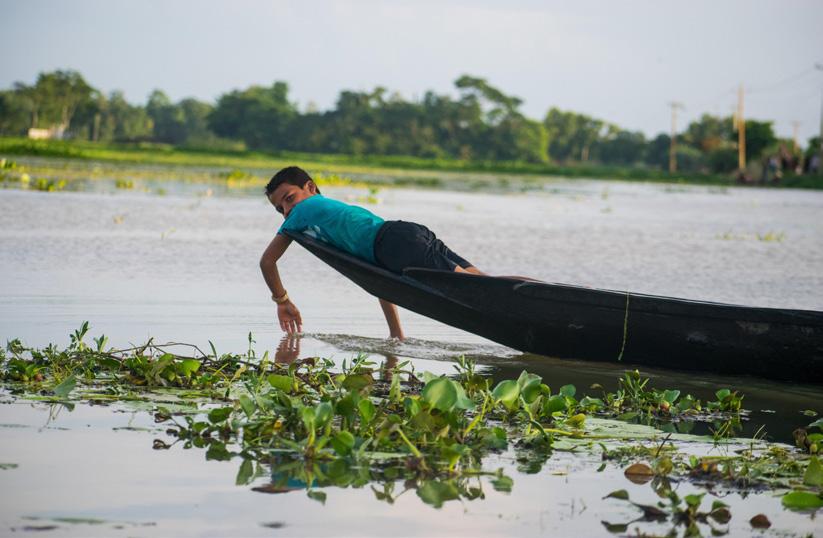
Zero liquid discharge technologies have emerged as a game-changer, offering a sustainable approach to wastewater management
sible water use, through the monitoring of water networks, infrastructure, and water losses; since its foundation, one of the company’s objectives has been “to try to have a positive impact on the world through water efficiency”.
Similarly, Hidroconta, a leading figure in digital technology for water applica-

tions, underscores the transformative potential of water-efficient solutions: “The development of water technologies to improve water resource use is key to the future. At Hidroconta, we are committed to developing solutions that optimize water use, minimize losses, and promote the conservation of water resources.”
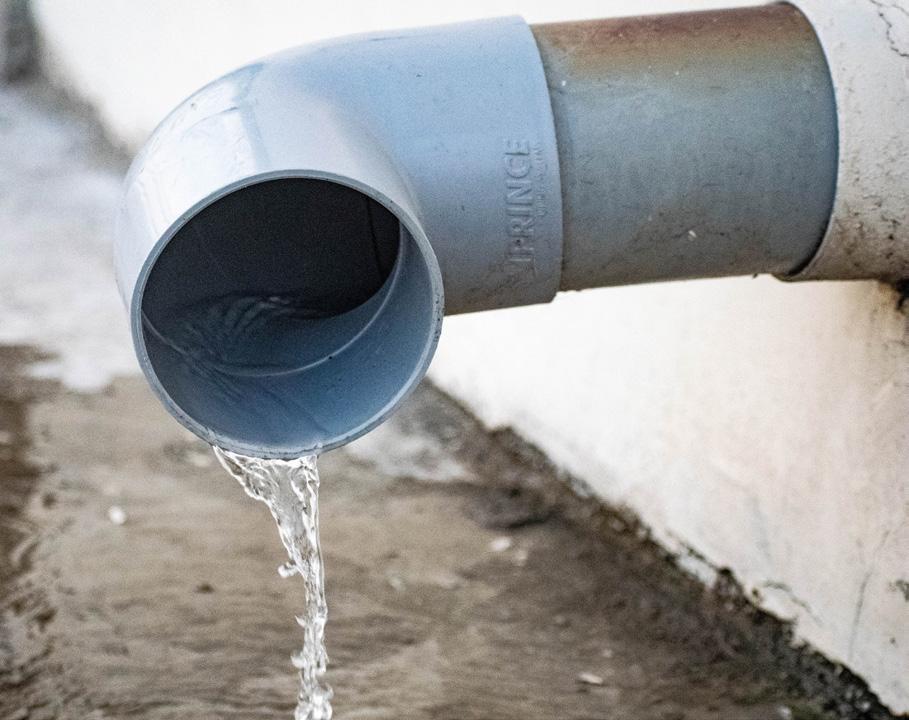
Increasing freshwater availability does not only address water scarcity but also drives economic growth and development, as SUEZ shows in their work with Wanhua Chemical Group, one of the world’s top 25 chemical companies, in Yantai, Penglai District, Shandong Province: “To help the company conserve limited water resources, SUEZ will construct a reverse osmosis seawater desalination plant capable of producing 100 million litres/day. This desalination plant will save more than 36 million m3 of fresh water per year.”
Innovation provides the key to unlocking a water secure future. Water professionals are at the forefront of developing and deploying cutting-edge solutions to address water scarcity, pollution, and inefficient management practices. In fact, the water sector is witnessing a paradigm shift propelled by enhanced technologies aimed at revolutionizing water treatment and production. Due to climate change, developed countries are now facing water stress,
whereas in developing countries water stress is combined with rapid urbanization. Improved filtration solutions such as Filtralite, the innovative filter
Smart technologies and management platforms are empowering water professionals with real-time insights and predictive analytics
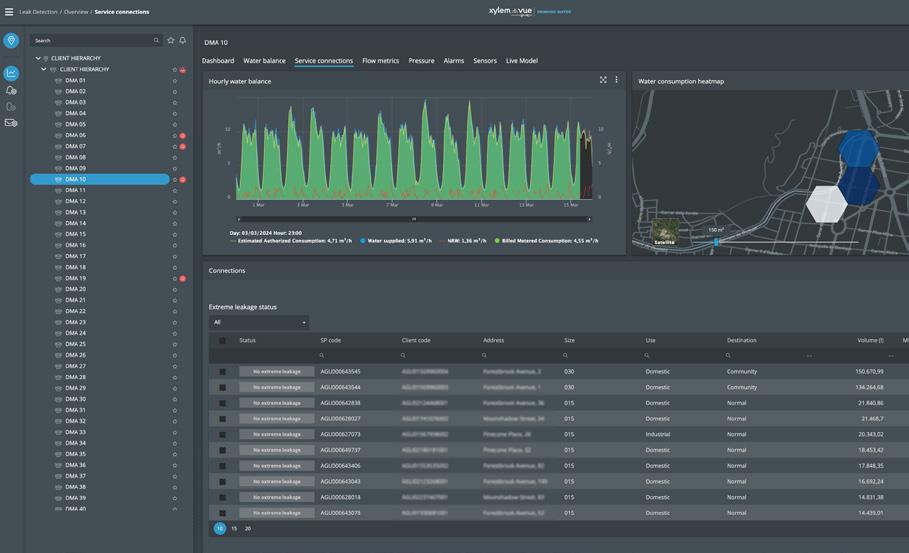
media from Saint-Gobain Group, help improve the performance of water treatment plants. “In existing plants, Filtralite makes it possible to produce more water to supply more people. In new plants, you can increase the production capacity or decrease the number of filters”, notes the company. A sustainable response to the pressing imperatives of water conservation.
ACCIONA, for instance, is harnessing innovation to transform challenges
into opportunities from its Technological Center: “Collaboration takes place with all areas of the company to develop cutting-edge technologies in desalination, purification, reuse, and water distribution, aiming not only to minimize impacts but to turn them into positive impacts.”
Another major player, Almar Water Solutions, relies on state-of-the-art reverse osmosis and filtration technologies to enhance efficiency and reduce energy consumption, as well as technologies and equipment that generate brine more efficiently and sustainably. Environmental sustainability is one of their priorities, and the company is committed to “driving technological advancements that redefine industry standards and ensure water security in the regions where it operates.”
Zero liquid discharge technologies have emerged as a game-changer, offering a sustainable approach to wastewater management by minimizing discharge and maximizing resource recovery. This is a growing market, where HRS heat exchangers enable wastewater streams to be reused: “HRS are seeing more and more demand for evaporators and zero liquid discharge (ZLD) technology around the world”, explains Matt Hale, the company’s International Sales & Marketing Director.
We cannot talk about innovation without delving into the digital realm, where smart technologies and management platforms are empowering water professionals with real-time insights and predictive analytics to optimize operations and enhance efficiency. This is possible thanks to companies dedicated
to innovation. A case in point is Hidroconta, with a specific R&D department, which they believe is “fundamental to our business strategy, responsible for incorporating new digital technologies into our key products and developing new products.”
Another key player in digital water technology, Idrica aims to improve the management of clients’ digital assets with a holistic and comprehensive vision of integrated water cycle management, through the solution Xylem Vue powered by GoAigua. “Thanks to the partnership with Xylem, this technology brings together the technical depth (from assets to analysis) and the operational knowledge of Xylem and Idrica to create an even stronger offering that is enabling work on equitable and sustainable water access, improving integrated water cycle management in countries such as Mexico, Qatar, Romania, and Spain.” Likewise, SUEZ’s AQUADVANCED Water Networks platform harnesses artificial intelligence to detect anomalies in real-time, enabling prompt intervention to mitigate leaks and conserve water resources. “Acting as a control tower in drinking water distribution networks, this solution cross-references, analyses and processes the data sent by sensors installed in the network to guide our operators on the ground to perform repairs as soon as possible”, they explain.
Collaboration between water stakeholders is paramount in driving water security, and industry players are involved in diverse initiatives across the globe. These collaborative endeavours not only enhance water resource management but also pave the way for resilient solutions to pressing water challenges.
In Spain, ACCIONA’s DACUA project, a part of the country’s Recovery, Transformation, and Resilience Plan
The concerted efforts of water sector companies underscore their commitment to ensuring a sustainable water future for generations to come
(PERTE), exemplifies the power of collaboration in advancing digitalization for water cycle management. “Through digitalisation and innovation, it aims to consolidate integrated management and improve efficiency in the use of water resources, for a more resilient water supply that guarantees water security.”
Similarly, in Mexico, ACCIONA has worked to secure the water supply in Veracruz through new intakes in the Jamapa and Cotaxla Rivers, developing an action plan in collaboration with public authorities.
Almar Water Solutions’ collaboration initiatives with various institutions underscore the company’s commitment to innovative solutions for water security. Projects like the Shuqaiq 3 desalination plant in Saudi Arabia, benefiting nearly four million people, exemplify the transformative potential of collaborative ventures to preserve and share valuable water resources.
Moreover, HRS highlights the importance of working with municipal water companies to help upgrade water treatment facilities or develop new ones, for instance, the Prince of Wales Bay Sewage Treatment Plant, managed by TasWater in Australia, to meet evolving needs.
Finally, SUEZ’s longstanding work with the Macao government illustrates the transformative impact of excellence in water services for water management. Through a water supply concession con-
tract since 1985, SUEZ has contributed to Macao’s water network’s resilience, ensuring a reliable water supply for the population while significantly reducing water loss rates.
By harnessing technological advancements and working side by side with various stakeholders, water companies are at the forefront of developing sustainable solutions to address water challenges worldwide. Innovation drives the development of new technologies and approaches, while collaboration enables the sharing of expertise and resources to implement effective solutions. As we navigate the complexities of water scarcity, pollution, and climate change, the concerted efforts of water sector companies underscore their commitment to ensuring a sustainable and secure water future for generations to come. Through continued innovation and collaboration, these companies will continue to lead the way towards achieving global water security.
Innovation drives the development of new technologies and approaches, while collaboration enables the sharing of expertise and resources
WESTLAKE HIGH SCHOOL STUDENTS (AUSTIN, USA) DEVELOPING A LOW-COST DEVICE FOR MICROPLASTIC DETECTION IN WATER.
Even with 87,000 tons of plastic already floating in the growing Great Pacific Garbage Patch, we are still trending towards doubling plastic production every two decades. According to Susanne Brander, an environmental toxicologist and an associate professor at Oregon State University, plastic doesn’t decay naturally, but instead breaks down into smaller and smaller pieces. These minuscule particles have infiltrated our surroundings, from the depths of oceans to the crevices of terrestrial landscapes. The sources are diverse, from tire dust to fragments of larger plastic items to microbeads in personal care products. The ubiquity of these particles raises concerns about their toxicological effects and long-term environmental consequences. Wastewater, wind, rain and floods are some of the main carriers of plastic, especially single-use plastics from the land into the oceans, rivers and lakes.
So, like it or not, we are drinking microplastics almost daily. Although most of the scientific community agrees that consuming these particles can expose us to potential health risks like brain damage, endocrine disruption, and insulin resistance as well as wreaking havoc on aquatic ecosystems, very few governments across the nation have a policy to regulate microplastic contamination in the water bodies, and regularly test and monitor the levels of microplastics in our water sources. Based on the water quality reports published, they mainly focus on heavy metals, nitrates, fluorides and such, but no testing seems to be done on a regular basis for microplastics.
One of the main reasons for water departments to not regularly test for microplastic contaminants is the cost of testing equipment needed for detecting microplastics in water. Techniques like infrared spectroscopy (IR), Raman spectroscopy, and fluorescence have been employed to identify contaminants such as microplastics. The price of this equipment runs in the order of $10,000 to $35,000. It is evident even in home testing kits, while the average price of traditional water testing kits is around $30 to $60, microplastic home testing kits cost $500 to $600. All these techniques suffer from cost and scalability issues.
The other main reason for not publishing levels of microplastics in water quality reports is the cost and quality of water filtration for microplastics. Reverse Osmosis (RO) is considered efficient at reducing high levels of microplastics in water. But putting RO systems to filter out microplastics at water sources will at the very least double up our costs of water filtration for the governments. Additionally, RO systems have other issues like over filtration of essential nutrients from water, which can lead to more health concerns.
There are very few solutions for detecting microplastics in water with enough precision to publish reports, and most filtration methods to supplement these detection methods cause more problems of their own. Governments may be reluctant to test and publish microplastic pollution levels in water sources on a regular basis to avoid public outcry for not taking action unless they have a viable solution to test and filter out microplastics.
"Addressing the microplastic detection crisis necessitates a multidisciplinary approach, and IoT, AI and ML are at the forefront of this battle"
Addressing the microplastic detection and filtration crisis necessitates a multidisciplinary approach, and Internet of Things Cloud Computing (IoT), Artificial Intelligence (AI) and machine learning (ML) are at the forefront of this battle. The first step in tackling this problem is identifying the presence of microplastics in our water and ecosystems with a low-cost solution. AI algorithms can be trained to detect and classify microplastics in diverse environments using state–of–the–art sensing technologies like electrochemical impedance spectroscopy (EIS) to identify the contaminant. This approach also can be used in identifying the primary sources of pollution by analysing the dumping patterns and levels of microplastic pollution.
Electrochemical impedance spectroscopy
EIS is an emerging method of detecting contaminants in water, or in other media. EIS differs greatly from other lightbased methods like FTIR or Raman spectroscopy in that it does not use light as a detection method. EIS, as the name may suggest, works by using electricity as the observation tool. EIS passes a current through the solution in question and measures the output. The output in question is the impedance of the solution, which is a combination of the resistance (how the solution resists the flow of charge), the capacitance (how the solution stores charge), and the inductance (how the solution resists a change in the flow of current through it).
Measuring the impedance can determine what contaminants are in the solution, since the presence of contaminants in the solution affects the way the solution responds to a current, and therefore affects the impedance. The final component of EIS is spectroscopy, a dimension that is added through the conversion of the singular impedance property of a circuit into a spectrum by using an alternating current. This alternating current is produced at a range of frequencies, and measuring the impedance of the solution at each of these frequencies will in return create a range of measurements that can be treated as a spectrum. Spectral analysis methods can then be applied to these impedance spectrums, providing much more data than a single measurement that is used to identify contaminants in water, even in trace amounts. EIS is cheap in comparison to FTIR or Raman spectroscopy and more robust due to its small size. It is, therefore, possible to mass produce EIS sensor designs and network them through the IoT to gather large amounts of data about water bodies.
An IoT-based EIS sensing system can be a promising lowcost solution consisting of several types of devices, including edge sensors for home settings, edge computing devices for major water sources like groundwater, lakes and rivers, compute servers, and mobile devices for running machine learning from EIS sensing data to identify contaminants. The system can facilitate training and inferencing of ML models for water quality monitoring on a regular basis. Edge sensors are relatively inexpensive and are intended to operate on lower power suitable to be installed in home environments, and can transfer the collected data to the cloud for alert notification and do not have edge computing capabilities. On the other hand, several edge computing devices can be installed in main water sources


at major dumping points and can not only sample water but also perform inferencing locally on water contamination samples and raise alerts. This fully scalable system allows vast data collection from distributed EIS sensors to improve ML contaminant identification models. The IoT-enabled architecture allows mobile access to real-time water quality data and alerts. The system’s scalability provides accessible drinking, industrial, and agricultural water quality monitoring globally. Its distrib-
"The first step in tackling this problem is identifying the presence of microplastics in our water and ecosystems with a low-cost solution"
uted nature enhances community capabilities for contaminant monitoring in water sources.
Whether we choose to use AI and IoT solutions or not, as the greatest advocates of our personal health, we should start a dialogue with our local governments to take the first step in detecting microplastics. Not having a perfect solution for filtration shouldn’t be a reason for not publishing the levels of microplastic pollution in water sources. Once we start gathering consistent data and releasing it to the public, it will raise awareness in the community, and possibly help us become more responsible and reduce the use of plastics and find ways to prevent plastic from reaching water in the first place. But it’s high time we collectively take the first step to include microplastic testing as part of our water quality reports.


OPINION
Water and energy are interconnected resources, with water necessary for energy production and energy required for water transportation, treatment, and desalination. However, the finite nature of both resources and the growing global challenges, such as climate change and population growth, place them under increasing stress. Globally, strategic objectives such as the UN sustainability goals are being established to counteract the stress by optimizing the water use efficiency in energy production and improving the energy efficiency in water treatment. Efficiency gains can be achieved by various technical means, e.g. by reusing water harvested in cooling towers to reduce water consumption in thermoelectric power generation, increasing zero liquid discharge efficiency, decreasing losses in desalination processes, and improving heat exchanger technology using membrane engineering and surface engineering to overcome severe fouling problems. Fouling on membranes and heat exchanger surfaces can substantially degrade the efficiency of separation and energy conversion processes within water and energy systems. Crystallization fouling or scaling is an important subset of fouling that results from the precipitation of inverse soluble salts such as calcium carbonate or calcium sulfate. Industrial heat exchangers and desalination membranes commonly use natural water containing those scaling salts. The formed deposits substantially inhibit heat transfer and flow performance. Scale can lead to an enormous energy loss which accumulates to at least 2% of the total world energy production per year or 0.25% of the gross domestic product (GDP) of industrialized nations.
Current fouling mitigation approaches range from optimizing the initial design of Water-Energy Systems by geometry optimization, online mitigation using feed filtration or chemical inhibitors, or offline cleaning by fluid blasting or mechanical removal. However, despite the efforts made by these mitigation strategies to reduce fouling, they continue to have a significant negative impact. A complementary approach involves modification and engineering of the surfaces in the systems. Surface modifications through coatings can act as a barrier to prevent scale formation and reduce the adhesion of the scale, resulting in self-cleaning and scalephobic surfaces. These surface mod-
ifications are attractive pathways to achieve sustainability and cost-efficiency, as they address the problem at its source.
In recent years, there has been a shift in focus towards the development of improved coatings and modified surfaces at both fundamental research and industrial levels. To develop new and enhance the existing approaches, we need a deeper understanding of how scale forms, how the scale interacts with the surfaces and how it can be passively removed using prevailing flow conditions. In our research at ETH Zurich in the Laboratory for Multiphase Thermofluidics and Surface Nanoengineering our primary focus lies in developing techniques to thoroughly study the formation, adhesion, and removal of scale on a fundamental level. Leveraging this understanding, we investigate novel materials potentially leading to scalephobic sur-
"Surface modifications are attractive pathways to achieve sustainability and cost-efficiency, as they address fouling problems at the source"
face designs. Our research has revealed promising outcomes, particularly with a microtextured polymer-hydrogel coating. In laboratory conditions, this coating has demonstrated the capability to remove up to 98% of scale deposits under realistic flow conditions as they would be present in water-energy systems. However, it is important to acknowledge that such coatings also come with challenges. The addition of polymeric layers can decrease performance by introducing higher thermal resistance to the system and needs to be long-term durable in the applied environment. Thus, achieving a balance is crucial between the benefits of fouling mitigation using surface modifications and the potential drawbacks. Further research and development can help to design surfaces which can reduce the challenges of the water-energy nexus.

Our recent article in Nature Energy is our first attempt at the development of a scalable photoelectrochemical (PEC) system to produce green hydrogen (H2). Based on our previous critical review article, there are challenges associated with practical solar H2 production. We also found that a minimum of 10% efficiency is required to develop a viable practical PEC system, for which selecting the efficient material is the first criterion. So far metal oxides have been studied for photocatalysis but are far away from such practical efficiency limits. On the other hand, photovoltaic (PV grade) materials (silicon, perovskites, chalcogenides, III-V class) are well established in solar cell industries. Such efficient, scalable PV grade materials could be an option but very few fulfil the requirements for efficient PEC applications, while other materials are efficient but cannot fulfil major criteria including efficiency, low cost, and integration of catalysts.
MHP materials have excellent optoelectronic properties and a tunable band-gap which are desired in the PEC field; e.g. metal-halide perovskites (MHP) can provide the necessary photocurrent and photovoltage to split water and produce oxygen and H2 in a single PEC cell. Such MHP materials can be fabricated at a large area including mini-modules and modules scales. We know that there was only one challenge associated with these materials which was the degradation of MHP in humid conditions because PEC reactions were to be conducted in liquid electrolytes. So, we had to focus on stabilizing such materials using metal-encapsulation for PEC reactions. With such concepts in mind, we selected the stabilized MHP material to apply in the PEC field.
In the Nature Energy article, we selected the efficient material (e.g. FAPbI3 as MHP) and presented the material & thinfilm analyses, with its application as efficient photoelectrodes in PEC water splitting with at least 10% efficiency, which were the primary objectives. After successful experimental results, we achieved the 9.89% efficiency at small-area devices as preliminary results. Such results motivated us to check the efficacy of large-area PEC devices.
Our all-perovskite PEC system is composed of a FAPbI 3 photoanode, which has MHP thin films protected using
"The advantage of our system is integrating multi components in a single PEC device, minimizing the system’s complexity and reducing costs" OPINION
Nickel (25-30 micron thick) metal foil as encapsulation and NiFeOOH as a catalyst layer on it. We optimized this photoanode using different metal foils and studied the in-depth catalyst-electrolyte interactions. Small area FAPbI 3 photoanodes (0.25 cm 2) were tested using a photoanode connected to a solar cell (PEC-PV) in the single reactor system. As per our preliminary results, we found 9.89% (close to 10%) efficiency using small-area devices. This is because two semiconductor devices are necessary to generate a maximum 2 voltage required for water splitting in O 2 and H 2 gas. However, the PV component must be kept outside the reactor in the PEC-PV system. To minimize the system complexity, we decided to integrate both components in a single PEC device which avoided the extra use of PV components. This
is a unique advantage of our system, and it can reduce the cost of the system.
As stated above, the unique advantage of our system is integrating multi components in a single PEC device avoiding extra use of PV components which minimize the system’s complexity and reduce the cost of the system. Another main finding is maintaining a similar performance at scalable PEC systems. Such short-term scalable demonstration will lead toward practical application of PEC technology for green H2 production in outdoor conditions. We plan to improve the PEC system's efficiency and stability by integrating photoelectrodes (e.g., photoanode-photocathode) and choosing more efficient, durable catalysts.
 ABDUL AALA KHURRAM
TECHNICAL DIRECTOR, WATER CARE SERVICES, PAKISTAN
ABDUL AALA KHURRAM
TECHNICAL DIRECTOR, WATER CARE SERVICES, PAKISTAN
Wastewater treatment technologies are critical in safeguarding both human health and the environment, as they eliminate pollutants from wastewater prior to its re-release into the environment. They are constantly evolving to meet challenges such as the nature of contaminants, their concentrations and the demands of population growth, urbanization, and environmental protection. Below you will find a review of common wastewater treatment technologies, sustainability issues and prospects.
The history of wastewater treatment looks at how the industry has changed over time from traditional methods to cutting-edge approaches that push the limits of effectiveness, sustainability, and environmental responsibility. Physical techniques have long been utilized to let solid particles separate from wastewater due to gravity. Nowadays this is called the primary or first stage of treatment, separating liquids and solids in wastewater. Screens and grit removal have been used for a very long time: grit and coarser particles are taken out of wastewater using grit chambers and screens. These procedures are gradual, straightforward and efficient in preventing harm to downstream equipment. They may include automation and controls, for enhanced efficiency and monitoring.
Biological treatments, in multiple forms, have been used for more than a century. In activated sludge systems, organic contaminants are broken down in aerated tanks by combining wastewater with microorganisms. Although it works well, aeration needs a large amount of energy, land and careful management to be more effective and avoid sludge accumulation. Trickling filters are used to treat wastewater with less energy. The microbial biofilm helps to treat wastewater: they are simple and less intensive concerning O&M.
Chemical treatment involves coagulation and flocculation with chemicals. Chemicals such as chlorine/bleach and KMnO4 have been used to sterilize water since ancient times, when drink containers were made of copper and silver to ensure drinking water disinfection. Nevertheless, they do have pros and cons, so selection criteria are key. Sunlight disinfection of tainted water dates to the eighteenth century: UV and infrared
"Energy generation at treatment plants, rather than adding energy to treat wastewater, can turn treatment processes into energy positive" OPINION
rays can destroy bacteria found in water. Selecting the intensity and dose monitoring provide quality assurance.
A step ahead into the future is resource recovery. Energy generation at treatment plants, rather than adding energy to treat wastewater, can turn treatment processes into energy positive, while nutrient recovery enables the recovery of phosphorus and other valuable minerals from wastewater, for their reuse. Moreover, although not a novel idea, nature-based solutions, such as the use of artificial wetlands to treat wastewater, have drawn interest as a practical and affordable solution.
An emerging challenge is pollution by microplastics and PFAS, which need a green solution, rather than chemical-based treatment. Advanced treatment technologies, including membrane processes, are becoming more economical and energy-ef-
ficient because of new developments in membrane technology, including better materials and modular designs. Common technologies are ultrafiltration, nanofiltration, reverse osmosis and membrane bioreactors (MBR) for wastewater treatment and reuse. Technologies like advanced oxidation processes, electrocoagulation, bioelectrochemical systems, microbial fuel cell technology and colonized phototrophic biomass, have been emerging for specific wastewater treatment, with limited usage.
Finally, IoT, Artificial intelligence (AI) algorithms and big data are being used to optimize treatment operations, predict maintenance, and gain insights into treatment plant performance. Their adoption is now an unstoppable trend, though tool selection and application need to be specific and tailored to particular applications.
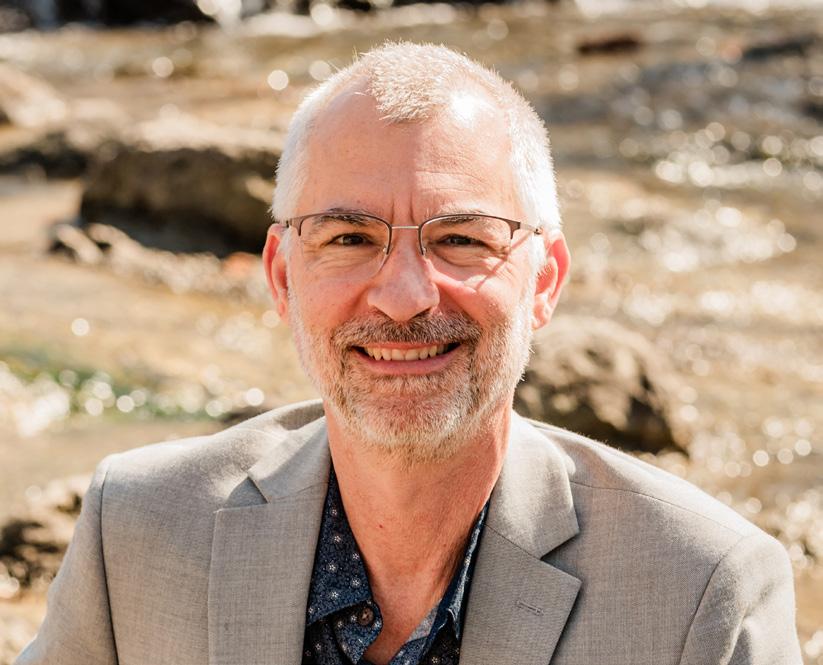
Dr Darren Lytle is this year’s recipient of the A.P. Black Research Award, given every year by the American Water Works Association (AWWA) for outstanding contributions to water science and supply practices.
Dr Lytle has dedicated his career to studying the quality of drinking water. The award recognises his contribution toward human health through supporting drinking water regulations and collaborating with states, communities, and homeowners to enhance the quality of drinking water.
With a career at the U.S. EPA that spans more than three decades, this environmental engineer has identified and implemented research in a wealth of water quality topics, including microbial contaminants, inorganic contaminants – arsenic, ammonia, nitrate,
lead and copper – as well as organic contaminants, such as volatile organic compounds and disinfection byproducts. His expertise extends as well to drinking water distribution system issues and premise plumbing, such as corrosion of lead and copper pipes and its impact on water quality.
An active member of AWWA, Dr Lytle has published over 100 manuscripts and book chapters, and has made over 150 presentations. He has also engaged extensively with different organizations, academics and communities. In particular, he worked to address water quality challenges in well-known cases such as the lead crisis in Flint, the harmful algal blooms in Toledo, and the cryptosporidium outbreak in Milwaukee.

Water hammer, also known as hydraulic shock or fluid hammer, is notorious for causing potentially catastrophic disruptions to water distribution networks, industrial piping and other fluid transport systems. In the water sector, the consequences of water hammer can lead to ruptured pipes, leaks, and costly downtime, highlighting the critical need for expertise in addressing this phenomenon.
Recognizing its significance, Autodesk Water delved into this issue during its first webinar of a webinar series, organized in collaboration with Smart Water Magazine. The water giant launched a webinar series aimed at uniting experts in the water industry by spotlighting cutting-edge methods and proven strategies for elevating water management practices, including combatting flooding, resolving network leakage and harnessing the potential of digital twins. The series provides an unparalleled insight into the evolving trends, challenges, and opportunities shaping the future of our interaction with the planet's most indispensable resource.
The first webinar: “Water hammer in water systems: analyse and mitigate using Autodesk’s Water solutions”, was entirely dedicated to the phenomenon of water hammer in water systems, understanding their causes and exploring the various strategies for their mitigation using Autodesk Water’s latest technology. The online seminar introduced Autodesk's solutions for modelling water hammer events and for hydraulic modelling and water hammer analysis within a comprehensive water management framework.
Cristina Novo, Technical Editor at Smart Water Magazine, introduced the online seminar and highlighted the relevance of an initiative such as the Autodesk Water webinar series, which serves as a platform for collaboration and exploration with a focus on meeting the needs of the water utility sector. The global water industry is projected to require an investment of approximately
Youssef Al Fahham Technical Marketing Manager, Water at Autodesk
"Our solutions are used globally by thousands of customers in more than 60 countries and are mostly used by large municipalities, utilities and councils globally"
1.9 trillion dollars by 2030. This figure underscores not just the scale of the challenge but also its immense opportunity. In the face of these challenges, digital technology emerges as a transformative force, offering new tools for more efficient and effective water management. She pointed out that Autodesk Water stands at the forefront of this transformation, leveraging its expertise in design and construction together with advanced hydrological modelling technologies.
Introducing Autodesk Water Autodesk Water, boasting a rich legacy in pioneering cutting-edge software for the industry, is dedicated to crafting solutions that promote enhanced efficiency and sustainability in water utilization. The firm equips the water and wastewater industry with the solutions needed to make the best decisions possible at every stage of a water asset’s lifecycle. Youssef Al Fahham, Technical Marketing Manager, began his presentation by introducing Autodesk Water, a company which in 2021 bought Oregon-based Innovyze, a global leader in water infrastructure software. Thanks to this purchase, the Autodesk portfolio in water grew exponentially and is now known in the mar-
ket as Autodesk Water. He underscored that the firm’s water modelling solutions are used by thousands of customers in more than 60 countries, especially by large municipalities, utilities and councils globally. Taking a closer look at Autodesk’s water solutions: Al Fahham said that there were two main pillars. The first consists of desktop solutions and the second is cloud solutions.
Next, Youssef Al Fahham explained in detail what the water hammer phenomenon is. This occurrence is also known as pressure surge, hydraulic transient or hydraulic shock. It emerges when a fluid, typically liquid though occasionally gas, experiences an abrupt halt or redirection in its motion, which is known as a transient state. This occurrence is frequent when a valve Water hammer, also known as hydraulic shock, is notorious for causing potentially catastrophic disruptions to water distribution networks
 Rebecca Willey
Rebecca Willey
Technical Solutions Engineer at Autodesk
"Hydraulic modelling helps tackle these challenges by enabling a greater understanding of how all sources to our systems will impact them; how our systems will respond to varying conditions; and how different elements will interact with one another"
abruptly shuts within a pipeline network, instigating the propagation of a pressure wave through the conduit. “This transient state happens due to any change in velocity in your piping system”, explained Youssef. Simply said: water hammer is a state between the initial and the final state. This state can cause a positive high-pressure wave or a negative low-pressure wave. Youssef went on to explain that water hammer analysis is extremely important, as this phenomenon, as we mentioned earlier, can cause significant damage, such as pipeline rupture, deforming the pipes permanently or environmental contamination. There are two common ways to analyse the pipes: the famous hand calculation Joukowsky equation and the second way is with hydraulic modelling. “The benefit is you can overcome simplification that exists with the Joukowsky equation.”
Autodesk’s hydraulic modelling solutions
Al Fahham then gave way to his colleague Rebecca Willey, Technical Solutions Engineer, who started by sharing with the public what hydraulic modelling is. According to this expert, it is a representation of a system and is a tool that helps tackle these challenges by enabling a greater understanding of how all sources to our systems will impact them; how our systems will respond to varying conditions; and how different elements will interact with one another. This gave way to introduce Autodesk Water’s two hydraulic modelling tools, which she described in detail, highlighting that most importantly, the two solutions included water hammer.
Autodesk Water equips the water industry with the solutions needed to make the best decisions at every stage of a water asset’s lifecycle
J Autodesk InfoWater Pro: This hydraulic modelling application built in ArcGIS Pro allows users to simulate countless scenarios and perform a wide range of analyses, including fire flow, valve criticality, pipe break, water quality, system curves, and energy usage.
J Autodesk InforWorks WS Pro: This solution is a standalone solution with a collaborative multi-user environment and an advanced hydraulic analysis engine. It is used by water utility engineers who
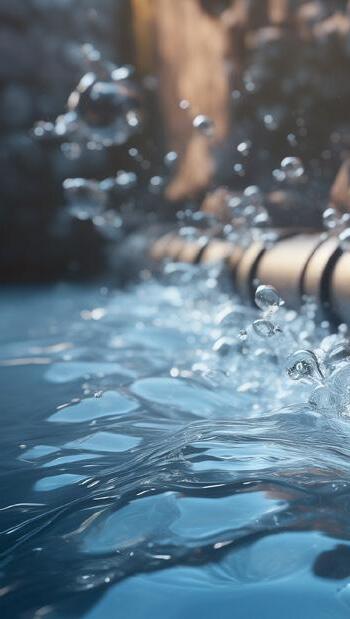
manage water distribution systems aiming to provide a safe and reliable drinking water supply, and water resources engineering consultants who perform distribution system calibration and master plan modelling projects.
Willey stressed that as we enter a world of drought and more increased water loss, we need as much water as possible, making hydraulic modelling solutions vital. These ensure the effective and efficient operation of water distribution, stormwater, and wastewater networks, predicting the behaviour of water in natural and engineered systems.
Autodesk not only offers various cutting-edge hydraulic modelling solutions, but it also allows users free on-de-
mand training for all the company’s products, including a water hammer specific course.
Willey concluded by highlighting that Autodesk’s solutions have water hammer analysis and mitigating tools included and that users can start straight away, without the need to skeletonize and change UI. Moreover, the two applications offer easy windows for surge replication and have built-in devices to help speed up the design process.
Finally, the online seminar concluded with a block of questions from the audience. Most of them focused on technical issues regarding Autodesk’s two solutions, which were answered by the two speakers in detail.
The first webinar marked the beginning of an exciting journey into smart water management. As we witnessed during the online event, the challenges facing our water resources are significant, but so too are the opportunities presented by innovative technologies and forward-thinking strategies.
As we enter a world of drought and more increased water loss, we need as much water as possible, making hydraulic modelling solutions vital
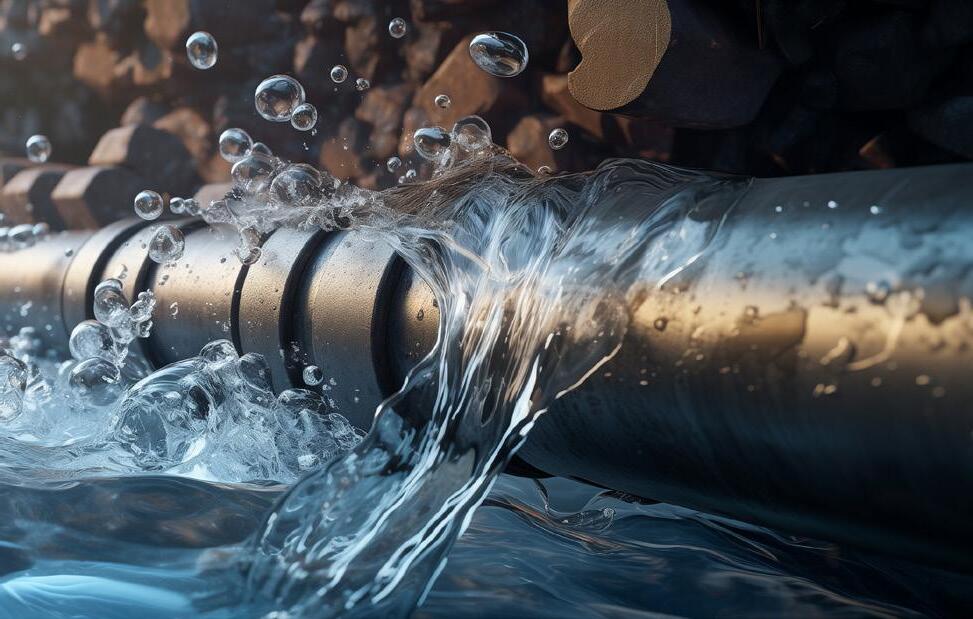
“NUAR has demonstrated that technology is not a barrier but an opportunity”
The National Underground Asset Register (NUAR), a digital map of utility assets under the ground, promises to make planning and executing excavations much easier for underground asset owners and save the UK economy billions, as just the economic costs of utility strikes alone are estimated at £2.4 bn a year.
Z Cristina Novo PérezEvery seven seconds a hole is dug to access pipes and cables for repairs, upgrades and installations in the UK, estimates the Geospatial Commission - part of the UK government’s Department for Science, Innovation and Technology. The National Underground Asset Register (NUAR) was created to streamline the data-sharing process between asset owners and excavators, reducing the number of utility asset strikes and promoting efficient management and maintenance of underground assets. The concept was initiated during Northumbrian Water Group’s Innovation Festival in 2018, and has since been developed by a number of partners and turned into a reality by the Geospatial Commission. In this interview with Neil Lloyd, Service Adoption Lead, National Underground Asset Register at the UK Geospatial Commission, we learn more about the current status of this initiative that can
"We are encouraging early adoption as this allows users to provide invaluable feedback to the NUAR team on the service and its features"
transform the way we install, maintain, operate and repair buried infrastructure.
Please tell us briefly about your career path and your current involvement with the National Underground Asset Register (NUAR).
I joined the NUAR programme in February 2022 and in that time, I’ve been fortunate enough to work on various aspects of the programme. This has included engaging with stakeholders at the very start of their journey to explain the value and benefits of the programme, through to working on the policy and legislative requirements that will underpin it.
Currently, I’m leading on service adoption which involves ensuring organisations have the information they need to start using the service at the earliest opportunity. The minimum viable product (MVP or first version of the service) is currently available to asset owners who are fully signed up and their supply chains. We are encouraging early adoption as this allows users to provide invaluable feedback to the NUAR team on the service and its features, which helps us make it even better. Additionally, it allows users to provide feedback to their own organisations on the value and benefits of the service, and make plans to improve existing business processes through
the full adoption of NUAR once it is fully operational.
Before joining the NUAR team, I worked for a large media organisation working on heritage BBC brands. I’m also a qualified barrister which has played an important part in facilitating the rollout of our asset owner legislative framework and understanding the process of converting our policy into actual legislation.
Can you give us an update on the rollout of the NUAR?
In 2019-20, two pilot projects were carried out in North East England and London to test the feasibility of creating a national map. Following the pilots, a phase of work began to address challenges and bring together various stakeholders. A data sharing framework was created to support voluntary data sharing and a Data Model Governance Group was established to create the NUAR data model and test it with data from all pilot participants.
After addressing the challenges identified through the pilots, a competitive invitation to tender was launched in late spring 2021. AtkinsRėalis was appointed to lead the delivery of the new service and work commenced in September 2021.
In the first year of the programme, the team engaged extensively with asset owners and other stakeholders, finalised the legal framework underpinning the NUAR programme, began development of the platform, participated in the development of the Open Geospatial Consortium Model for Underground Data Definition and Integration (MUDDI), ran a public consultation on the potential of legislative reform and the pro-

posed future operating model of NUAR to maximise the benefits to the UK economy, and identified key milestones towards achieving the intended benefits.
The NUAR programme has recently celebrated two years since work commenced on the platform and significant progress has been made. The NUAR minimum viable product (MVP) has been launched and enhanced and is now available to participating asset owners and their supply chains across England and Wales and is on track to go live in Northern Ireland this spring. The MVP includes all core functionality and capabilities to meet the ‘safe dig’ use case, allowing users to both plan for future adoption and provide valuable feedback to enhance the service further.
The MVP includes data from 186 organisations across the whole of England and Wales, including all of the major energy and water providers, such as Welsh Water, Cadent Gas and UK Power Networks, several major telecommunications companies, including CityFibre and Virgin Media O2, as well as smaller providers of these services, transport organisations and local authorities. This means that together with the Scottish
"A data sharing framework was created to support voluntary data sharing and a Data Model Governance Group established"
Community Apparatus Data Vault, all areas of Great Britain are now covered by a standardised digital service for sharing and accessing subsurface utility data.
The team continues to develop a sustainable service that will increase efficiency, reduce asset strikes and disruptions, and provide opportunities to increase benefits further.
Can you tell us about the technologies used and challenges with delivery such as data sharing and integration?
From our initial feasibility pilots in 201920 to the launch of our minimum via-
ble product across England and Wales, a consistent finding has been the immense opportunities that geospatial technologies afford to improve how underground infrastructure data is shared and accessed. As those in the water sector are well aware, current processes rely heavily on the sharing of individual PDF drawings, which vary in scale, content, and style. This risks the plans being misinterpreted while also making it harder for excavators to compile drawings as per HSG47.
These drawings are also received on different timelines. For example, it currently takes approximately six days for a requester
"The NUAR minimum viable product (MVP) has been launched and includes all core functionality and capabilities to meet the 'safe dig' use case"
to receive and process all the data they need to safely carry out an excavation, with each organisation providing a PDF showing only their assets. In cases of emergency work, such as a burst water main, following this process completely is simply not feasible - workers are digging without all the data the use of modern technology could otherwise make available.
NUAR leverages geospatial technologies, allowing asset owners to upload their data digitally or via API for others to access. It also includes a web map interface which gives planners and excavators an interactive, standardised, and immediate view of buried assets at a given site. Instead of six days, NUAR makes data available in circa 60 seconds - 24 hours a day, 365 days a year. In addition to this, it includes a number of audit and access control measures to ensure data is readily available to workers, while also safeguarding against misuse.
A key challenge is always the standardisation of data - as the data was created over decades and varies significantly in terms of its form and structure. In our
"In cases of emergency work, such as a burst water main, workers are digging without all the data that technology could otherwise make available"
pilot phase, we worked closely with asset owners to produce a ‘harmonised’ data model which allows users to access standardised data whether in Newcastle or Cardiff . We based this model on an emerging international standard - the Open Geospatial Consortium’s Model for Underground Data Definition and Integration or MUDDI, which we also helped to develop. Use of this standard aligns our model with best practices, while also creating opportunities for asset owners to make improvements to how their data is held at source.
The success of our technical build is owed to the feedback we’ve received directly from users. We intentionally adopted an incremental approach to delivery, which enables us to gather early feedback from users and continuously enhance the service as we move forward. We ask users to continue to tell us what they think.
What measures are in place to ensure data accuracy, reliability, and security within the NUAR?
We recognise that data is not perfect, with much of it created decades ago. To address this, NUAR includes clear metadata so users are aware of its provenance. It also includes information to remind users that accessing data is only one step in the safe dig process, it does not replace HSG47 and other safety guidance. To promote the incremental improvement of data, NUAR includes an “observation” feature,
or a function that allows workers in the field to report inaccuracies in data or assets whose owners cannot be identified. We plan to work closely with the asset owner community as we develop this feature further. We also provide feedback on asset owner’s data through our data transformation service which helps them understand how they can improve their data before it even gets into the hands of users.
We have worked with asset owners, and security stakeholders such as the National Cyber Security Centre and National Protective Security Authority to ensure that NUAR is a secure platform equipped with comprehensive security controls. These controls safeguard data while allowing role-based access to the necessary information to support safe digging practices.
Can you comment on the expected benefits, in particular for the water utility sector?
The UK has approximately 4 million kilometres of underground pipes and cables, with 60,000 accidental strikes annually, costing the economy £2.4 billion and posing risks to worker safety. NUAR is expected to deliver over £400 million per year in economic growth through increased efficiency, reduced asset strikes, and fewer disruptions.
Upon completion, NUAR will provide access to data from over 700 organisations on the location of underground utility assets. This data will be available via a secure platform, initially to asset owners and their supply chain, leading to efficiencies in data sharing, planning of excavation works, and fieldwork. Planners will gain immediate access to a comprehensive view of underground utility assets, leading to more efficient planning of excavation works.
Workers in the field will have a richer view of buried assets, resulting in safer and more efficient work performance. Regular feedback, on the data in the platform from workers in the field, will improve data quality over time. NUAR will also publish a harmonised data model based on an emerging international
standard, allowing contributions to data standardisation and improvement.
Efficiency has been baked into NUAR from the very start. As such, the platform will reduce the time it takes asset owners to share their data, it will reduce the time for excavators to receive and collate the data they need to commence work, it will help to reduce asset strikes and it will reduce disruptions for both citizens and businesses due to the time required to carry out roadworks and in reduced asset strikes. The emerging service also improves worker safety in underground operations by granting immediate secure access to location data for the privately and publicly owned infrastructure below ground.
Benefits to asset owners include, and are not limited to, savings from reduced utility strikes, reduced costs of sharing data, and on-site efficiency improvements.
Could you share any feedback from users and success stories?
We encourage organisations and users to provide feedback, from across the industry, with our most recent quantitative and qualitative feedback detailed below:
J Users rate the NUAR service 8.0 out of 10.
J User likelihood to recommend NUAR to a colleague is 8.8 out of 10.
J “The immediacy with which the asset data is displayed is an enormous improvement on the previous methods by which the information was acquired. Where previously, each asset owner would be approached individually, using NUAR allows us to instantly gather information from all parties and have it displayed together on one platform.” Edward Hobbs, Housing Growth Officer, Lewisham Council.
J “We are using NUAR probably every day, I would struggle to find a fault with it. If our old system was a horse and cart, NUAR is an F1 car.” Brian Weatherall, Drainage and Coastal Protection Manager, Durham County Council.
J “NUAR will be a game changer for health and safety in the construction in-
dustry, which all those that have been involved with it so far within Esh are in agreement with. Being able to access this information around the clock, and to also capture unchartered service information, is a huge step forward.” Norman Barnett, Framework Director at Esh Construction.
J “When we find that assets are not in the place that we thought they were, the ability to push back information to the central repository and have this information available for everyone’s benefit, as opposed to it sitting in silos, is very exciting for the industry.” Shelley Copsey, Co-Founder & CEO, Fyld.
What is the Geospatial Commission’s vision to ensure a sustainable service in the future?
NUAR is a complex programme as it involves bringing together data from 700+ organisations working in different sectors of the underground asset industry. These organisations all hold their data differently, which presents unique challenges when seeking to make it available to others in a standardised form. To us, the sustainability of the long-term service is what’s always at the forefront of our minds. That’s why we spent time working with asset owners to agree on a harmonised data model based on an emerging OGC standard - MUDDI. This creates a common “language” upon which repeatable data transformation and upload processes can be built.
In addition to this, in order to ensure users have access to the data they need when they need it - and in order to deliver a sustainable service, we are currently working to update existing legislation across England, Wales and Northern Ireland.
Finally, feedback from users helps us to continuously improve the service to ensure if there are any pain points, we are able to address them quickly to make the service better. It is also important to us that workers have access to all the data they need through the service and that the data remains up to date.
Are there any learnings so far that might be useful for similar underground asset initiatives in other countries?
The challenges associated with subsurface infrastructure data access are not unique to the UK. Most countries face the same challenges - e.g. data held by different bodies, created over decades, of varying degrees of quality, etc.
NUAR has demonstrated that technology is not a barrier but an opportunity. However, to find success, legitimate concerns related to security, commercial sensitivities and liabilities must be addressed. Our success to date has come from working with asset owners and future users on these issues (not just on tech) - individuals who understand their work best and are best able to identify and contribute to solutions that meet needs.
A cross sector data sharing service of this size cannot be delivered by any one organisation in isolation - it requires collaboration. NUAR demonstrates how this can be done.
We’ve also engaged with individuals from previous projects such as VISTA, Mapping the Underworld, Project Iceberg and HADES, as well as from those who have created similar services such as the Scottish Roadworks Commissioner VAULT system and operational systems in Belgium, Germany and the Netherlands.
Additionally, NUAR is of significant interest to other countries such as Canada, Singapore, Hong Kong, New Zealand, Australia, USA and Switzerland – as the opportunities that NUAR is capitalising on in the UK are replicated across the world.
"Instead of the 6 days it takes to receive and process the data to carry out an excavation, NUAR makes data available in circa 60 seconds"

EUROPEAN COMMISSION, JOINT RESEARCH CENTRE, ITALY
OPINION
Water demand is continuously increasing on the back of a steadily growing population and economic growth. The availability of water per capita has already dropped by 24% and water scarcity affects almost 20% of the European Union (EU) territory. In the EU, the average national water losses in water distribution networks (WDNs) are 23%. Combined-sewer overflows result in billions of cubic metres of wastewater per year entering surface waters in the EU. There is also concern about the effect of new dams on biodiversity and water quality. Therefore, there is now an established awareness of the importance of water conservation strategies.
Digital technologies can play a relevant role in this context, with technical, economic, environmental and social benefits. Digital technologies delivered about EUR 300 billion in capital and operating expenditure savings in the global drinking water and wastewater industry in 2016 –2020. Closely related to the digital revolution is the emergence of new applications for Big Data technologies, that combined with artificial intelligence (AI) and machine learning can better support data-based decisions with high accuracy and less computational cost. However, digital technologies and the use of digital data may also impact water resources. Future projections for 2030 foresee that data usage will likely increase water consumption from 0.3 m3 (in 2022) to 1.1 m3 (in 2030) per person per year, and energy consumption of data centres from the 2020 average of 54.9 kWh to 226 kWh by 2030 per person per year in OECD Europe (approx. 3% of the EU average for electricity consumption per capita in the same region), whose corresponding cost is EUR 19.7 per person per year. Data usage and consumption are also associated with consumption of the critical raw materials needed to produce the electronics. Therefore, there is a need to better understand the benefits and impacts of digital technologies in all sectors including in the water sector, and to propose new solutions to improve them and to implement them more effectively.
The exploratory and preliminary study Quaranta et al. (2023) explored some of the market opportunities for digitalisation in the EU, focusing on three water sectors: WDNs, combined sewer systems and hydropower plants, which repre-
sent a small proportion of the sectors where digital technologies already are or could bring benefits. The economic benefit of applying a range of digitalisation technologies (more details in the reference list of the full paper) in these sectors was estimated at EUR 5.0, 0.14 and 1.7 billion per year, respectively. Environmental and social benefits (e.g. for water quality and health), which could be significant, were not included in this study because they are very complicated to estimate in a largescale study. The benefit per person ranged from 1.1 EUR/person/year (Belgium) to 59.1 EUR/person/year (Sweden), with an overall average EU aggregated value of 13.2 EUR/person/ year (including the UK). The full article also discusses a future where water might become more scarce and digital technologies more efficient.
"Digitalisation delivered about €300 bn in capital and operating expenditure savings in the global water and wastewater industry (2016 –2020)"
The benefits quantified above, to only those three analysed sectors, would cover most of the costs associated with water usage by data and digital technologies, so it is reasonable to conclude that the overall benefits (when considering all sectors) would, in general, outweigh the costs.
The Digital Decade policy programme 2030 of the European Commission sets up a monitoring and cooperation mechanism to achieve the common objectives and targets of Europe’s digital transformation. Each year the European Commission will publish the State of the Digital Decade report in which it will measure and assess the progress made towards the EU-level trajectories and the ultimate Digital Decade targets and recommend further actions and efforts, where needed. Each Member State will define its own national trajectories to contribute to the EU-level trajectories and targets.

OPINION
In late 2023, the Municipal Water Authority of Aliquippa, Pennsylvania, reported it had been cyberattacked by Iranian “hacktivists” (the CyberAv3ngers), resulting in lost control of a booster station. Previously the CyberAv3ngers claimed to have hacked into 10 Israeli water facilities.
This has placed cybersecurity higher up the critical process agenda. While hackers have previously concentrated efforts on infiltrating IT networks, they are now turning attention to OT networks, making OT risk a real and present danger in the water industry.
Whilst improved process technology such as internet enablement has delivered “bolt-on” functionality to ageing legacy OT systems, increased digitalization and automation have created increased cyber risk exposure. It is a double-edged sword that organizations need to be ready and able to defend against and recover from should an attack take place.
When developing a resilient Cybersecurity Asset Management Plan – there are four key steps to address: (i) securing what you know; (ii) assessing criticality; (iii) committing to the process; (iv) evaluating manual v automated operations.
A critical success factor lies in OT and IT operations working together to ensure any gaps between the two are identified and mitigated. All too often, OT and IT are siloed; hardware on one side, software on the other. For any robust cybersecurity asset management plan, harmony should exist between these two critical areas. This requires a level of communication between two parties that often speak differently.
J Step 1 – Visibility and control - securing what you know: It’s impossible to secure what you don’t know. So it’s critical to know your assets, the risks associated with them, the work you put into defining them and the criticality associated with losing them.
A full audit of your IT and OT networks and how they interact is fundamental, identifying all hardware and software, and by doing so having greater awareness of possible attack points. Assets updated via a supplier USB port or easily accessed during third party vendor maintenance could serve as an attack point.
J Step 2 – Criticality: Criticality identifies assets you really need to focus on – the fundamental operations and how both systems and components work together to support them. When both have high criticality, they become a priority you should focus on.
J Step 3 – The process: The process step needs to be considered a living, continual process, with criticality at its heart.
This is a Management of Change (MOC) process. Success lies in ensuring risks and critical processes have been carefully evaluated, identified, and managed prior to implementing any significant changes. This baseline enables continuity of the MOC process, identifying any potential hazards that could result from these changes. This step is designed to help ensure any identified updates or modifications are properly documented, tested, and implemented without operational disruption.
"Getting data-driven decisions should become part of the organizational culture when it comes to cyber security asset management"
J Step 4 - Manual v automated monitoring: Whether you decide on manual or automated methods, opt for the best approach for your organization. It’s not OT v IT – it’s both working together for the most effective cyber resilience outcomes. Getting data-driven decisions should become part of the organizational culture when it comes to cyber security asset management - a living, evolving process.
Conclusion
OT systems often serve as the backbone of many processes in the water industry. While enhanced technology enables increased data and connectivity, it usually doesn’t consider legacy system security. OT cybersecurity should find a balance between identifying ongoing threats, whilst maintaining tools and practices capable of communicating with legacy systems to maintain security.
“In 66% of the cases a utility indicates economic benefits as their motivation to introduce digital technologies”IVO DANIEL - RESEARCHER, TECHNICAL UNIVERSITY OF BERLIN
There is no doubt that digital technologies are having a transformative impact on water utilities across the world. An online survey is exploring the factors that influence technology adoption.
Z Cristina Novo PérezDigital technologies are transforming the operations of water utilities, resulting in more reliable services and improved sustainability and resilience. Responding to a lack of comprehensive research on the advancement of digital transformation in the water services sector, a group of researchers conducted a survey involving 64 utilities from 28 countries, looking at drivers and impacts of this digital transformation, as well as the key enabling technologies. We had the opportunity to interview research lead Ivo Daniel, post-doctoral researcher at the Technical University of Berlin and the Einstein Center Digital Future (ECDF), the centre for digitalisation research in the German capital.
"Each utility company develops their own understanding of digital transformation, depending on the challenges they were and are facing"
Please tell us briefly about your career path and your involvement in water-related research.
Currently, I am working as a post-doctoral researcher at the chair of Smart Water Networks at Technische Universität Berlin and the Einstein Center Digital Future. I am an Industrial Engineer by training with an M.Sc. degree from Karlsruhe Institute for Technology and a specialization in fluid dynamics and energy sustainability. After my studies, I worked as an R&D engineer in the automotive industry for 4 years before deciding to go back to academia and pursue my PhD in Urban Water Management. During my PhD, I focused on the development of physics-informed machine learning methods for leakage detection in water distribution systems. The framing of those investigations is furthermore attributed to the greater context of the digital transformation of urban water management and water utilities, specifically.
How did the idea of doing a survey of water utilities’ digital transformation emerge?
In the scope of our general research, we get in contact with water utilities quite
often. The one common theme that had emerged from these interactions was that no unique interpretation of digital transformation existed in the water sector. Rather, each utility company had developed their own understanding of this process, quite evidently depending on the challenges they were and are facing.
For instance, utilities that operate in regions with higher water scarcity impose a much higher focus on managing their water supply and demand. This, in turn, creates a need for digital technologies to assess water demand and educate customers on conservational practices. Hence, these cases exhibit a strong focus on smart metering technology in combination with demand side management tools.
On the other hand, utilities that operate in flood-prone areas require methods to better manage and operate their sewage systems, evacuating stormwater most efficiently. Preventing floods is especially critical in cities with combined sewage systems where any overflow will contain harmful pollutants that then dilute into the environment and groundwater. Such a utility will have a greater focus on optimal control technology of sewage systems and wastewater treatment plants, for instance incorporating Model Predictive Control in combination with rainfall forecasting.
More examples exist where multiple players exhibit their very own individual understanding of digital transformation. Such divergent concepts of digital transformation can make communication between utility companies, researchers, and technology providers extremely difficult. We wanted to create common grounds, a baseline for effective communication – hence, the idea for the Smart Water Survey emerged.
Within the survey, you analysed the penetration of individual digital technologies among water utility companies. What are your findings in this regard? To analyse a utility company’s progress in digital transformation, we had to de-

vise a quantitative methodology capable of comparing among the set of participants. Thus, we developed a digitalisation score that is based on the average penetration of digital technologies within that utility. Thereby, for each available technology in our predefined set, a score from 0 to 3 is awarded based on its stage within the technology innovation process, i.e., whether the technology is not planned, planned in the near future, implemented, or in operation. Averaging the scores of all technologies for a single utility will yield a util-
ity’s digitalisation score (UDS) and for a single technology among all utilities a technology’s availability score (TAS).
Altogether, we find that all utilities surveyed in our sample regarded digital technologies as potential solutions valuable for current and future technical and environmental challenges. We expect digital technologies to have great potential for improving efficiency, especially in the customers subdivision, for instance through intensified consumer outreach and feedback. This is also true for drinking water and wastewater treatment as well as infrastructure and operating systems with respect to their control processes and real-time anomaly detection on relevant control parameters.
The study found that the water distribution system is the entry point to further adoption of digital technologies in the whole urban water cycle. What are some possible explanations for that?
As a result of the survey, we found the digitalisation scores are generally the
"Divergent concepts of digital transformation can make communication difficult between utilities, researchers, and technology providers"
highest in the water supply & distribution subdivision, with most technologies being either operative or currently implemented. Thus, with lots of extensive experience already existent in this subdivision, we conclude that water distribution systems may serve as a valuable entry point for water utilities starting their digital transformation.
In contrast to wastewater operations, drinking water distribution networks convey potable water directly to consumers, demanding a special focus on water quality and supply service reliability. For these reasons, strict regulation and risk aversion may prevent the testing of engineering solutions in the context of drinking water. Our results suggest that digital and data-driven approaches represent rather low-risk alternatives for utilities in these cases. Conversely, similar risks do not apply to sewage systems where already hazardous waste- and stormwater is conveyed. This possibly results in a delay in the development of digital solutions in the wastewater subdivision.
"All utilities surveyed regarded digital technologies as potential solutions for current and future technical and environmental challenges"
Can you comment on utilities’ digitalization progress in relation to utility characteristics and/or geography?
Unlike the clear emerging trends regarding digitalisation in utility subdivisions, we did not find any significant correlation between the UDS and a utility’s descriptive characteristics or its country’s socio-economic context. While utility size (network size, number of customers, and relative population served over the country’s total) and utility experience often emerged as important predictors to modelling the UDS, a rather poor model fit with low correlation values prevents us from claiming the existence of significant trends. Rather, it seems that the subset of utilities that replied to our survey have all started their digital transformation journey, while apparently less digitalised ones refrained from sharing their experience.
Altogether, the underlying conclusion of the survey remains that digital transformation is a global process, independently of geographic or socio-demographic factors. Most importantly, utilities that are just starting their digital transformation can benefit from the experience of the digital leaders that participated in our survey. To this end, we provide an overview of the introduction of digital technologies in order of priority based on the TAS.
The following drivers of technology adoption were selected for analysis:
economic benefits, followed by government regulation and hydroclimatic factors. What are their relative weights, and does it depend on the utility subdivisions you defined?
Based on the above considerations regarding the motivation of the survey with regard to the individual circumstances of water utility companies that are pursuing different paths of digital transformation, we wanted to pinpoint the background to their motivation and identify any correlations with the application of digital technologies.
To this end, we started by brainstorming all possibilities for potential driving elements together with multiple partners across research institutes as well as the water industry. The resulting list was rather long and not fitting to be included in our survey. Moreover, an investigation with such a global extent has not previously been carried out and a benchmark for categorizing such potential drivers was not available. For these reasons, it
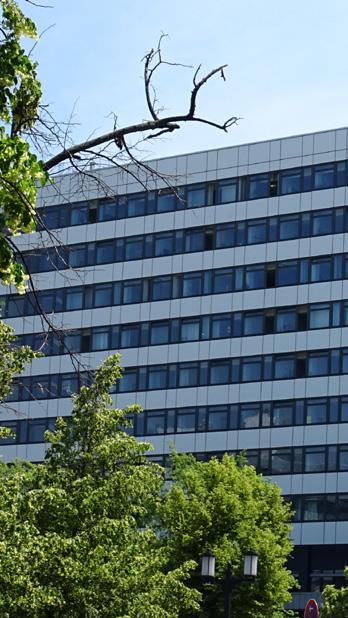
seemed most practical, and especially participant-friendly, to reduce the number of available options down to these three mentioned categories – economic benefits, government regulation, and hydroclimatic factors – each one containing two more specific items.
Before the analysis, we priorly anticipated government regulation to have the most influence on a utility’s decision to digitalize. As a public good, water is heavily regulated, for instance with respect to quality aspects, and utility companies are mostly organized as public cooperations. However, in 66% of the cases, we found that a utility company indicates economic benefits as their motivation to introduce digital technolo-
gies. Conversely, only 26% indicated government regulation to be the driving factor in digitalizing, and for a mere 8% hydroclimatic factors such as droughts or floods were the reason. In the case of the latter, especially droughts were indicated to start the digitalization of their water supply and floods with respect to wastewater management.
You pinpoint a gap between motivation to start a digital transformation and successful technology adoption. Can you comment on this?
While mainly economic factors motivate utilities to tackle their digital transformation and start such a journey, we do not find empirical evidence supporting the claim that these factors also influence the successful implementation of a digitalisation strategy. This is reflected by the fact that across all categories of driving elements, there are no significant differences in the utility digitalisation score. Hence, the progress of digital transfor-

mation cannot be attributed to these external factors.
Rather, it seems that the gap between motivations and actual technology adoption may depend on various factors that are not captured by the three drivers considered in this study. This may include, for instance, internal processes, company structure, or even individual vision, understanding, and capability of utility managers.
What recommendations would you offer to policymakers, industry stakeholders, and water utility managers aiming to leverage digital technologies for sustainable water management?
Digital technologies offer great technical potential as well as high economic value across all subdivisions of a water utility. This remains true whether they are employed as solitary solutions as part of a digitalisation initiative or are part of a greater strategically organised digital transformation. Ultimately, a full-scale digital transformation of a water utility requires an innovative mindset both at the management as well as the operational level. We deem that only by enforcing both top-down and bottom-up engagement within this context, a successful transformation can be achieved.
While digital transformation in the water utility sector is still being pioneered, we encourage water utilities to join together with tech providers to develop technical solutions fitting their specific needs and initiate close communication with regulative bodies to ensure a seamless and secure practical implementation. Such a triangular exchange will finally benefit all sides: utilities will secure water security along with reliable operations, hence, ensuring customer satisfaction; regulative bodies can warrant consumer safety; and tech providers may efficiently develop technologies that fit a utility’s requirements.
The Smart Water Survey is available at https://smartwatersurvey.com/
Artificial Intelligence (AI) technologies in the private and public sectors are increasingly dominating the overall digital transformation trend. This acceleration of interest in AI technologies has given me pause to revisit lessons learned from digital transformation strategies and value creation. I believe that the adoption of digital technologies, including AI, needs to be driven by a well-conceived business strategy to create business value.
I will start with lessons from a significant body of research on digital transformation discussed in the book The Technology Fallacy: How People Are the Real Key to Digital Transformation (Gerald C. Kane, Anh Nguyen
Phillips,Jonathan R. Copulsky and Garth R. Andrus, August 23, 2022, The MIT Press). This body of research provides valuable insights into digital transformation strategy and execution relevant to adopting digital water technologies.
The book explores the misconception that successful digital transformation solely depends on technology adoption. It argues that while technology plays a crucial role, the key to effective digital transformation lies in understanding and addressing the human aspects of change.
The authors conducted extensive research and interviews with executives from various industries to identify common challenges and misconceptions surrounding digital transformation initiatives. They found that many organizations focus too much on acquiring the latest technologies without adequately preparing their workforce or addressing cultural barriers.
The book outlines several key themes. The first one is a people-centric approach: it emphasizes the importance of prioritizing people over technology in digital transformation efforts. Organizations need to invest in developing digital skills, fostering a culture of innovation, and empowering employees to embrace change. Secondly, leadership and culture: a successful digital transformation requires strong leadership and a supportive organizational culture that encourages experimentation, risk-taking, and collaboration. Talent management is also emphasised: organizations must attract, retain, and develop talent with the necessary digital skills and capabilities to drive innovation and adaptation. Effective change management strategies are likewise essential for navigating the complexities of digital transformation and overcoming resistance to change. A final theme is continuous learning: digital transformation is an ongoing process that requires continuous learning and adaptation to stay ahead of technological advancements and market disruptions.
The human capital learnings conclude that digital transformation brings significant value to the workforce and human capital by empowering employees, enhancing their productivity, and fostering professional development. Let us explore some key aspects of the value it provides.
Skills development: digital transformation necessitates the acquisition of new digital skills and competencies. Organizations invest in training programs and re-
"Many organizations focus on acquiring the latest technologies without adequately preparing their workforce or addressing cultural barriers"
sources to upskill or reskill their workforce, enabling employees to stay relevant in a rapidly evolving digital landscape. This enhances individual employability and strengthens the overall talent pool within the organization.
Empowerment and autonomy: digital tools and technologies empower employees by providing them with access to information, resources, and decision-making capabilities. With the right digital infrastructure in place, employees can work more autonomously, collaborate across teams, and contribute to innovation and problem-solving.
Flexible work arrangements: digital transformation enables flexible work arrangements, such as remote work and flexible hours, which can enhance work-life balance and employee satisfaction. This flexibility allows employees to manage their per-
sonal and professional responsibilities better, leading to higher levels of engagement and retention.
Collaboration and communication: digital tools and platforms facilitate collaboration and communication among geographically dispersed teams. Employees can collaborate in real time, share knowledge and best practices, and work together to achieve common goals. This fosters a culture of teamwork, transparency, and innovation within the organization.
Data-driven insights: digital transformation provides employees with access to data-driven insights that can inform decision-making and improve performance. By leveraging analytics and reporting tools, employees can gain a deeper understanding of customer needs, market trends, and business performance, enabling them to make more informed decisions and drive better outcomes.
Career advancement opportunities: digital transformation creates new career advancement opportunities within organizations. As employees gain new digital skills and competencies, they become eligible for roles in emerging areas such as data analysis, digital marketing, and cybersecurity. This enables employees to pursue career paths aligned with their interests and aspirations, leading to greater job satisfaction and retention.
Employee engagement and satisfaction: by investing in digital tools and technologies that enhance productivity and streamline workflows, organizations can improve employee engagement and satisfaction. When employees have the tools they need to perform their jobs effectively, they are more likely to feel valued and motivated, leading to higher job satisfaction and retention.
In addition, the research provided in The Technology Fallacy is directly applicable to the challenges facing the water sector such as the slow speed of innovation, an aging workforce, and the need to attract talent. Specifically, the value of digital adoption includes: (1) research shows that respondents prefer to work for a digital leader; (2) digital maturing organizations attract digital talent; (3) digitally maturing organizations create an environment for learning, and (4) a lack of digital opportunities may increase attrition. By investing in the digital skills and capabilities of their workforce, organizations can position themselves for success in the digital age and create a more engaged, motivated, and resilient workforce.
As a final thought on digital transformation and value creation, I would like to point to a recent article from McKinsey published in the MIT Sloan Management Review which emphasizes the importance of using business value metrics

instead of technical metrics when evaluating AI/machine learning project success (“What Leaders Should Know About Measuring AI Project Value”, February 7, 2024).
The author states that “when evaluating ML models, data scientists focus almost entirely on technical metrics like precision, recall, and lift, a kind of predictive multiplier (in other words, how many times better than guessing does the model predict?).” The case is made that these metrics are “critically
"Digital transformation brings value to the workforce by empowering employees, enhancing productivity and fostering professional development"
insufficient” as they provide a measure of the relative performance of a predictive model, in comparison to a baseline such as random guessing, but provide no direct reading on the absolute business value of a model. Instead, the focus should be on business metrics — such as revenue, profit, savings, and number of customers acquired. These metrics relate directly to business objectives and are core to building a “bridge between business and data science teams”.
In summary, when considering digital technologies such as AI, strategy comes before the technology selection, and business metrics must be used when evaluating value creation. I believe this way we will have an improved chance of a successful implementation of digital technologies and quantifying the value of the investment.
Fredrick Royan has been with Frost & Sullivan since April 2004, initially joining as an analyst specializing in the water market. He expanded the company’s market analysis by establishing analyst teams in regions like China, South Africa, Eastern Europe, and North America, focussing on the growth opportunities in the key regional markets shaped by local policies and region-specific needs. His team has focussed on key smart water markets such as digital twins, sensors, leakage and smart water metering, and has partnered with the Smart Water Network (SWAN) Forum since its inception in 2010.
In recent years, Royan has transitioned to focus on sustainability and the circular economy: key aspects around the risks and resilience of cities and industries in the context of water, waste management and air quality, developing a “6P Framework” that encompasses policies, products, processes, people/personas, partnerships, and platforms. Appointed Chair of the Advisory Council of the SWAN Forum last month, we delved into his expertise in this interview to explore the Jal Jeevan Mission and what it means for smart water growth opportunities in India.
In 2019, the Indian government launched the Jal Jeevan Mission (JJM), an initiative to provide household tap water to every rural household in the country. What is the significance of this programme?
The Jal Jeevan Mission (JJM) is a truly unique programme not just for India but possibly globally – both on the scale of its scope and coverage as well as its data-driven approach to tackle the key issue of universal access to drinking water services for rural populations. Launched in 2019, the JJM had an overall capital outlay of about $48 billion and set out one goal – Har Ghar Jal – Water for every home – by 2024. This was to provide a functional household tap connection
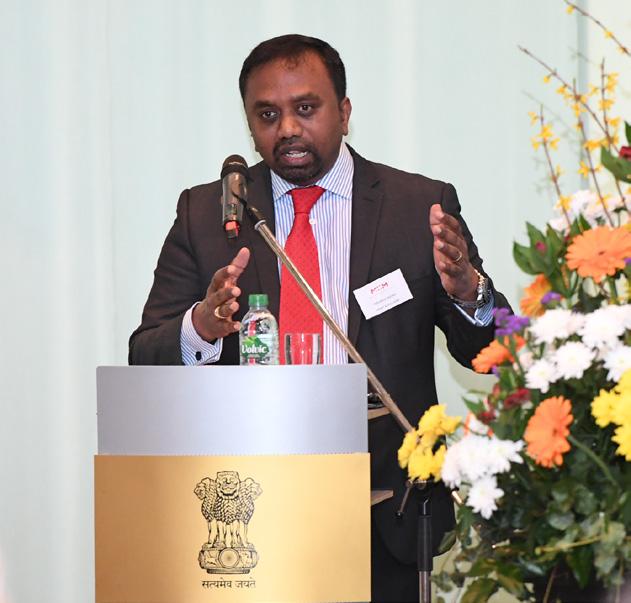
(FHTC) for every rural household in the about 600,000 villages with a cumulative population of close to 900 million and meet one of the key elements of Sustainability Development Goal (SDG) 6.
It does in a way resonate with our 6P Framework for the Future of the ESG, Sustainability & Circular Economy, as the policy specified the key requirement in terms of water quantity of 55 litres per capita per day (lpcd) and specified the water quality standards – BIS:10500. This laid the guidelines for specific products such as water quantity and quality measurement sensors as well as water sampling kits and supporting infrastructure and services.
This was to ensure the products were helpful in monitoring the key processes of water supply and water quality delivered to
the FHTC’s. Another key element of the programme has been the focus on people/ personas, where there has been a great deal of focus on training and upskilling of the local community and key stakeholders –especially women in the community – to participate in conceptualising, delivering, and managing the processes. This has also involved a great deal of partners coming together and forming an ecosystem to contribute their expertise to each element of the project. There is the Tata Trusts, involved in the initial pilots and building up the use cases; and the ministries – the Ministry of Electronics and Information Technology (MeitY) even launched campaigns and competitions encouraging local start-ups to develop and pilot their water quality and quantity monitoring solutions.

“The JJM will be instrumental in the scaling of technology and smart water solutions in India to deliver on sustainability outcomes”
The Jal Jeevan Mission (JJM) is unique given its scale as well as its data-driven approach to tackle universal access to drinking water services for rural communities in India. With a $48 billion budget and 900 million people to serve in 600,000 villages, the JJM policy is not only bringing the country closer to SDG 6 but also shaping smart water investments.
192.79 million rural households in India – the FHTC coverage has increased from 32.362 million households (16.79%) in 2019 to 144.448 million households (74.92%) in 2024.
Lastly, the JJM – being very data-driven as a policy – is also providing a platform or a dashboard with the details in terms of the progress of the programme across the rural households as well as data on water quantity and quality served at the local level. This delivers on key aspects of transparency as well as accountability and is set to even support in benchmarking of water services at the local level, so communities can learn from the successes and best practices established and maintained in the leading villages.
Can you comment on the current landscape of smart water opportunities in India, especially considering initiatives like the Jal Jeevan mission?
As per the latest data published on the JJM India portal – out of the total
With the physical infrastructure in place, we are beginning to see tenders covering a range of products and services from the integration of IoT platforms and services to the supply and installation of water quality and quantity monitoring solutions. One of the most significant contracts we have witnessed in recent months is by Ceinsys Tech based in Mumbai; they have been appointed by the Water Supply and Sanitation Department of the Govt of Maharashtra and secured a contract estimated to be about $26 million for the design and deployment of an IoT platform for the JJM projects in the state. With water being a subject governed by state governments –there will be similar opportunities as the JJM programme matures in the various states across India. One of the recent projects in the state of Karnataka delivered by RefillBot was a remote monitoring
IoT platform to measure the water quality and quantity of services across 100 villages and included the operation and maintenance services as part of the contract. There have also been a few successful use cases involving the deployment of platforms from the individual states to the national dashboard. DropbyDrop is a start-up based in Mumbai and is playing a pioneering role in democratising and making smart water solutions accessible. It has taken a leadership role in this segment and supported villages in Haryana, Rajasthan and Manipur to connect the data on water flow, pressure and water quality sensors to the national dashboard. Another exciting use case is for billing - the DropbyDrop IoT platform has been deployed in Chandhare (Alibaug), Raigad District of Maharashtra. The IoT platform now enables the local panchayat (administrative body) to automatically generate monthly water bills and in the local language.
The growth opportunities for smart water as part of JJM will also include contracts for the design and deployment of
IoT platforms as well as DaaS (Data as a Service) or/and WaaS (Water as a Service).
In addition to the JJM, one of the most significant developments has been the launch of the updated Manual on Water Supply and Treatment Systems (Drink from Tap) published by the Central Public Health and Environmental Engineering Organisation (CPHEEO) on behalf of the Govt. of India’s Ministry of Housing and Urban Affairs (MoHUA). This manual is set to have a significant impact on another water infrastructure programme called AMRUT 2.0, focussed on 4800 cities, with an overall goal to provide 24/7 water services. We expect to see a significantly increased investment in smart water solutions for deployment across the cities.
Water balance and audits, NRW management and hydraulic modelling are also emerging as use cases of smart water solutions and services in India. One of the leading start-ups that is strengthening a portfolio of projects on these topics in India is Vassar Labs. Established in 2014, in less than 10 years it has already worked on smart water projects in the states of Andhra, Tamil Nadu and Karnataka.
Smart water metering is another growth opportunity we will see growing in the coming years as we expect to see large cities such as Mumbai and Chennai set to have smart water meter rollouts; they will start with the commercial and industrial users and are expected to be later expanded to all residential consumers. Smart water metering opportunities in India will also be boosted by the specifications laid out in the recent manual published by CPHEEO, with a strong
"The JJM – being very data driven as a policy – is providing a platform or a dashboard with the details in terms of programme progress"
"With the physical infrastructure in place, we are seeing tenders covering from IoT platforms to water quality and quantity monitoring"
focus on standards for smart water meters. The upcoming tenders will also be focussing on the financial viability of the smart water metering projects and ensuring key outcomes and service line agreements (SLAs) are in place.
Lastly, we will also see growth in digital twins in the water sector in India. Vassar Labs already has a strong use case of a Digital Twin for Urban Water Management, with its aqauWISE platform deployed in a project covering over 121 urban local bodies and 35,000 miles of distribution network, supplying 5650 MLD. Another use case of a digital twin in India is by Bentley Systems with its partner Geoinfo Services, for the city of Ayodhya in Uttar Pradesh. The OpenFlows solutions of Bentley have helped the city save $1.5 million in annual operating costs and avoid 347 tonnes of carbon emissions.
From your perspective, what role can technology play in optimizing water resource management under the Jal Jeevan mission?
The JJM has been instrumental in driving the use of technology and smart water solutions, with a metric-driven approach of 55 lpcd and with a focus on processes and standards: the key has been the involvement of the people.
There are three strong benefits concerning technology solutions in water resource management under the Jal
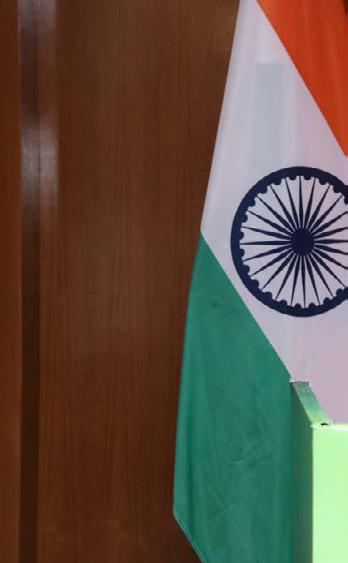
Jeevan Mission. Firstly, it has provided an opportunity for local start-ups such as DropbyDrop, Vassar Labs, RefillBot/ BharatPi, Kristnam Technologies, Smart Terra, Fluid Analytics, Digital Paani, Earthfokus, FluxGen Technologies, INDRA, Openwater, Boson Whitewater and KarIoT to build on the specifications of the policies as they develop products and business models to support in the transition of water resource management in the rural areas. The successful track record of the start-ups is helping them to scale up in India, as well as to embark on serving overseas markets with their innovative smart water solutions.
Secondly, the focus on the people of the JJM has been key in ensuring that communities and the grassroots have been engaged and now understand these technologies and are taking on the re-
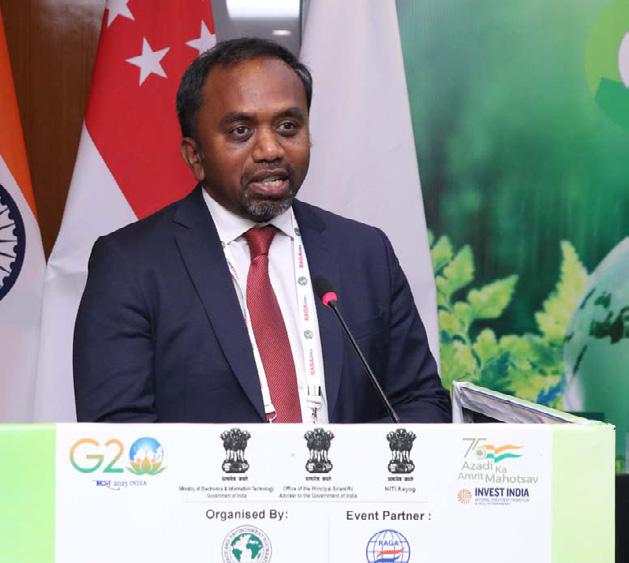
sponsibility of managing local water services. This will enhance the productivity of the individuals involved in water services, and enhance the overall economic productivity of rural areas, resulting in the delivery of an adequate and safe water supply to households.
How do you assess the readiness of Indian water service providers to adopt and integrate smart water solutions?
The building blocks for smart water solutions in India have been set, especially with the launch of the updated CPHEEO manual on Water Supply and Treatment (Drink from Tap) and the focus on technologies that can drive efficiency and resilience of water services.
One of the key elements for the integration of smart water solutions in water services will be to ensure that there
is a 24/7 water supply and also water tariffs that are able to support the investment in technology solutions to improve efficiency.
For the upcoming smart water metering rollouts in Mumbai and Chennai, we have seen the cities engaging consultants to conduct a techno-commercial due diligence of the projects. The results and recommendations of these reports will also shape the specifications in the upcoming tenders for smart water metering in the two cities. There needs to be a greater focus on standards for the technology solutions to ensure they are fit for purpose and deliver on the outcomes for the duration of the contracts. There needs to also be a focus on innovative business models such as Data-as-a-Service (DaaS), Water-as-a-Service (WaaS) and Metering-as-a-Service (MaaS) and
how these can be structured with financial support and associated service line agreements (SLAs) that can attract private participation, funding and operation of the water services under these business models.
Are there any notable success stories or case studies of smart water implementation in India that you believe can serve as models for future initiatives?
The smart water ecosystem in India can become the testbed for cost-effective and scalable smart water solutions for emerging markets as well as developed markets. The water services market in India provides scale for the financial viability of some of the digital solutions, although in some cases significant subsidies in water tariffs become a key bottleneck. Some of the success stories and case studies we have witnessed highlight the need for a Digital LITe (Less Intensive Tech) version of smart water solutions – sensors, smart water meters and digital twinsespecially in highly price-sensitive/low water tariff regions.
We have also seen the success stories of DropbyDrop that has not only deployed its IoT solution in India, but has also deployed its platform in emerging markets of Central Asia and Southeast Asia, with a strong partnership with leading smart water utilities such as K-Water from South Korea. Vassar Labs is another excellent success story having already deployed their projects in 3 states across India, which includes one of the first digital twin projects for water in India; and now they are also embarking on a project in Saudi Arabia.
As I mentioned at the beginning, with a focus on a 6P Framework that includes policies through to platforms, the JJM and its related metric-driven approach of 55 lpcd, with the national level dashboard on water quality and quantity monitoring – when completed – would be the largest smart water grid platform in the world.
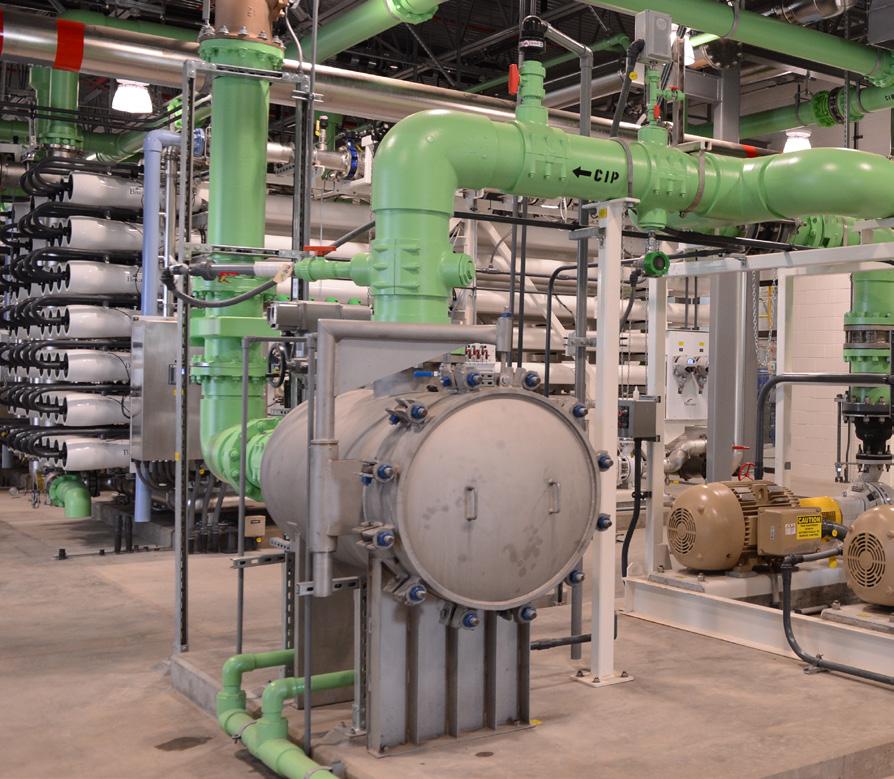
One of California’s largest retail water agencies, the Eastern Municipal Water District (EMWD) provides water, wastewater services and recycled water to nearly one million people in Riverside County, southeast of the Los Angeles metropolitan area.
The Perris II Desalter is part of EMWD’s Groundwater Reliability Plus initiative to increase the quality, quantity
and reliability of its groundwater resources, which includes water recycling, desalination, water use efficiency, water banking and more. The water district’s desalination programme enables groundwater use despite high salt levels in the basins.
Dedicated in June 2022, the Perris II Desalter uses reverse osmosis to treat brackish groundwater to deliver up to
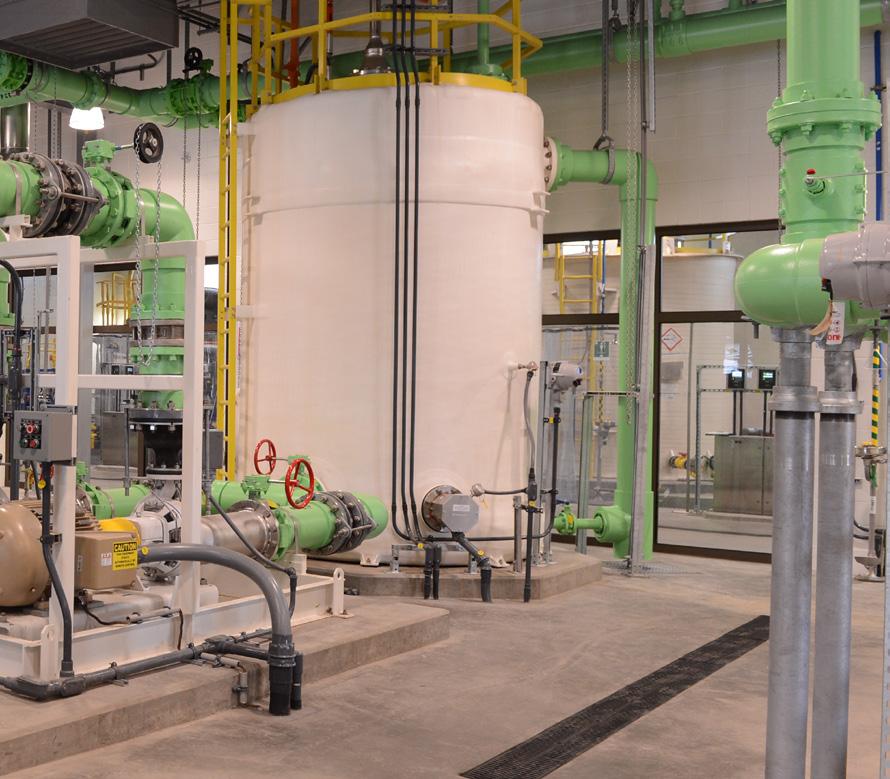
5.4 million gallons per day (mgd) of potable water. Collectively with the Perris I and Menifee facilities, it makes up the EMWD’s Desalination Complex, with a total production capacity of approximately 14 mgd of potable water – enough for more than 30,000 households annually.
The Perris II Desalter treats water from up to 14 brackish groundwater wells, each with a different water-quality
profile. Following treatment, the resulting brine concentrate from the process is discharged via the Inland Empire Brine Line into the Pacific Ocean.
The project reduces reliance on imported water to build a local, drought-resilient and cost-effective water supply. EMWD’s water supply strategy also contemplates other diversification including potential seawater desalination partnerships.
Water security is globally recognized as one of the imperatives of global development and forms a crucial part of one of the 17 Sustainable Development Goals of the UN (Goal 6: “Clean Water and Sanitation”) and is considered a necessary condition to achieve any of the other sixteen goals.
Z Blanca María Álvarez RománThe concept of Water Security has been gaining ground in the global political agenda in recent years. Samara López-Ruiz, author of an article introducing the concept of water security (“Una introducción al concepto de seguridad hídrica”, published in the journal Ensayos Militares in 2019), reflects on how the use of definitions including the word security has evolved in recent decades, transcending the limitations that previously strictly linked it to military risks and conflicts. Within this paradigm, by embracing this concept we assume that water scarcity constitutes a threat to our security and has the legitimate capacity to present us with emergencies that are both environmental and social, economic, and related to public health.
In light of this idea, one of the broadest and most updated authorized definitions is found in the article “Climate Change and Threats to Water Security: A Review” (Gelfan, A.N, 2023), which defines water security as “the capacity of a population to ensure sustainable access to adequate quantities of water of acceptable quality to sustain livelihoods, human well-being, and socioeconomic development, to ensure protection against pollution and water-related disasters,
and to preserve ecosystems in a climate of peace and political stability” (Tramblay, Y., Mimeau, L., Neppel, L., Vinet, F., and Sauquet, 2019).
Threats to water security are among the five global risks included in the 2020 Global Risks Report of the World Economic Forum. In general, threats such as floods, droughts, and others associated with water are recognized as the most significant of all potential threats posed by climate change to both society and the environment.
This same article reduces threats to water security to three main problems: water scarcity (hydrological droughts), water excess (floods), and poor freshwater quality. In addition to natural factors that influence the unequal distribution of water over the Earth’s surface, these threats worsen due to demographic growth, socioeconomic, political, and gender factors that create unequal access to freshwater, inefficient governance, and institutional problems leading to irrational policies and extensive use of water resources, etc.
Hydrological drought is the main and oldest threat, as more and more countries are showing an increase in drought and desertification, and water scarcity affects over 40% of the world’s

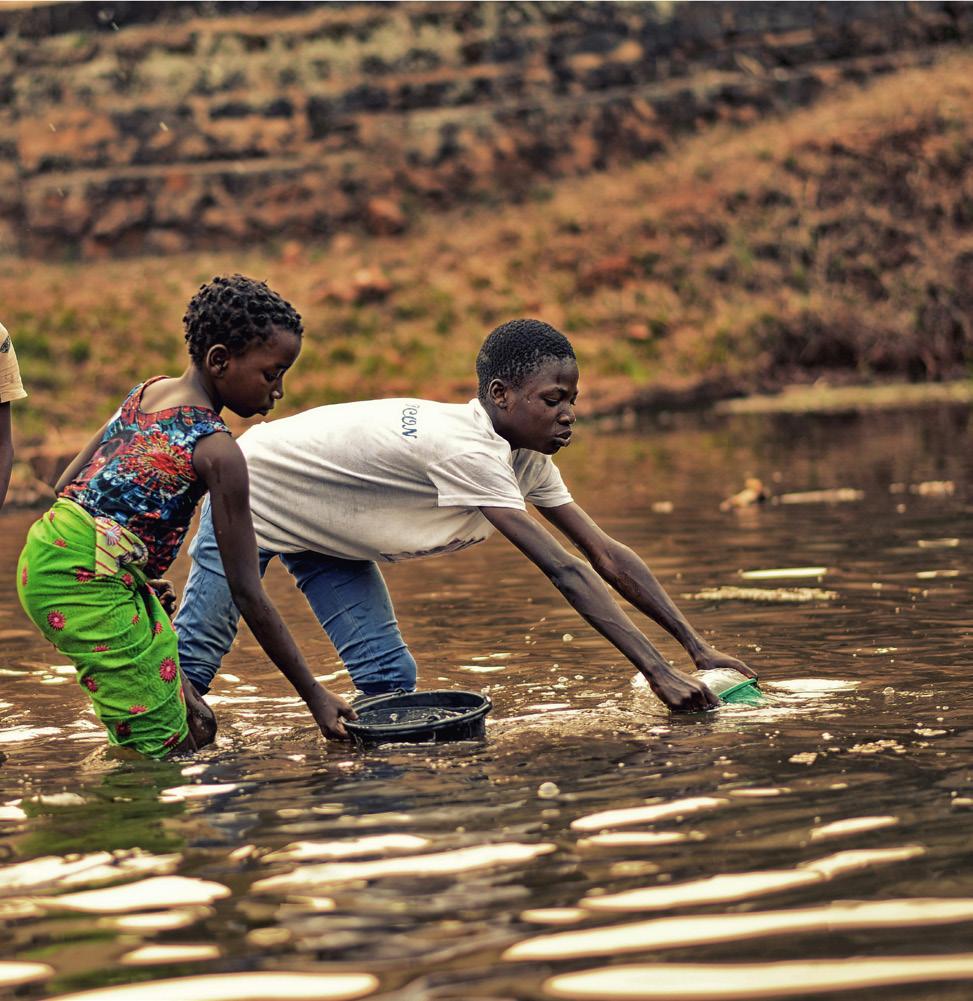
Water scarcity has the capacity to present us with emergencies that are environmental, social, economic, and related to public health
population (UN Water, 2017). The World Water Forum held in 2018 in Brasilia reported that more than 1.7 billion individuals live in river basins where water demand exceeds recharge capacity, leading to ecosystem degradation. Following current consumption patterns and population growth projections, various estimates suggest that by the year 2025, two-thirds of the global population will reside in nations facing water stress, with access to less than 1,700 m3 per capita. Additionally, according to the report “Drought in Numbers” (UN, 2022), this trend will multiply by the year 2050, affecting more than three-quarters of the world’s population.
On the other hand, overflowing abundance in the form of floods also endangers the water security of regions. According to the Development Bank of Latin America and the Caribbean (CAF), having abundant watercourses, without the necessary infrastructure, does not guarantee water security, considering it essential for “states to improve their capacity to generate regulatory, normative, and economic frameworks in favour of efficient public policies.”
Regarding poor freshwater quality, the training manual for decision makers on water security and the SDGs prepared by UNESCO in 2020 (“Manual de capacitación para tomadores de decisión: La seguridad hídrica y los Objetivos de Desarrollo Sostenible”) ensures that even in areas where water is abundant, whether surface or groundwater, it may lack the necessary quality for various uses (drinking, for
Threats to water security do not solely stem from natural phenomena or the impact of human activity and its interactions with them
Threats to water security can be boiled down to three main problems: water scarcity, water excess, and poor freshwater quality
animals, irrigation, etc.) or have suffered degradation due to human activity. For example, in many places, high levels of arsenic or salinity in aquifers exceed recommended limits for human or livestock consumption. Even for irrigation, these high concentrations can cause soil salinization, jeopardizing its productivity. On the other hand, activities such as solid and liquid waste disposal, the use of agrochemicals in agriculture, livestock farming, mining and oil activities, and transportation, among others, also pose serious pollution threats. According to the manual, to ensure water security for the population, an integrated water resources management (IWRM) approach is necessary, addressing both water supply and demand in terms of quantity and quality. This implies understanding available water volumes and quality, knowing current and future demand, optimizing water use, and regulating human activities to reduce pollution. Continuous monitoring of water quality through measurements and sampling is essential to make informed and evidence-based decisions.
Efficiency in management can override natural threats
However, threats to water security do not solely stem from natural phenomena or the impact of human activity and its interactions with them. The Global

Water Security Index (GWSI) already showed in 2015 that more than 50% of the Earth’s population lived under conditions of permanently low water security, mainly in Africa, the Middle East, South, and Southeast Asia. However, at the same time, regions with high water resourcess availability also exhibited low levels of water security, such as the northern regions of India or Bangladesh. The greatest threat, in these cases, seems to bear the stamp of political corruption and inadequate

water resource management. In this regard, the economic, social, political, and institutional characteristics of a country could be added as a fourth vector working against water security, along with the three main problems Gelfan reduces threats to in his above-mentioned article.
Furthermore, in the words of this same author, “anthropogenic climate change, supported with great confidence by experts, has rendered natural threats obsolete,” by posing a new glob-
al paradigm that intensifies both such threats and those of a political and socioeconomic nature.
Indeed, the Global Water Security 2023 Assessment report (United Nations University Institute for Water, Environment and Health - UNU INWEH) considers the lack of integrated and sustainable management of water resources, including the conservation of aquatic ecosystems, protection of water sources, and proper water use planning, to be closely related to overexploitation
and degradation of these resources. Additionally, the document also contemplates, as one of the underlying causes of water insecurity, the proliferation of
113 countries are classified as “water insecure”, while another 24 countries are in a situation of critical water insecurity
conflicts and disputes over access to and control of water resources, a factor that increases the chances of experiencing water scarcity, especially in regions whose rivers, lakes, and aquifers traverse political borders. On the other hand, the lack of adequate infrastructure and safe and accessible drinking water and sanitation services can expose communities to waterborne diseases and perpetuate poverty and inequality in water quality.
This same report presents a quantitative preliminary assessment of the state of water security globally, including 186 countries and 7.78 billion people, and employing indicators defined by the United Nations Sustainable Development Goals (SDGs). Specifically, the assessment utilizes ten vital components that influence water security:
J Drinking water
J Sanitation
J Good health
J Water quality
J Water availability
J Water value
J Water governance
J Human safety
J Economic safety
J Water resource stability
Each of these components received a score out of 10, and the overall water security score is calculated from the sum of these values. Nations are classified into different levels of water security according to their scores: 75 and above are classified as “water secure”; 65-74 is classified as “moderately secure”; 41-64 indicates a country is “insecure,” and 40 or less is considered “critically insecure.”
Water availability is unevenly distributed worldwide; this is where the use of non-conventional water sources comes into play
The findings of this assessment depict an alarming reality: most of the world’s population today lives in countries facing critical water security issues, with a significant number of people in critically insecure or insecure countries. In total, 113 countries are classified as “water insecure,” including the two most populous countries in the world, India and China. Another 24 countries are in a situation of critical water insecurity, such as Pakistan and Ethiopia. The least secure regions are located in Africa, Asia-Pacific, and Small Island Developing States (SIDS), with the latter assuming the most critical levels. These worrying figures result in approximately 4.3 billion people affected only in the Asia-Pacific region, and another 1.3 billion people across Africa.
The report proposes lines of action aimed at strengthening both infrastructure and water resource management systems, through the adoption of advanced technologies and the promotion of research. Thus, the proposals can be summarized as:
J Improve drinking water and sanitation infrastructure by investing in the construction and improvement of drinking water supply and basic sanitation systems to ensure adequate access to clean and safe water for the population.
J Promote sustainable water resource management through policies and practices of integrated water resource management that consider water availability, quality, and equitable use, as well as the conservation of aquatic ecosystems.
J Foster efficiency in water use in sectors such as agriculture, industry, and domestic spheres, thus reducing water demand and minimizing waste.
J Strengthen water governance through the development of robust legal frameworks and policies for water management at national and local levels, promoting the participation of all stakeholders and ensuring equity and transparency in water distribution and use.
J Increase investment in research and development of innovative technologies for water purification, water quality monitoring, and efficient water resource management.
J Empower local communities, focusing on empowering them to actively participate in water management and conservation, providing education, training, and resources to promote sustainable water use practices.
J Promote international collaboration through cooperation between countries to address transboundary water-related challenges, such as shared watershed management and adaptation to climate change.
While human factors, although part of the threats, contain the necessary capabilities to ensure water security, it is true that the availability of water sustainably in the long term is unevenly distributed worldwide. Furthermore, this is dangerously compromised by the impact of climate change. This is where the use of non-conventional sources, such as reuse, desalination, and rainwater harvesting, comes into play.
Desalination has seen greater development in countries facing higher water stress, such as Saudi Arabia, Israel, the United Arab Emirates, Morocco, and the United States (SWM, 2024). According to the article by Alberto del Villar García looking at the economic and environmental implications of desalination in a water security strategy (“La desalación en la estrategia de seguridad hídrica. Implicaciones económicas y ambientales”, University of Alicante, 2023), desalination, along with the reuse of regenerated waters, plays a crucial role in diversifying traditional water sources, as a sustainable and complementary alternative.
However, the author asserts that the water security provided by desalination must be accompanied by the financial sustainability of economic activities and supplies to populations sustained by these resources. This approach is related
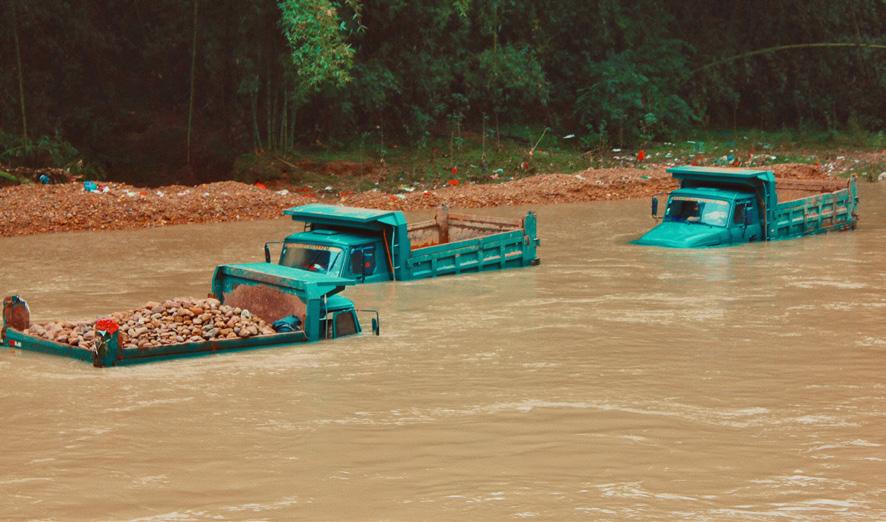
to the water-energy-food nexus, linked to both water security and food security. In this regard, addressing desalination poses challenges such as its high production costs, along with other aspects derived from the desalination process, such as technologies and energy use. However, the author advocates for desalination as an environmentally and economically viable tool to address water scarcity, as reducing the water footprint and minimizing the extraction of freshwater from limited sources would avoid long-term environmental costs. Additionally, the author also highlights the economic and community benefits, such as job creation and local development, improving the quality of life of the community, and reducing dependence on increasingly scarce freshwater sources.
Meanwhile, the global capacity for water reuse increased from 33.7 gigalitres per day (GL/d) in 2010 to 54.5
GL/d in 2015, and its technologies have reached a higher level of development in countries affected by higher water stress, such as Australia, China, Cyprus, Spain, the United States, Greece, Israel, Italy, Japan, and Singapore. However, the integration of wastewater into municipal systems remains low. In North America, for example, the annual reuse of treated wastewater represents only 3.8% of treated wastewater in the region (Lee and Jepson, 2020).
In conclusion, water security, intrinsically linked to human well-being, plays a fundamental role in the global landscape and in socioeconomic development and the preservation of vital ecosystems. From the inclusion of UN Sustainable Development Goal 6 to contemporary analyses, the urgency of addressing this issue from various perspectives is evident. Threats to water security, from water scarcity and poor quality to floods, are
exacerbated by factors such as excessive demographic growth, socioeconomic insecurity, and poor political management, as well as anthropogenic climate change.
The path to guaranteeing water security lies in a comprehensive and collaborative approach that recognizes the connections between water, energy, food, and socioeconomic development. Only through concerted and sustainable actions can we ensure a future where everyone has access to clean and safe water, an essential component for life and human development.
The water security provided by desalination must be accompanied by financial sustainability of economic activities and water supplies

REGIONAL REPRESENTATIVE OF THE INTERNATIONAL WATER MANAGEMENT INSTITUTE (IWMI) IN MENA. WATER SYSTEM LEAD OF CGIAR IN MENA
Water security has long been a pressing concern in the Middle East and North Africa (MENA) region, given its arid and semi-arid climate, rapid population growth, and socio-political complexities. Climate change poses a significant threat to water security in the MENA region, exacerbating existing challenges such as water scarcity, droughts, and desertification. Political unrest in the MENA region has added layers of complexity to the challenge of water security. Conflict, governance issues, and geopolitical tensions have significantly strained water resources management. Furthermore, internal conflicts and displacement have disrupted infrastructure and institutions, hindering effective water governance and management.
From an economic perspective, MENA is deeply interconnected with the global economy, and fluctuations in global markets can have profound implications for water security. Economic downturns can strain government budgets and hinder investment in water infrastructure and conservation efforts. Moreover, dependence on oil revenues in many MENA countries makes them particularly vulnerable to fluctuations in energy prices, further complicating efforts to ensure water security in the face of economic uncertainty.
In light of these complexities, rethinking the work towards water security in the MENA region is imperative. Traditional approaches focused on ensuring access to an adequate quantity of water must be expanded to encompass broader dimensions of security, resilience, sustainability, and equity. This requires a shift towards integrated multifaceted and pragmatic approaches that address the complex interplay of such a complex “new normal”.
One of the systemic transformations that are essential for navigating this polycrisis is adopting a Land-Water-Energy (LWE) nexus framework in the governance of these resources. By considering, holistically, the interdependencies between the scarce land, water, and energy resources, the identification of synergies and trade-offs will be possible to ensure efficient resource use.
Many geopolitical tensions and conflicts in the MENA region revolve (directly or indirectly) around competition for
scarce resources, including land, water, and energy. By addressing the root causes of resource scarcity and promoting equitable resource allocation, the LWE nexus framework can help mitigate conflicts, foster regional cooperation, and promote peacebuilding efforts. Transboundary cooperation on shared resources, such as river basins, becomes essential under the LWE nexus approach to ensure sustainable management and equitable benefits for all stakeholders.
As another transformative solution for water security in MENA, Early Warning Systems (EWS) revealed to be critical tools for enhancing preparedness and response to various shocks, including conflicts and climate extremes. Their importance lies in their ability to help in: (1) risk identification and assessment by monitoring indicators such as social tensions, environmental
"Approaches focused on access to an adequate quantity of water must expand to encompass security, resilience, sustainability, and equity"
degradation, and meteorological parameters to detect potential threats including to the water systems; and (2) timely response and preparedness by providing advance notice of impending hazards or threats.
In conclusion, as the MENA region grapples with the “new normal” characterized by political unrest, economic uncertainty, and climate vulnerability, reimagining water security is critical. By adopting a more holistic and adaptive approach such as the LWE nexus and using innovative and data-based tools such as Early Warning Systems, policymakers and all other stakeholders (including the private sector and the scientific community) can better address the multifaceted challenges facing the region and safeguard the availability and quality of water resources for future generations and the natural ecosystems.

OPINION
Rivers have shot to the forefront of British public discourse recently with a big focus on sewage discharges, the failings of our water industry and the risks poor water quality poses to river users. People’s deep love of, and concern for, the water environment is now beyond doubt. Sadly, rivers across the UK and Ireland are in a desperate state, as The Rivers Trust has demonstrated in the State of Our Rivers Report. With data and evidence at its core, the interactive report shares insights to help everyone better understand the condition of rivers, the issues facing them, and the actions needed to restore them to good health.
When functioning naturally, rivers are home for a rich array of wildlife, the source of life for the wider landscape, a place of enjoyment and reflection for human beings, and a vital component in a climate-resilient society. Right now, they are far from that. But we don’t just want this report to be a source of outrage - we want it to be a catalyst for change.
I would recommend reading our report in its entirety, but the headline statistics paint a grim picture. No single stretch of river in England or Northern Ireland is in good overall health, with a very small proportion achieving good ecological status and none achieving good chemical status. The numbers are somewhat better in Ireland, Scotland and Wales, but rivers there face their own pressures and differences in monitoring regimes make it impossible to compare data accurately across nations.
In England, agriculture and land management, the water industry, and urban pollution are found to be the main causes of failure to achieve good ecological status. Agricultural activities contribute to 62% of failures, the water industry 54%, and urban and transport activities 26%. Individual activities within these broader categories include poor nutrient or soil management on farms, the discharge of both treated and untreated sewage into waterways, abstraction, and road runoff.
Of course, data only tells part of the story, and what the data in the State of Our Rivers Report points to is that rivers are blighted by pollution, altered from their natural state and often buried underground, with many iconic species in decline, and the wider landscape facing an increasing risk of both flooding and drought. Scant monitoring, weak regulation and enforcement, a lack of consideration for water
in land management, and of course climate change are further exacerbating those pressures. This is all illustrated by our case studies on Lough Neagh’s toxic algal bloom, and the plight of Atlantic Salmon.
However, we have other case studies on our landmark Wyre Natural Flood Management project and Big River Watch campaigns which are all about solutions. Restoring rivers to a wild, healthy, natural state may be an uphill task, but we know a lot about how we can achieve it.
Everything that happens on land affects rivers. That means restoring rivers is going to require every facet of society to play its part and embrace a catchment-based approach. Our report contains lots of recommendations for individuals, communities, government and businesses, but at the centre of them is a fundamen-
"We must accept the need to work with, not against, nature in addressing not just environmental issues, but also societal problems"
tal shift in attitude: live and work with water and nature in mind. We must accept the need to work with, not against, nature in addressing not just environmental issues, but also societal problems.
That means scaling up the delivery of nature-based solutions which bring about multiple benefits for the environment and communities, developing policies and legislation that properly integrate environmental priorities into harmony with other government departments, and supporting businesses to ensure that growth does not come at the cost of the environment. Furthermore, this must be overseen by organisations at the local, regional, and national levels.
The overriding message of this report is perhaps best summarised in the words of writer and broadcaster Lucy Siegle at its launch: there is no mandate to keep damaging our rivers; the only mandate is for action – from everyone.
Goal 6 of the 2030 Agenda for Sustainable Development is to “ensure availability and sustainable management of water and sanitation for all”, and includes targets on universal access to safe drinking water (6.1) and sanitation and hygiene (6.2).
The current situation of achieving universal access to basic water and sanitation services is worrying. In order to improve, it is necessary to multiply the financial resources devoted to it and, above all, to overcome the barriers to access and improve the efficiency of spending. This article describes some of the most recent developments to improve the situation and overcome financing barriers.
The current situation of access to basic water and sanitation services - inequalities in access to water and sanitation services
For the indicators on access to safe water, sanitation and hygiene, the most up-to-date estimates indicate that the international community is not on track to achieve targets 6.1 and 6.2 of the 2030 Sustainable Development Agenda.
In 2022, 2.2 billion people still lacked safely managed drinking water services. Concerning sanitation, 3.5 billion people lacked safely managed sanitation services, including 419 million who defecated in the open. In terms of access to hygiene, and in the same reporting year, 2 billion people still lacked basic hygiene services.
To achieve universal coverage by 2030, the current rate of progress in safely managed drinking water services, safely managed sanitation services and basic hygiene services would need to increase six-fold, five-fold and three-fold, respectively.
At the UN Water Conference in March 2023, world leaders and international
agencies called for a four-fold increase in investment in basic water and sanitation services to achieve SDG 6. It has
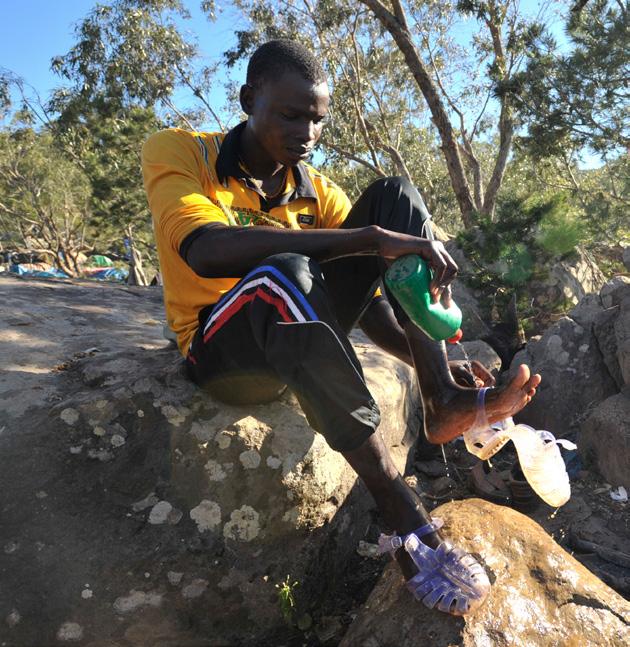
been estimated that an investment of around $114 billion per year is required by 2030 to achieve universal basic services. The greatest investment needs remain in basic sanitation services, which, according to UNICEF, would require 60 per cent of the total funds. At the recent meeting of October 2023 of the international partnership Sanitation and Water for All (SWA), UNICEF and the African Ministers’ Council on Water (AMCOW), in which 40 African Ministers participated, it was suggested that an additional $30 billion per year needs to be mobilised for Africa alone. They estimate that the lack of basic services is costing 5% of GDP, which should be a

compelling argument for Finance Ministers when allocating public funds.
And the problem is not only that there is not enough funding for the necessary investments, but that this does not always reach the most vulnerable because most of the subsidies go to investments that benefit the top 20%. In addition, lack of maintenance means that 30% of water, sanitation and hygiene (WASH) investments in Africa are not functioning as soon as one year after construction, according to the World Bank. It is important to counteract the build-do not maintain-build again cycle. UNICEF has estimated that between 10 and 40 per cent of WASH facilities that have been built in schools in Africa are not functioning.
The reality is that not only more funding is needed, but the available funding does not reach those that need it most. In relation to this, donors and funding agencies are arguing that they cannot find good projects and, on the other hand, those who need them do not have access to them. The reality is that it is difficult for the communities most in need to prepare good projects, starting with the fact that they do not have the means to connect and discuss access with the ones that decide the allocation of funds. What are then the barriers to financing basic water and sanitation services, and how are they being addressed so that they reach those who need them most?
Different causes have been pointed out at the Financing Roundtable organised by the OECD in January 2023, in preparation for the UN SDG6 Conference, and by other organisations such as UNICEF, SWA or AMCOW.
Multilateral aid linked to prioritisation by national governments
WASH investments are primarily local and are small in nature. Funds from international funding agencies are given to national governments and agreed with them. They are the ones who prioritise
actions in accordance with the Bretton Woods agreements and are the ones who guarantee the repayment of loans. However, governments have typically prioritised large populations, major infrastructure and formal rather than informal settlements.
Agencies such as the World Bank are trying to overcome this barrier through grants or loans “conditioned” on specific local results that can be tested to improve how funds are decided. On the other hand, the OECD’s Financing Roundtable has proposed that formulas for direct funding from international agencies to households, local authorities, small businesses and community organisations should be made available. But this is still not a reality at the scale needed.
The need to invest in creating the conditions for investment to take place and for finance to flow
Bilateral cooperation has the same problems as multilateral banks and, in addition, different donor countries have different priorities for the use of funds, so there are in some cases contradictory actions and overlaps. Part of the solution that has been articulated is coordination at the national or even local level, and this is often organised by the countries themselves. For this purpose, there are donor coordination tables in the different countries.
Bilateral aid is also helping to develop some innovative instruments such as the “Catalytic” funds which serve to finance the improvement of the recipients’ capacities to obtain and manage financing, to improve local financing organisations and other necessary reforms such as the establishment of tariffs
The most up-to-date estimates indicate that the international community is not on track to achieve targets
that at least ensure the maintenance of infrastructures, taking into account the ability of the most vulnerable to pay. Other instruments such as the Australian Government’s “Water for Women Fund” are innovative in the way they operate because they not only serve to fund but have developed mechanisms to support project managers in preparing funding applications and then managing them, changing funding conditions as necessary during project implementation.
Lack of capacity to repay debt
Most of the world’s needs for investment in basic water and sanitation services are found in the poorest countries which, on the other hand, have already acquired a significant debt and/or cannot repay it. Therefore, the solution proposed at the OECD Financing Roundtable is for international funds to prioritise these countries for funds that are non-repayable grants.
In addition, it has been argued that while national governments may not be able to borrow or repay loans, this need not necessarily be the case for sub-national govern-
It has been estimated that an investment of around $114 billion per year is required by 2030 to achieve universal basic services
ments or other actors. It has been proposed that formulas should be put in place to lend to municipalities, water companies, and community organisations, which could “pay back loans” and do so in collaboration with local banks that should be helped to strengthen. This would ensure that further over-indebtedness is avoided in vulnerable contexts, especially when it comes to the provision of basic services to the population, such as water and sanitation.
The OECD Financing Roundtable has proposed that the IMF establish a country-independent financing quota for water, changing budget deficit requirements, and promoting financing of water projects by domestic public banks.
Countries’ spending efficiency and prioritisation of investments in basic services
The allocation to water and sanitation investments by finance ministers in public budgets needs to be substantially increased. In Africa, $17.5 billion of the $30 billion gap is estimated to be additional country resources. Some $3.5 billion will come from public budgets and $11.5 billion will result from improved spending efficiency. There is a commitment by African countries to dedicate at least 5% of investment budgets to the water and sanitation sector and 0.5% of GDP to sanitation and hygiene programmes. To ensure this is the case, the justification of the benefits of investing in basic water and sanitation services needs to be improved.
But the big challenge is to improve the efficiency of spending. To make progress, various instruments have been developed by the World Bank, UNICEF and Sanitation and Water for All, among others. There are instruments for the evaluation of public budgets (Public Expenditure Reviews), and for the monitoring of public expenditure, there are budget guides and tools for monitoring the Water and Sanitation Accounts (Wash Accounts Trackfin). These tools include monitoring to ensure affordability of services, and to ensure that non-repayable funding is redirected to the most vulnerable.
The possibility of improving access to climate finance is one of the great hopes for improving investments in basic water and sanitation services. In this regard, the Intergovernmental Panel on Climate Change (IPCC) underlines in its most recent report that basic social services, such as water and sanitation, are vital for improving people’s well-being and supporting climate-resilient development.
However, current flows of climate finance to resilient water and sanitation services are negligible. According to a WaterAid report published in 2020, although the water sector accounts for 43% of climate finance in adaptation, this translates to only 3% of the overall climate finance pie. Moreover, of the total climate finance in water, only 10% is for basic water supply and sanitation projects, and half of this has been dedicated to large infrastructure investments that in many cases benefit only urban populations, leaving climate investment for adaptation in rural services negligible.
The Green Climate Fund (GCF) is the world’s largest fund to help developing countries reduce their greenhouse gas emissions and improve their capacity to respond to climate change, in line with the Paris Agreement. The GCF has recently developed water security guidelines that emphasise adaptation projects to harness available water resources and
to make water and sanitation infrastructure and services resilient.
The recent adoption at COP 28 in December 2023 of the Global Goal on Adaptation includes a specific target to work towards climate-resilient water supply and sanitation and access to safe and affordable drinking water for all by 2030. Having this target improves expectations and possibilities for climate finance for resilient water and sanitation services. However, not only is it important that the adaptation target has been approved, but countries must ensure that they incorporate basic water and sanitation services among their climate change adaptation priorities in National commitment documents and their National Adaptation Plans.
The OECD Financing Roundtable has developed some other proposals to improve sub-national financing. These include establishing concessional loans at below market interest rates to local
actors, although often in these countries the problem is that cost recovery is too limited to ensure repayment of loans, even if they are “cheap”. In fact, tariff revenues are insufficient even to cover operation and maintenance costs.
Some other formulas proposed to improve the subnational financial fabric include support from international organisations by providing guarantees or equity resources to local banks so that they can reach the direct recipients of the projects. The idea is to use development aid as leverage to attract more funding resources.
Overcoming the financing barriers to the achievement of Goal 6 and achieving universal access to basic water and sanitation services means meeting a number of principles listed by Sanitation and Water for All. These principles are as follows:
1) Prioritising the human rights to water and sanitation for the poorest
and most marginalised communities, although today grants are not aligned with this priority;
2) There is a need to move from emergency and ad hoc investments to planned investments to ensure that they are maintained;
3) Ensuring that international funds support the mobilisation and better management of countries’ financial resources, including tariff reforms to ensure sustainability and operation; accompanying tariff reform with tax protection systems for the most vulnerable to ensure affordability;
4) The lack of donor coordination must be avoided and international aid funds must be used to unlock national and local resources;
5) It is essential to facilitate the monitoring of financial flows to avoid corruption or inefficiencies in the use of public resources. To this end, it is vital to ensure accountability.
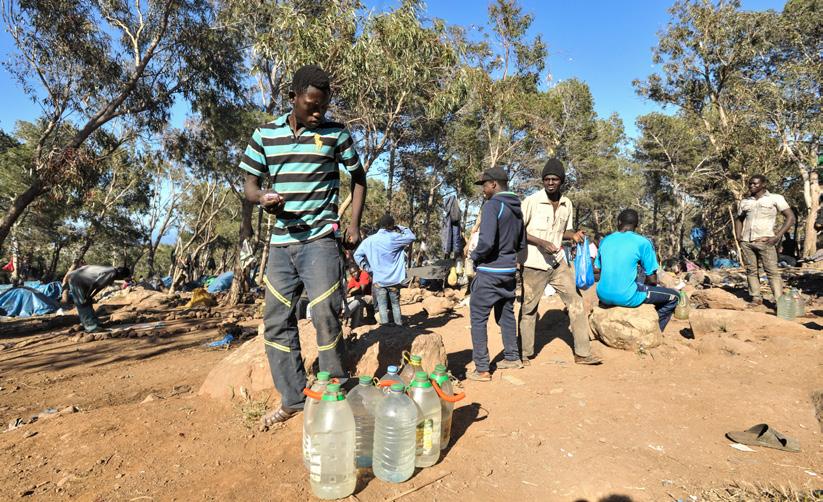
AND
SYSTEMSSTRENGTHENING
SPECIALIST, CO-THEMATIC LEAD RWSN LEAVE-NO-ONE-BEHIND THEMEThe push towards privatising water systems in Africa has raised concerns about the impact on the human right to water, the overall well-being of communities and the independence of African States.
The new commodity of the 21st century: water’s economic potential
“The group has strong ambitions on the continent to increase revenue by 50%. We have just finalised our 2020-2023 strategic plan,” explained Christophe Maquet, Senior Executive Vice President, Veolia. Water promises to be to the 21st century what oil was to the 20th century: the commodity that determines a nation’s wealth. In the sight of big capital, water is an undervalued asset and an emerging market in Africa. Following several failed privatisation contracts in the water industry, mainly in Europe, Africa is now targeted as an expansion market. However, this ambition is not without its challenges and opposition.
The assertion by Akinbode Oluwafemi, Executive Director, Corporate Accountability and Public Participation Africa (CAPPA) underscores the resistance and criticism faced by water privatisation initiatives: “No matter where you are from on this continent, the threat of water privatisation is real. It is a failed development model, Africa should not be the dumping ground for such a system.”
Water privatisation drivers threaten African’s human right to water
Governments are mandated to realise the human right to water for all their citizens and there is an industry with various water market actors that exploits their inadequacies for profits to fulfil this. As Africa’s governments are pressured to adopt water privatisation their poorest and marginalised communities pay the price.
“The world is off track to meet SDG 6, particularly in Africa despite there being enough water for everyone. Water insufficiency is often due to mismanagement, corruption, lack of appropriate institutions, bureaucratic inertia and a shortage of investment in both human capacity and physical infrastructure”, points out UN World Water Report of 2006. In this regard, Vandana Shiva asserts “the process whereby water is transformed from a public good to a tradable commodity is due to economic processes at work where private companies make large profits through high water tariffs that deny the poor their inalienable right to the substance for life.”
Privatisation is also pushed by critics of governments’ inadequacies to efficiently operate water supplies through
market-based water governance that gives water an economic value; water finance contingent on privatisation; and research and marketing voices advising governments to privatise water systems. “Sometimes, with constrained resources the private sector’s resources may be key to achieving SDG6, but its risks make many wary on handling such engagements,” acknowledges former prime minister of Senegal Aminata Touré.
"As Africa’s governments are pressured to adopt water privatisation their poorest and marginalised communities pay the price"
Water privatisation is a global failure, an organised rip-off
Where near-universal water access has been achieved, it has virtually always been through a public commitment. This rebuff is a blow to pro-water privatisation enthusiasts, advising governments to contract private companies to take over Africa’s under-resourced water systems. The thing about water privatisation is that the devil is in the details; investors are raking in profits while everyone else is paying the price and suffering. The global track record of water privatisation serves as a cautionary tale. The following voices of opposition provide lessons for Africa.
India Water Portal cites that water in Sydney was contaminated with high levels of giardia and cryptosporidium after Suez Lyonnaise des Eaux took over. In Britain, between 1989 and 1995, water and sewage bills increased by 67% while dis-
connection rates increased by 177%. Water rates in England increased by 450% while company profits soared by 692% and salaries of CEOs of private corporations increased by 708%. Water fees in France rose by 150% but the water quality declined. Buenos Aires, Tucuman (Argentina), Metro Manila (Philippines), and Atlanta (USA) have similar negative cases.
“I oppose Water (Amendment) Bill 2023 to privatise Kenya’s water sector. Some things should not be privatised because of the negative effect it has on public service delivery. It is debatable that privatising education and health sectors resulted in better services. Anytime you introduce commercial interests in essential services, the public always suffers”, said Edwin Sifuna, Senator for Nairobi.
Water privatisation in Africa’s context remains a new solution to an old problem. The legacies of colonialism and imperialism permeating Africa’s water systems cannot be ignored. It has been resisted mainly due to its impact on the poor.
In South Africa, private corporations are disconnecting thousands of poor people who cannot pay for water, decreasing social equality further. Despite high poverty levels in Mali and Niger water privatisation is a requirement for debt relief and further aid. In Ghana, after privatisation water charges increased by 95% still, one third of Ghana’s population is unserved. The promotion of Senegal and Gabon’s privatisation as a success stands in stark comparison to the reality of its failure given frequent water service disruption, environmental and public health hazards including a typhoid outbreak - and unmet commitments by private companies, hence contract discontinuation by the state, similar to Tanzania. Such contrast between the promotion of water privatisation as a success and the reality of its failure underscores the disconnect between rhetoric and lived experiences.
The case for democratic water governance as an alternative
“Direct experience with common private water management problems has persuaded communities and policymakers that the public sector is better placed to promote water rights through quality services to citizens”, advocates Satoko Kishimoto, Water Coordinator, Transnational Institute in Brussels. This is affirmed by the OECD which recommends that while private capital is significant in mobilising water finance in Africa, the private sector cannot realistically be the main financier. Governments must play a key role through mobilised grants, viable commercial loans, and public and development finance.

Therefore, Pedro Arrojo, UNOHCR Special Rapporteur on HRWS, states that “it is necessary to develop a democratic governance of water, guaranteeing human rights, environmental sustainability, transparency and participation as keys to fight bureaucratic opacity and promote efficiency.” Cornell University proposes the re-municipalisation/renationalisation of water systems; public-public partnerships (PUPs), through intermunicipal cooperation, interlocal agreements, and bulk
"Governments must play a key role in water finance in Africa through mobilised grants, viable commercial loans, public and development finance"
purchasing consortiums, can improve public services, reduce costs and retain local control.
In conclusion, the goal remains to improve safe water for all in Africa. Multinational financing institutions and private corporations can play a role in funding Africa’s water sector, but their commitment to privatisation as an ideological agenda must be reassessed. African governments in collaboration with regional inter-governmental bodies, should explore viable options to invest in our water infrastructure and prioritise the human right to water. The resistance to water privatisation, the recognition of human rights, and the call for democratic governance collectively point towards a future where water is not just a commodity but a fundamental right for all in Africa.
Motherhood in an apocalyptic scenario
In her debut novel, English novelist and poet Megan Hunter delves into the experience of new motherhood amidst an apocalyptic backdrop, where flooding plunges England into chaos: just as the narrator’s labour begins, the waters in London surge. The novel was adapted into a film with the same name in 2023.

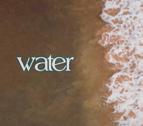


Or does it?

Changing your state of being
South African singer Tyla released the song “Water” in 2023 as the lead single of her debut studio album. The song was an instant success around the globe catapulting her into fame overnight. She is now one step closer to her dream of becoming the first global pop star from Africa.
This award-winning Japanese drama film written and directed by Ryusuke Hamaguchi in 2023 is a captivating ecological voyage underscored by a compelling moral core that explores the effects, sometimes dire, of modern civilization on the natural world and its pristine water quality.

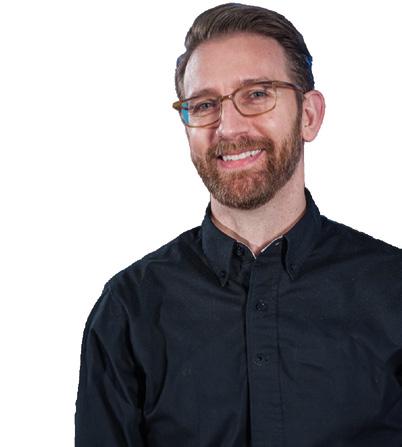

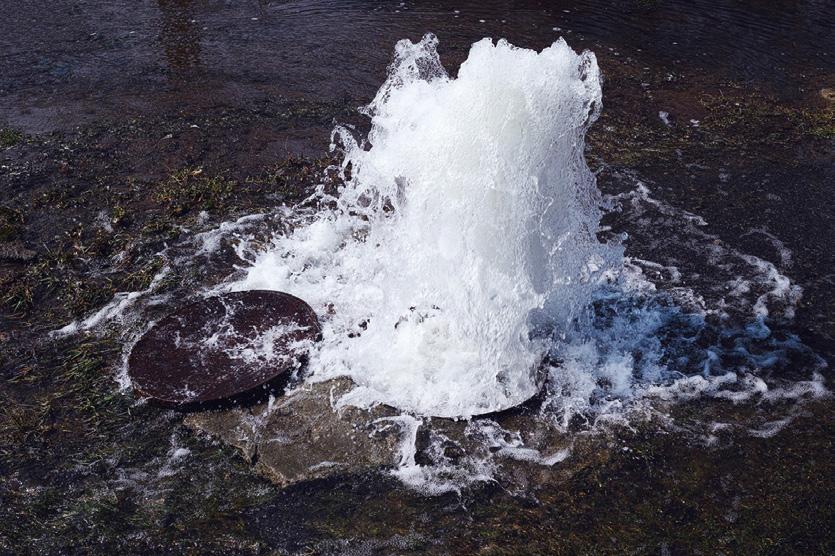
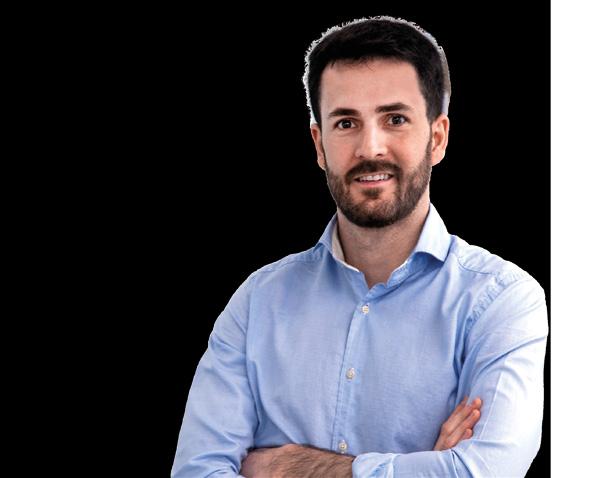
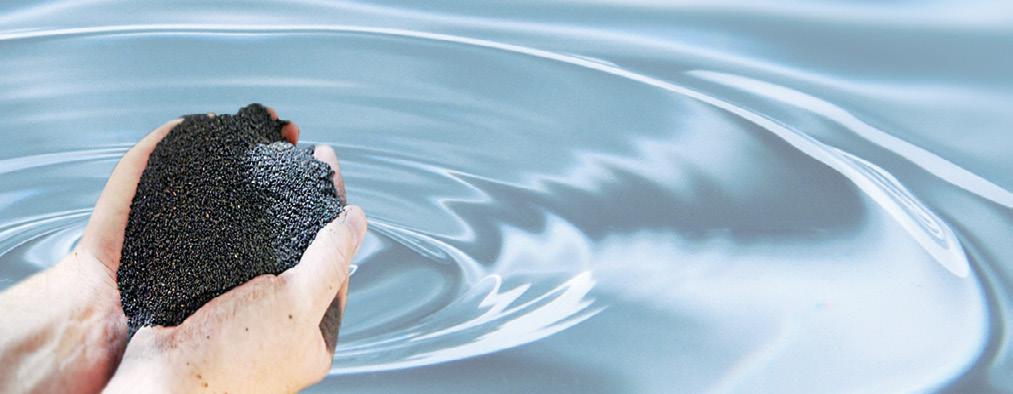
Do you want to decrease OPEX on your pre-treatment process?
Do you want to increase your capability to filter water? Do you want to increase the lifetime of the membranes?
With its unique porosity, Filtralite®, lightweight expanded clay filter media is the best filter media for pre-treatment in desalination plants using reverse osmosis.
TThe porosity will allow you to increase the retention capacity of the suspended solids from the inlet water and give more biological stable water. Your entire process will require less maintenance.
As Filtralite will catch more suspended solids, you will increase the time between the backwashes and thus reduce the energy consumption of the pre-treatment stage. Furthermore, you will also:
• Increased water production without extending existing installations
• Save on operating costs
• Reduce the amount of water taken from the environment
• Higher SS rates tolerated in inlet water
• Increase the membranes lifetime
